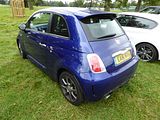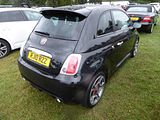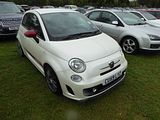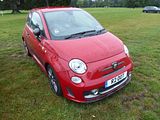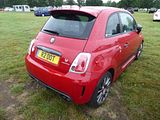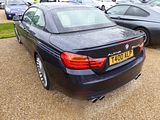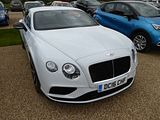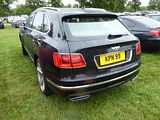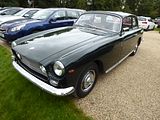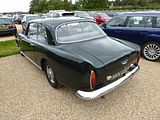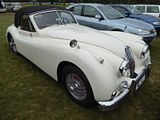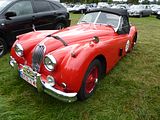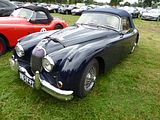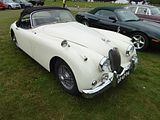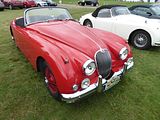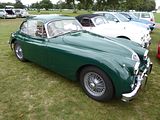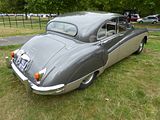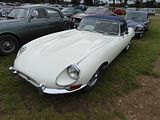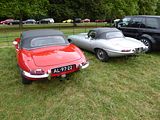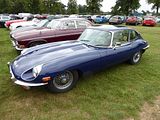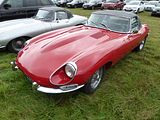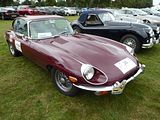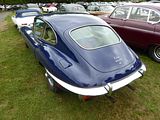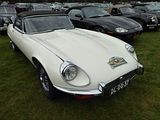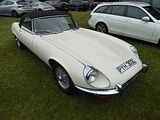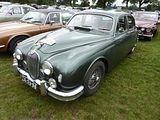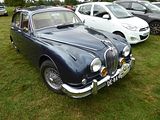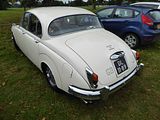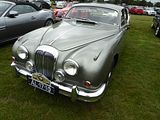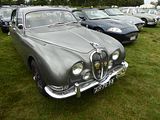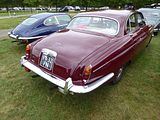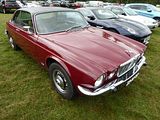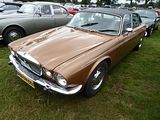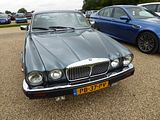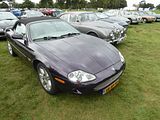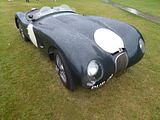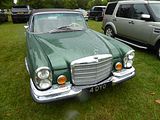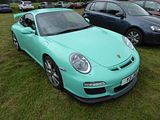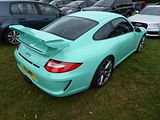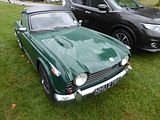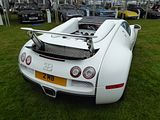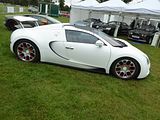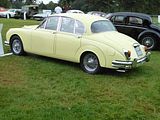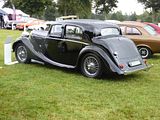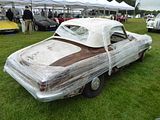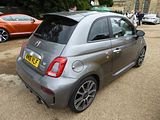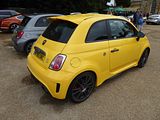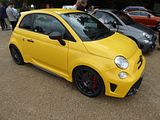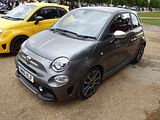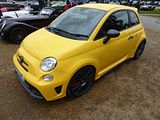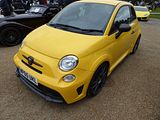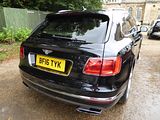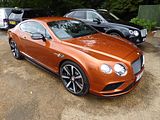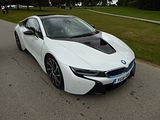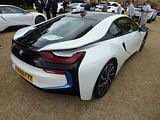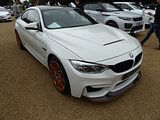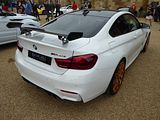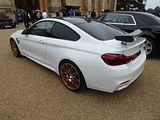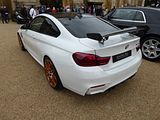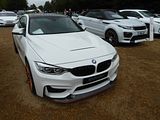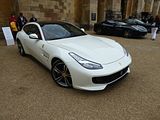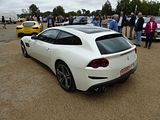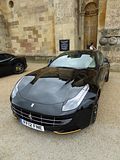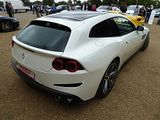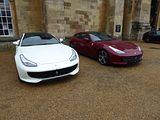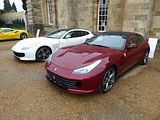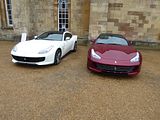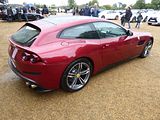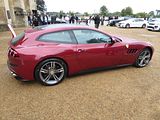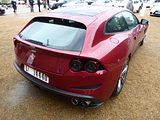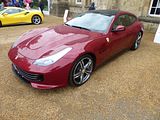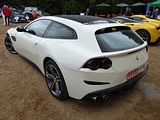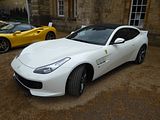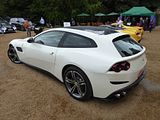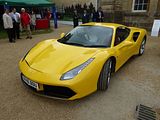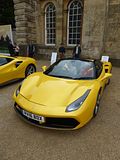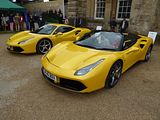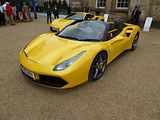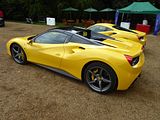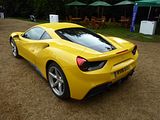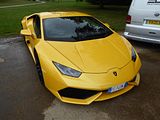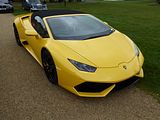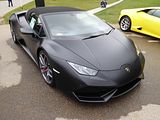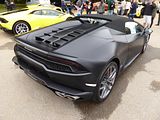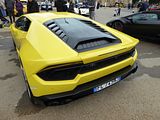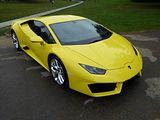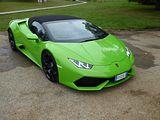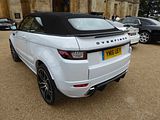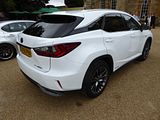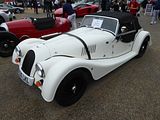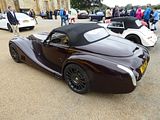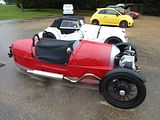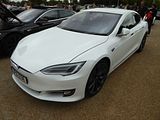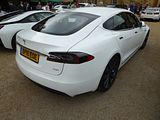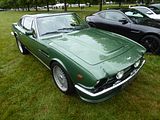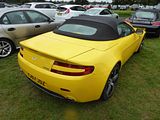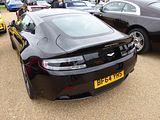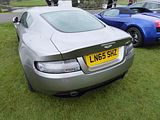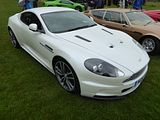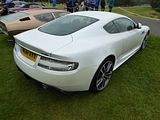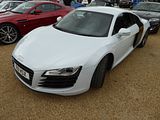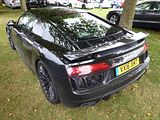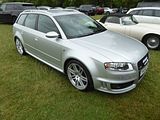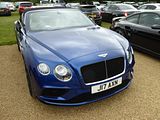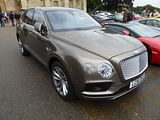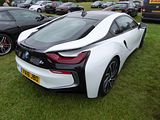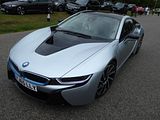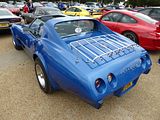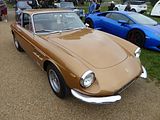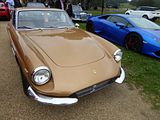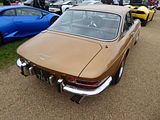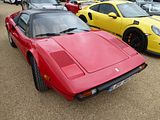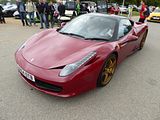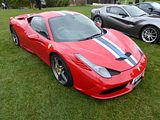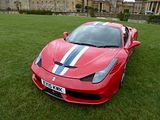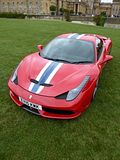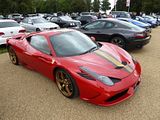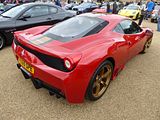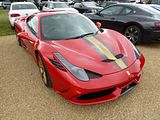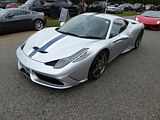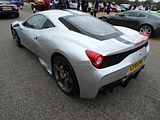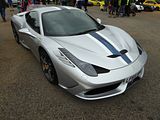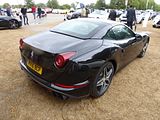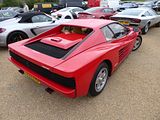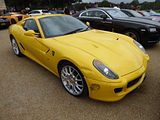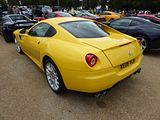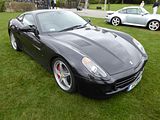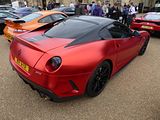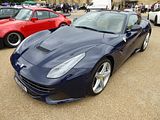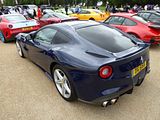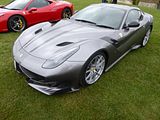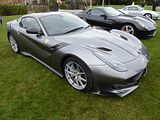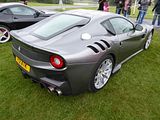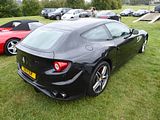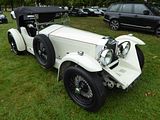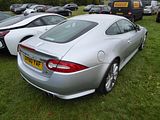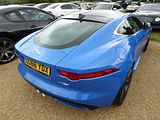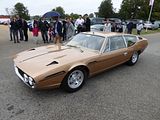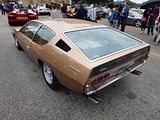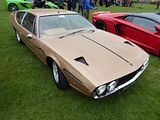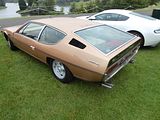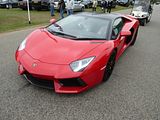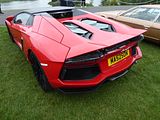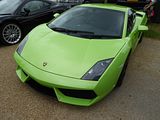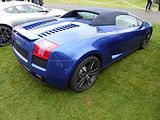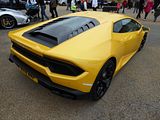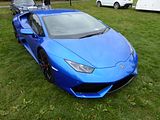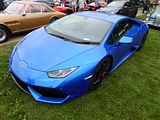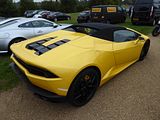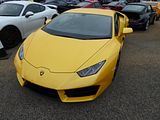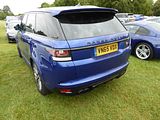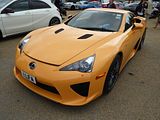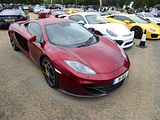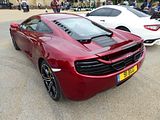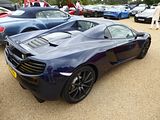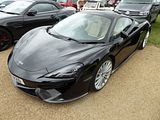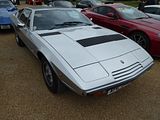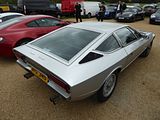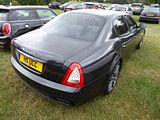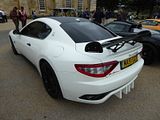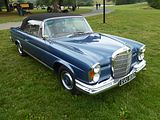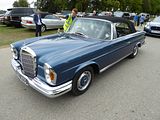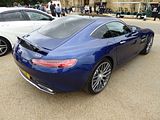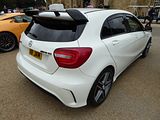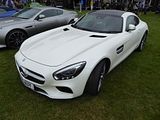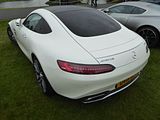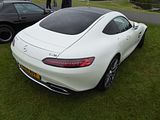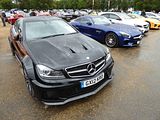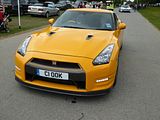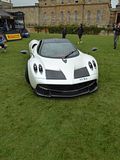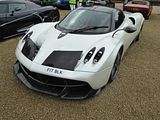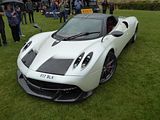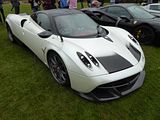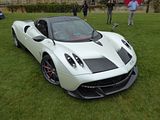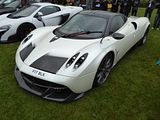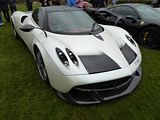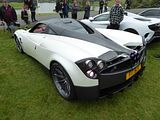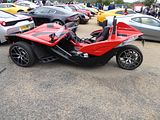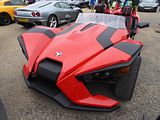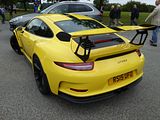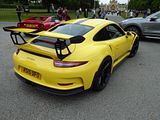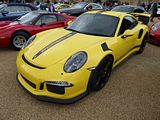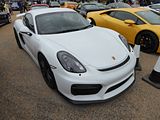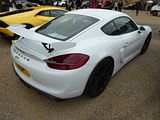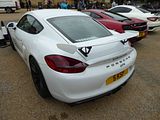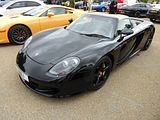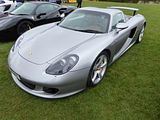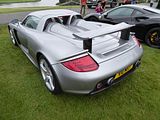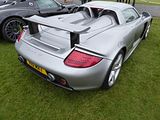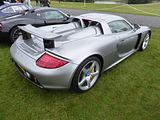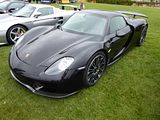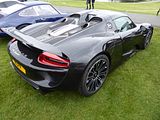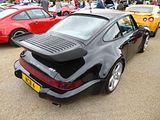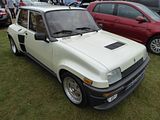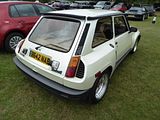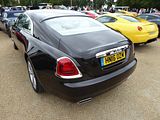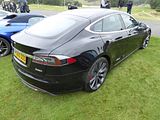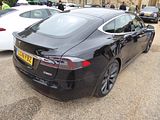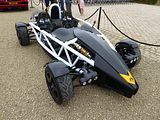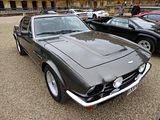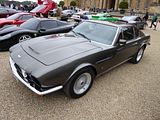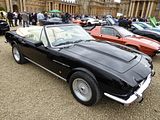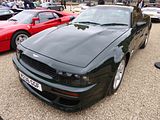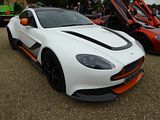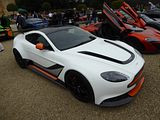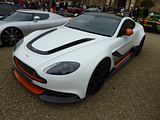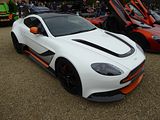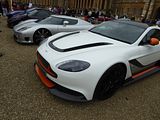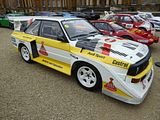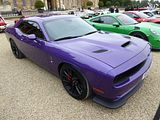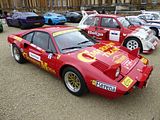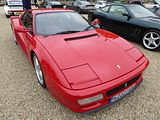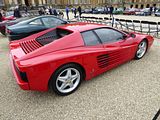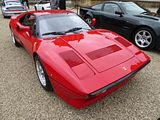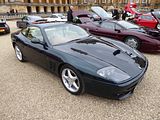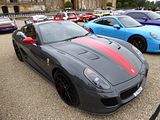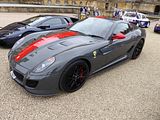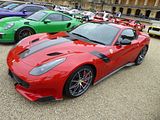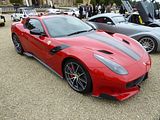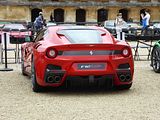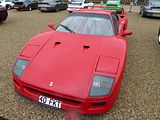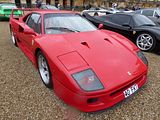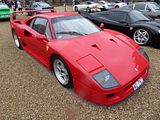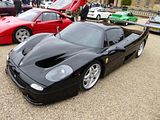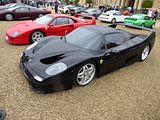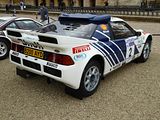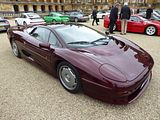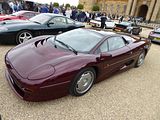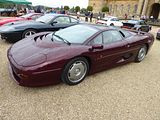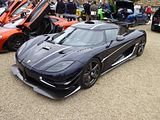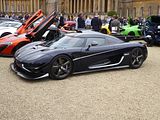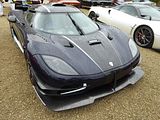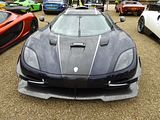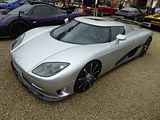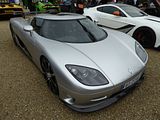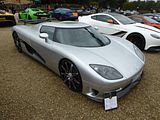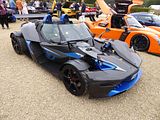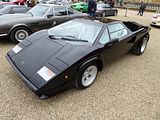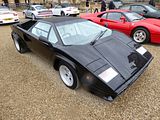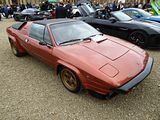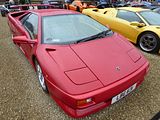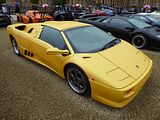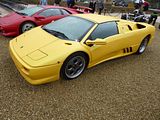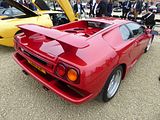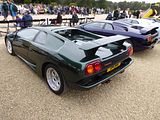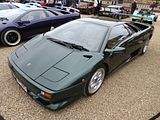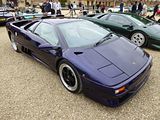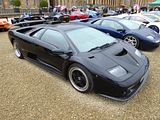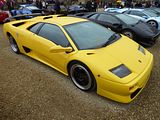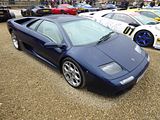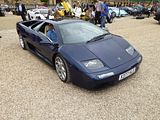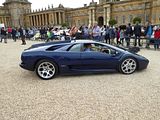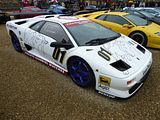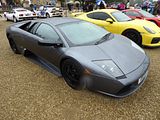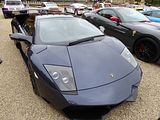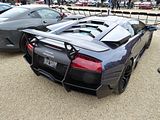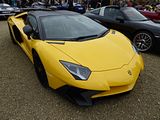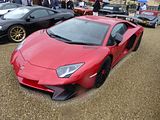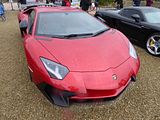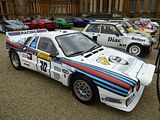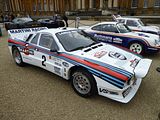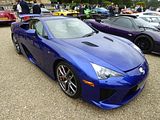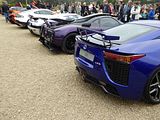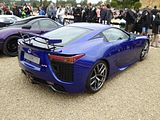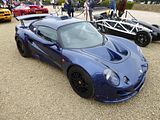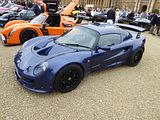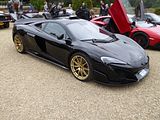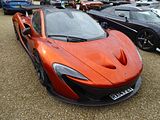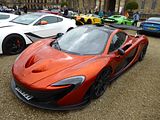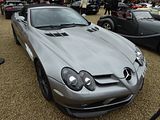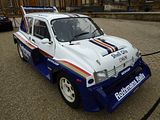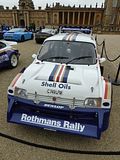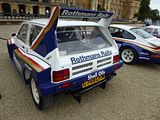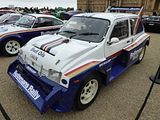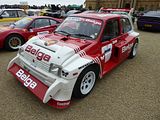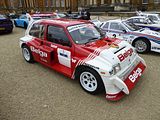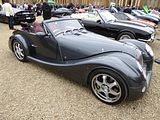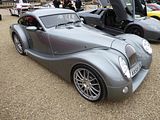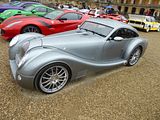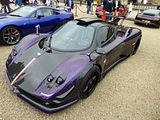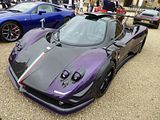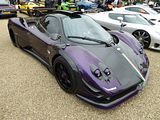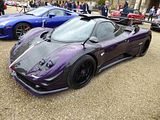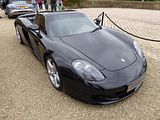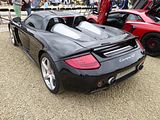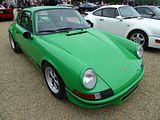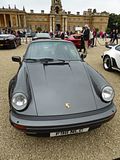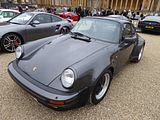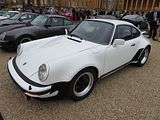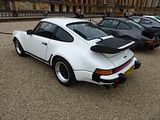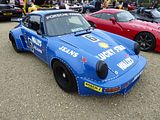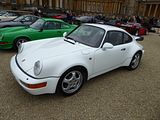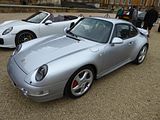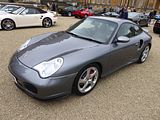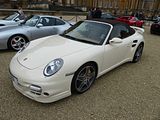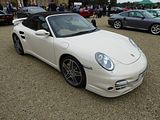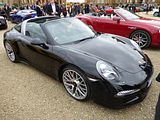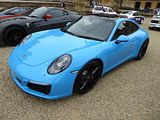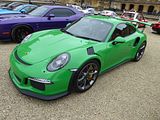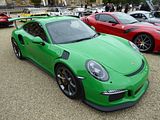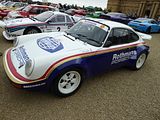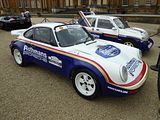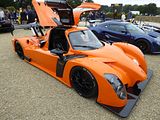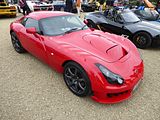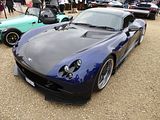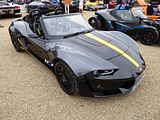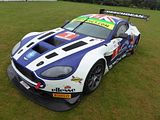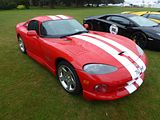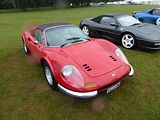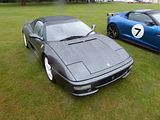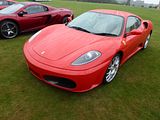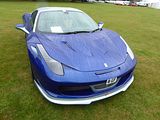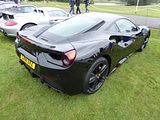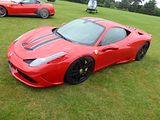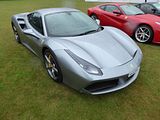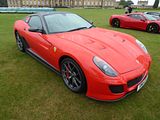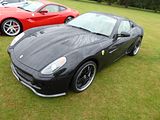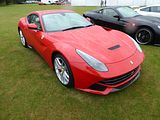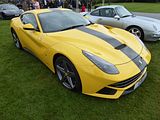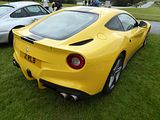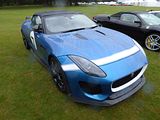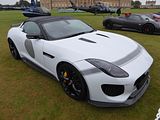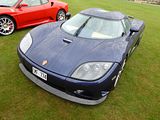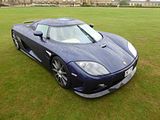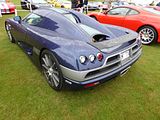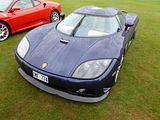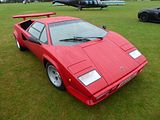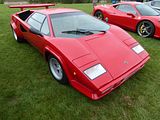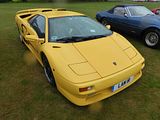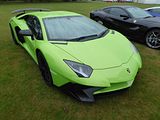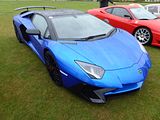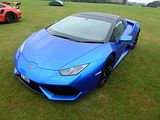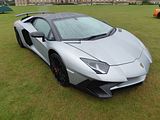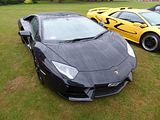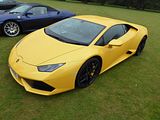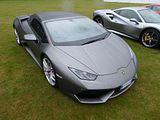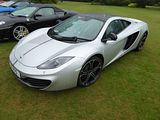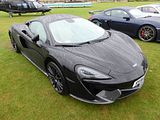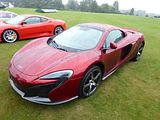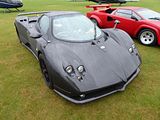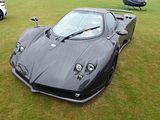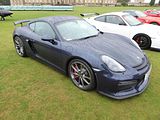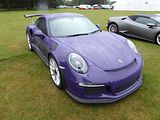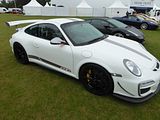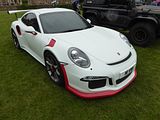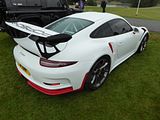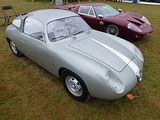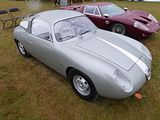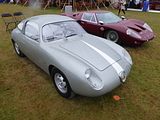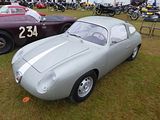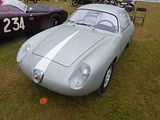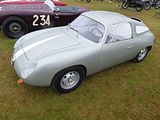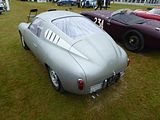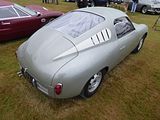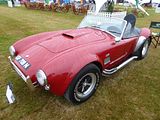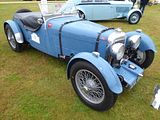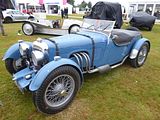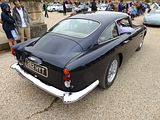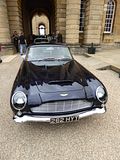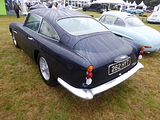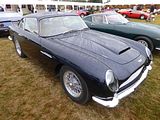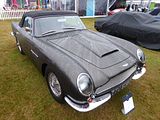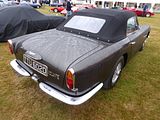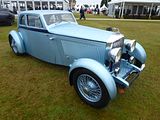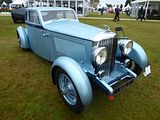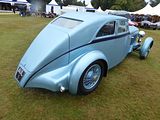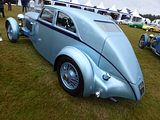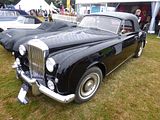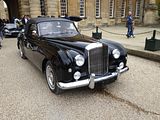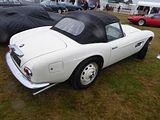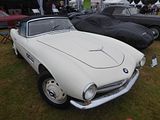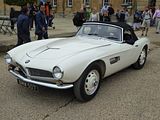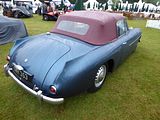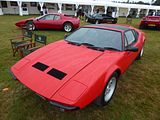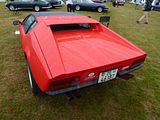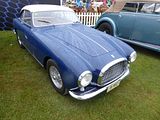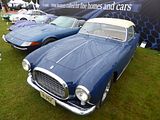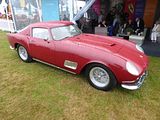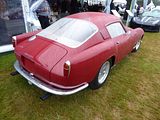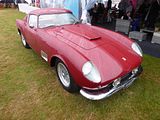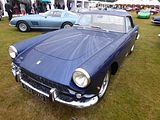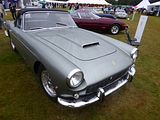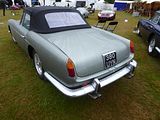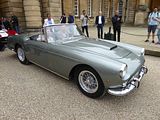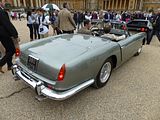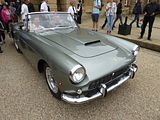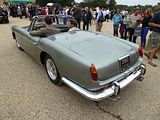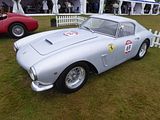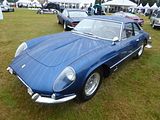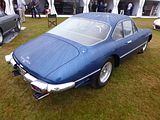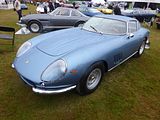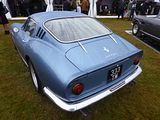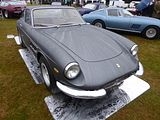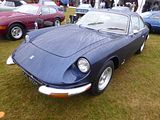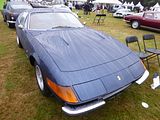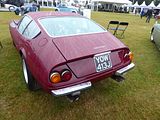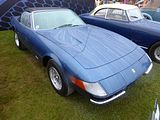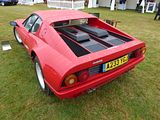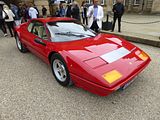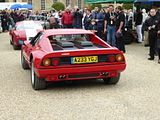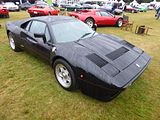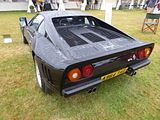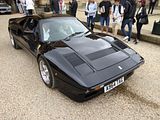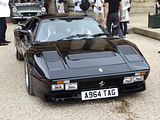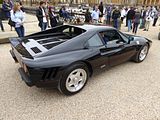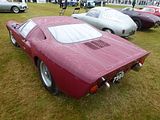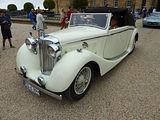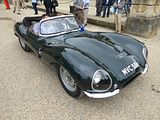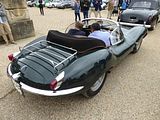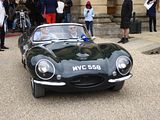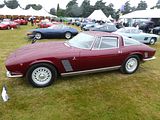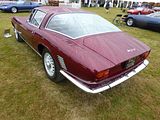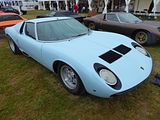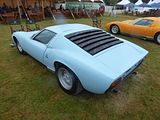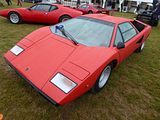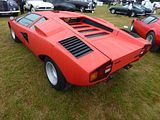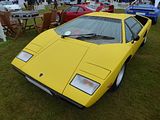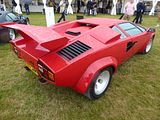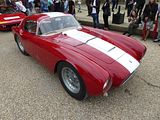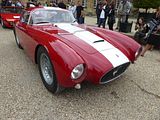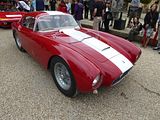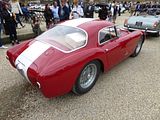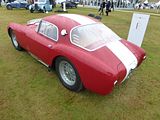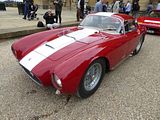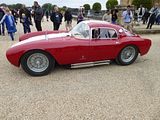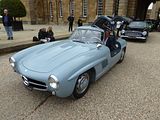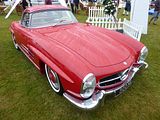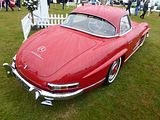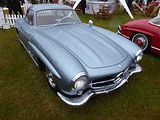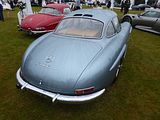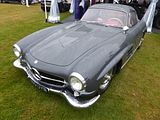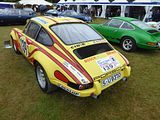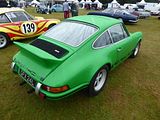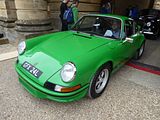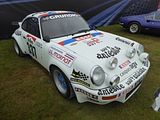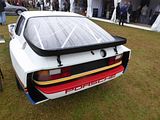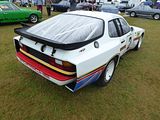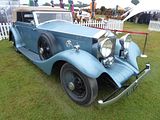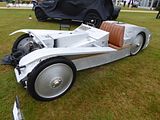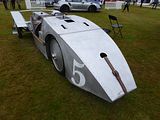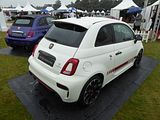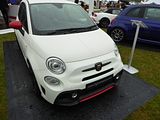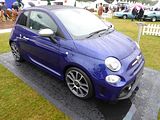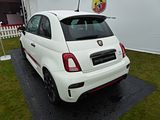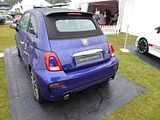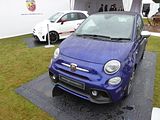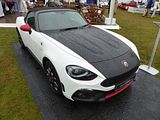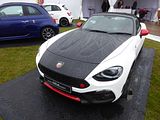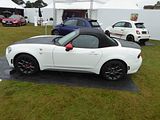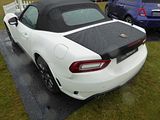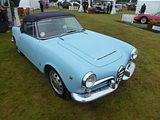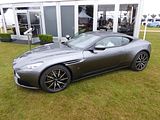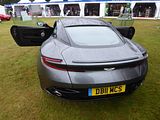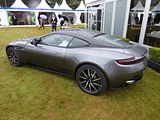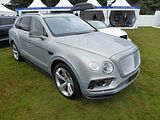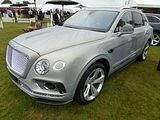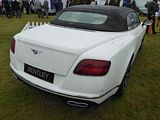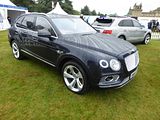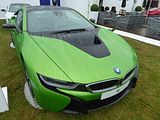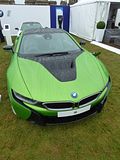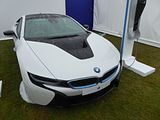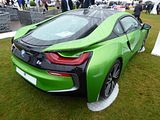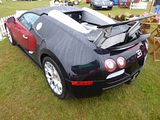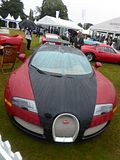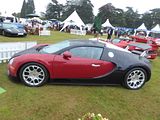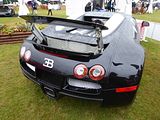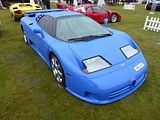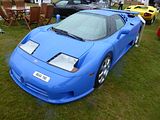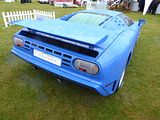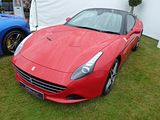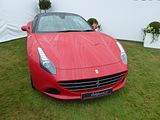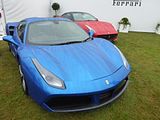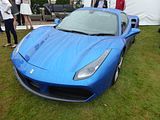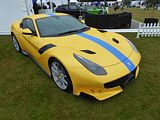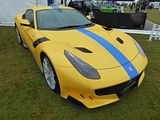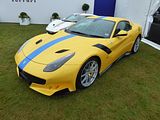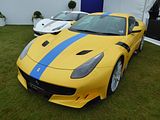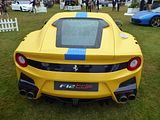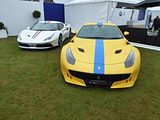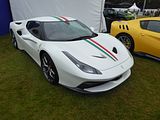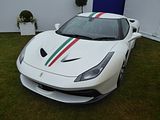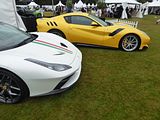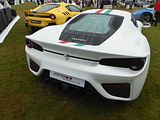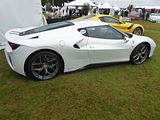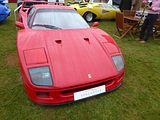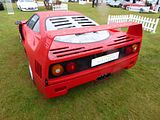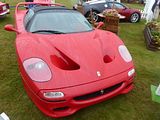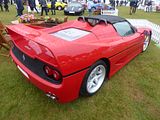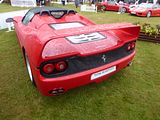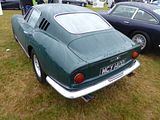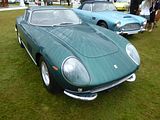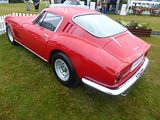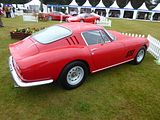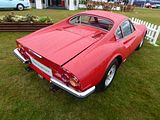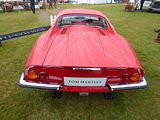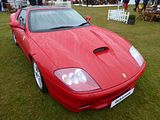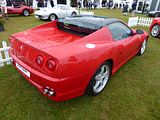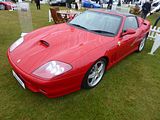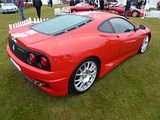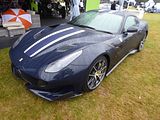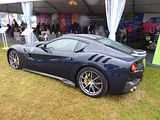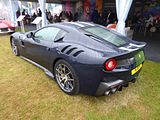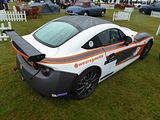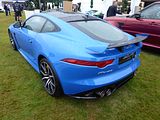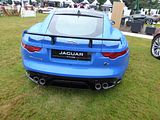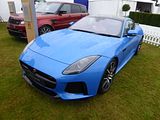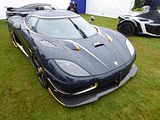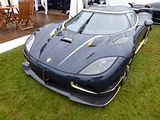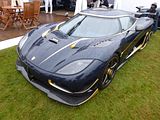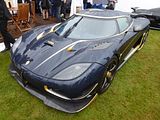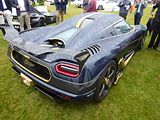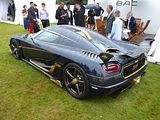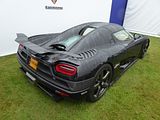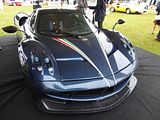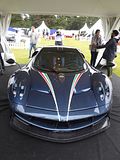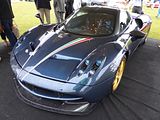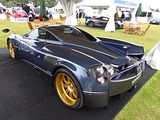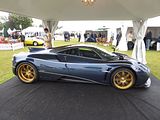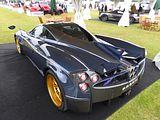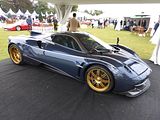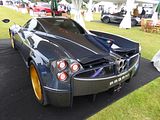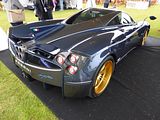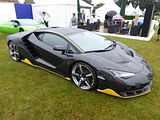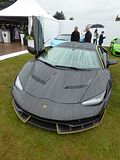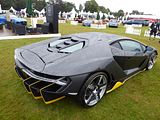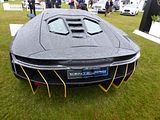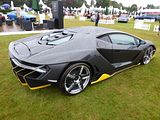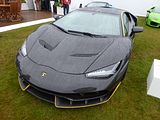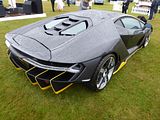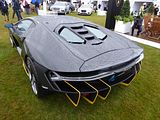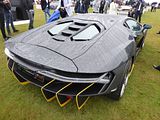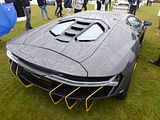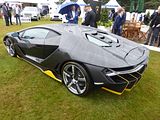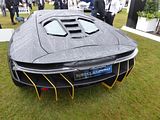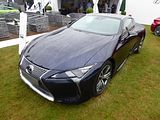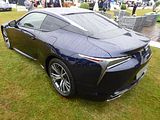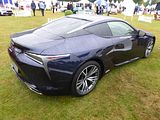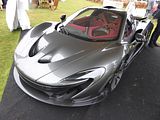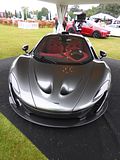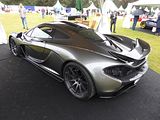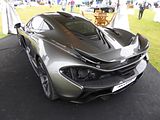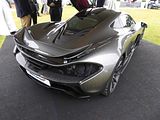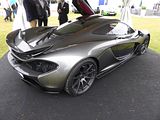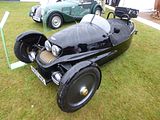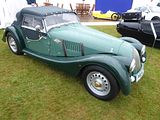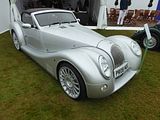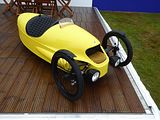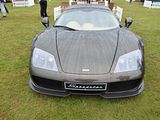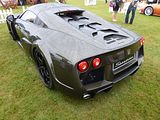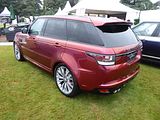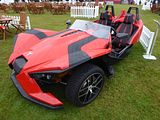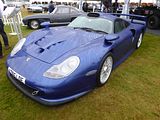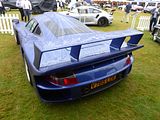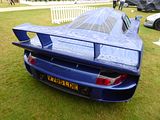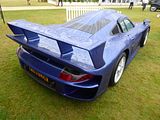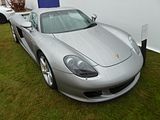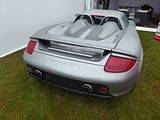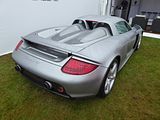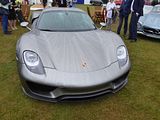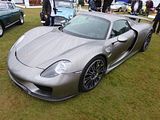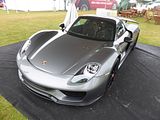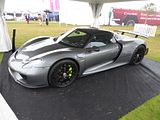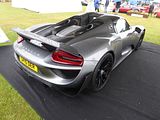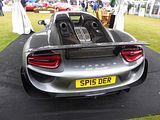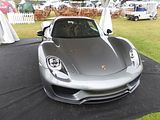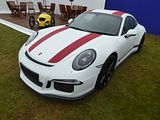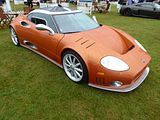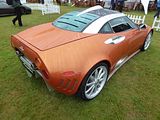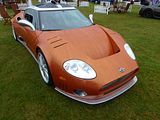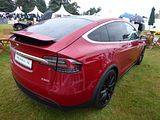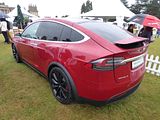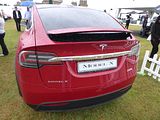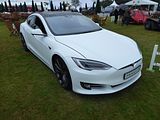The Salon Privé event has been held every year since 2006. It was conceived to be a motor show unlike any other, focusing quite deliberately on showcasing an array of the latest high end luxury and supercars, a number of pre-owned cars offered by some of the best known names in the classic motor trade, trade stands offering other luxury products, all presented in a stylish location combined with a Garden Party. A combination of the costs associated with the event, and a desire to maintain a level of exclusivity, deterring a lot of potential attendees, it has never been cheap to attend. Tickets, which include food worthy of a high restaurant and limitless drinks, including quality champagne, have always cost a three-figure sum of money. The first Salon Privé events took place at the exclusive Hurlingham Club in London, and then in 2011 it was moved to the lawns of Syon House. For the eagerly awaited 10th edition of the Salon Privé in 2015, the decision was taken to move out of London altogether, with a new venue announced as the South Lawn of Blenheim Palace, seat of the Dukes of Marlborough, and birthplace and ancestral home of Sir Winston Churchill. It proved to be an excellent choice, and so the 2016 event was also held here. One benefit of the new location is that there is a lot more space. This encouraged the organisers to think not just about what to display, but also how to grow the event, with more attendees, without losing that feeling of exclusivity and an uncrowded atmosphere. In 2015, a new much cheaper ticket was offered. Costing just £20, a fraction of the amount charged in previous years, this granted access to a part of the event. It included the very popular Supercar and Performance Car Concours and Display, held in the Great Court, as well as the surrounding combination of pre-booked super-and luxury car displays, and the area used by dealers and manufacturer to keep the test cars that they were using for demos. There was still a separate enclave, on the south lawn, which contained the core of the event, the classic concours display, dealer and manufacturer stands, as well as the food and drink. Security remained tight, and the only way you could get in, or eve see what was in this massive enclosure was with a ticket, the cheapest of which cost £115. Not cheap, but having seen what you got, or rather what you would miss out on if you just took the £20 ticket, I concluded that as a one-off indulgence, it was worth the rather steep price. There were some fabulous cars you would be unlikely to see elsewhere, and the food and drink really was top notch.
When the 2016 event was announced, it was clear that this promised to be similar – conceptually – to the 2015 one. The latest super-and hypercars would be there, and a different collection of stunning concours classics, many of them exceptionally rare or one off cars would be presented. I wanted to attend, of course. However, one look at the ticket prices caused me to think twice. Salon Privé runs for three days, starting on a Thursday, and there are differences between each of them. Thursday sees judging in the renowned Chubb Insurance Concours d’Élégance. The second days is Boodles Ladies’ Day, where the hats and outfits probably rival Ascot for their extravagance, whilst the Salon Privé Sale also takes place, whilst the top-speed Salon Privé Supercar Show constitutes the finale on the Saturday. The first two days are the most exclusive, and even more pricey, but even on the Saturday the cost had gone up a lot. However, there was the option of a ticket with entry in to the Salon Privé part of the event only in the afternoon after 2:30pm, meaning that the lunch would have been cleared away, but there would still be an afternoon tea and drinks included in the price. Although still very pricey, I decided that this was the best value option, as the cost saving over a full ticket was quite significant, and my experience of previous years had suggested that there would be plenty to look at from an early morning arrival until that 2:30 pm entry time into the Privé event. Here is what I saw during the day.
IN THE CAR PARKS
The interest starts as soon as you are parked up. A large area to the left of the main drive is allocated for general parking, and an event like this is always going to be one where plenty of the attendees bring along something interesting, and simply leave it in the main car park. That was the case here, and I meandered amongst the cars which were already parked there, as I made my way to the main entrance point. I returned during the day, too, in quest of an umbrella, the need for which became apparent when incessant rain became a feature of the event. I am sure I missed plenty, but these cars attracted my camera.
ABARTH
No fewer than four modern Abarths caught my eye in the car park, three one them on the way in, and one on the way out. Most recent was a 595 in the recently available colour of Podium Blue, which has proved to be a winner after its much awaited arrival in the showrooms, becoming the most popular colour for the car in the early months of 2016. There were also two much earlier Series 1 500 models here, one of them dating from around the same time as my first car, with a Thames, Slough, issued plate that came from the same months as mine, and finally there was another 595 Competizione that I saw on the way back to my car at the end of the day, which belongs to Owners Club enthusiast Richard Scoot, who is an inveterate attendee of events like this, with his car-mad and keen photographer son, though I had not seen either of them during the day.
ALPINA
Another current model is this Alpina B4 Convertible, a car you rarely see, as unlike AMG, whose production volumes have rocketed in recent years, Alpina only build a small number of cars a year. These cars are considered to be better in many ways than the similarly priced M3 and M4 BMWs.
ASTON MARTIN
This would prove to be the first of many Aston Martin models which I would see during the day, a recent V8 Roadster.
BENTLEY
The same comment applies to Bentley, with this Continental GT Coupe and the newly released Bentayga in the main car park just the beginning of what would turn out to be a lot of examples of the Crewe marque that I would see during the day.
BRISTOL
This is a Bristol 410, the fourth series of Chrysler V8-engined models from British manufacturer Bristol Cars. It was the last Bristol to use the 5.2-litre engine originally found in the Bristol 407. With the 410, Bristol aimed for a more aerodynamic approach than that found on their previous five series dating back to the 405. The styling improvements were relatively minor but every one of them was aimed to make for a more curved appearance. The most noteworthy change was that the front headlamps were fully faired into the wings of the car rather than protruding outwards as on previous models. As in every Bristol saloon since the 404, a compartment accessed via a hinged panel between the front of the driver’s door and the rear of the front wheel arch housed the battery, fuse panel, windscreen wiper motor and brake servos. A similar panel on the other side of the car housed the spare wheel and jack. There were also 15 inch wheels as against the 16 inch size found on previous Bristols, and the disc braking system dating back to the 406 was revised for the first time since then, with a greatly updated system of braking circuits being introduced. Internally, Bristol, like Chrysler before them, by then had felt that the safety problems of push-button automatic transmission were too difficult to counter and thus they shifted to a more conventional lever mounted between the two front seats. 82 of them were made between 1968 and 1969 before the model was replaced by the broadly similar 411.
JAGUAR and DAIMLER
There was a large presence of historic Jaguar and Daimler models here, all of them sporting Dutch registration plates. Clearly a club outing, and what an event to include in a long distance excursion!
Oldest of the cars was the still stunning XK120. First of the series of XK Jaguar sports car, the XK120 was launched in open two-seater form at the 1948 London Motor Show, a testbed and show car for the new Jaguar XK engine. The display car was the first prototype, chassis number 670001. It looked almost identical to the production cars except that the straight outer pillars of its windscreen would be curved on the production version. The roadster caused a sensation, which persuaded Jaguar founder and design boss William Lyons to put it into production. Beginning in 1948, the first 242 cars wore wood-framed open 2-seater bodies with aluminium panels. Production switched to the 112 lb heavier all-steel in early 1950. The “120” in the name referred to the aluminium car’s 120 mph top speed, which was faster with the windscreen removed. This made it the world’s fastest production car at the time of its launch. Indeed, on 30 May 1949, on the empty Ostend-Jabbeke motorway in Belgium, a prototype XK120 timed by the officials of the Royal Automobile Club of Belgium achieved an average of runs in opposing directions of 132.6 mph with the windscreen replaced by just one small aeroscreen and a catalogued alternative top gear ratio, and 135 mph with a passenger-side tonneau cover in place. In 1950 and 1951, at a banked oval track in France, XK120 roadsters averaged over 100 mph for 24 hours and over 130 mph for an hour, and in 1952 a fixed-head coupé took numerous world records for speed and distance when it averaged 100 mph for a week. Roadsters were also successful in racing and rallying. The first production roadster, chassis number 670003, was delivered to Clark Gable in 1949. The XK120 was ultimately available in two open versions, first as an open 2-seater described in the US market as the roadster (and designated OTS, for open two-seater, in America), and from 1953 as a drophead coupé (DHC); as well as a closed, or fixed head coupé (FHC) from 1951. A smaller-engined version with 2-litres and 4 cylinders, intended for the UK market, was cancelled prior to production.
The XK140 was the successor to the XK120, with a number of useful changes and upgrades over the earlier car which included more interior space, improved brakes, rack and pinion steering, increased suspension travel, and telescopic shock absorbers instead of the older lever arm design. The XK140 was introduced in late 1954 and sold as a 1955 model. Exterior changes that distinguished it from the XK120 included more substantial front and rear bumpers with overriders, and flashing turn signals (operated by a switch on the dash) above the front bumper. The grille remained the same size but became a one-piece cast unit with fewer, and broader, vertical bar, making it easy to tell an XK140 apart from an XK120. The Jaguar badge was incorporated into the grille surround. A chrome trim strip ran along the centre of the bonnet and boot lid. An emblem on the boot lid contained the words “Winner Le Mans 1951–3”. The interior was made more comfortable for taller drivers by moving the engine, firewall and dash forward to give 3 inches more legroom. Two 6-volt batteries, one in each front wing were fitted to the Fixed Head Coupe, but Drop Heads and the Open Two Seater had a single 12-volt battery. This was installed in the front wing on the passenger side (e.g. In the left wing on right hand drive cars and in the right wing on left hand drive). The XK140 was powered by the Jaguar XK engine with the Special Equipment modifications from the XK120, which raised the specified power by 10 bhp to 190 bhp gross at 5500 rpm, as standard. The C-Type cylinder head, carried over from the XK120 catalogue, and producing 210 bhp at 5750 rpm, was optional equipment. When fitted with the C-type head, 2-inch sand-cast H8 carburettors, heavier torsion bars and twin exhaust pipes, the car was designated XK140 SE in the UK and XK140 MC in North America. In 1956 the XK140 became the first Jaguar sports car to be offered with automatic transmission. As with the XK120, wire wheels and dual exhausts were options, and most XK140s imported into the United States had wire wheels. Cars with the standard disc wheels had spats over the rear wheel opening. When leaving the factory it originally fitted either 6.00 × 16 inch crossply tyres or you could specify 185VR16 Pirelli Cinturato CA67 as a radial option on either 16 × 5K½ solid wheels or 16 × 5K (special equipment) wire wheels. The Roadster (designated OTS – Open Two Seater – in America) had a light canvas top that folded out of sight behind the seats. The interior was trimmed in leather and leatherette, including the dash. Like the XK120 Roadster, the XK140 version had removable canvas and plastic side curtains on light alloy barchetta-type doors, and a tonneau cover. The door tops and scuttle panel were cut back by two inches compared to the XK120, to allow a more modern positioning of the steering wheel. The angle of the front face of the doors (A-Post) was changed from 45 degrees to 90 degrees, to make access easier. The Drophead Coupé (DHC) had a bulkier lined canvas top that lowered onto the body behind the seats, a fixed windscreen integral with the body (the Roadster’s screen was removable), wind-up side windows, and a small rear seat. It also had a walnut-veneered dashboard and door cappings. The Fixed Head Coupé (FHC) shared the DHC’s interior trim and rear seat. The prototype Fixed Head Coupe retained the XK120 Fixed Head roof-profile, with the front wings and doors the same as the Drophead. In production, the roof was lengthened with the screen being placed further forward, shorter front wings, and longer doors. This resulted in more interior space, and more legroom. The XK140 was replaced by the XK150 in March 1957.
Although bearing a family resemblance to the earlier XK120 and XK140, the XK150, launched in the spring of 1957, was radically revised. A one-piece windscreen replaced the split screen, and the wing line no longer dropped so deeply at the doors. The widened bonnet opened down to the wings, and on the Roadster the windscreen frame was moved back 4 inches to make the bonnet longer. The XK140’s walnut dashboard was replaced by one trimmed in leather. On the early Drophead Coupés, the aluminium centre dash panel, which was discontinued after June 1958, had an X pattern engraving similar to the early 3.8 E-Type. Thinner doors gave more interior space. On the front parking lights, which were located atop the wings, a little red light reminded the driver the lights were on. Suspension and chassis were very similar to the XK140, and steering was by rack and pinion; power steering was not offered. The standard engine, the similar to the XK140, but with an new “B” type cylinder head, was the 3.4 litre DOHC Jaguar straight-6 rated at 180 SAE bhp at 5750 rpm but most cars were fitted with the SE engine whose modified cylinder head (B type) and larger exhaust valves boosted the power to 210 SAE bhp at 5500 rpm. Twin 1.75-inch (44 mm) SU HD6 carburettors were fitted. While the first XK150s were slower than their predecessors, the deficit was corrected in the spring of 1958 with a 3.4-litre “S” engine whose three 2-inch SU HD8 carburettors and straight-port cylinder head increased power to a claimed 250 SAE bhp. For 1960, the 3.4 litre engine was bored to 3.8 litres, rating this option at 220 hp in standard tune or 265 hp in “S” form. A 3.8 litre 150S could top 135 mph and go from 0–60 mph in around 7.0 seconds. Fuel economy was 18mpg. Four-wheel Dunlop 12 in disc brakes appeared for the first time although it was theoretically possible to order a car with drums. When leaving the factory the car originally fitted either 6.00 × 16 inch Dunlop Road Speed tyres as standard, or you could specify 185VR16 Pirelli Cinturato CA67 as a radial option on either 16 × 5K½ solid wheels (basic models) or 16 × 5K wire wheels. Production ended in October 1960, and totalled 2265 Roadsters, 4445 Fixed Head Coupés and 2672 Drophead Coupés.
Jaguar launched the Mark IX in 1959, as a replacement for the previous Mark VIII. The early versions were identical in exterior appearance to the Mark VIII except for the addition of a chrome “Mk IX” badge to the boot lid. Later versions had a larger tail-lamp assembly with the addition of an amber section for traffic indication, visually similar to the tail-lights of the smaller Mark 2 Jaguar sedan. By the time the Mark IX reached the market, it was quite an old design, as it was based on the Mark VII which had been first seen in 1950. The Mark VII chassis came from the even earlier Jaguar Mark V but whilst the wheelbase remained the same at 10 feet, the new model’s body looked more streamlined, with integrated headlights and mudguards, a two-piece windscreen, and longer rear overhang. As on the Mark V, the rear wheels were partially covered by removable spats. Whereas the Mark V had a prewar engine originally developed by the Standard Motor Company, the Mark VII was powered by the newly developed XK engine, which had first been seen in the 1948 XK120, with the 3442 cc straight-six providing 160 bhp, the same as in the XK120. Published performance figures for the Mark VII were based on the standard 8:1 compression ratio, but as this was unsuitable for the UK market’s low-octane Pool petrol, an engine with a lower compression ratio of 7:1 engine was optional. British motoring magazines tested the car’s performance with the higher compression ratio, using the Ostend to Brussels autoroute in Belgium, where 80 octane fuel was available. In 1952, The Motor recorded a top speed of 101 mph, 0–60 mph in 13.7 seconds and returned 17.6 miles per imperial gallon. These were impressive figures for the time, and were one reason why the car was popular in motorsport as well as on the road. When the car was being developed Jaguar thought it would find most of its customers overseas, mainly because UK car tax at that time penalised buyers of larger-engined cars. However it went into production just as Britain’s postwar economic austerity began to ease, and in 1951 the car’s enthusiastic reception in both the British and American markets prompted Jaguar to relocate production to larger premises, at the Browns Lane plant, which had been built for wartime production as a shadow factory and was now available for immediate use. By the time the Mark VII was upgraded to M specification in 1954, 20,908 had been produced. Launched at the London Motor Show in October 1954, the Mark VII M continued with the same capacity and 8:1 compression ratio, uprated to 190 bhp. A four-speed manual gearbox was standard, while the Borg Warner automatic, introduced in 1953 and hitherto available only on exported Mark VIIs, now became optional for British buyers. Distinguishing the Mark VII M from its predecessor, circular grilles over the horns were installed below the headlights in place of the former integrated auxiliary lamps, which were moved slightly further apart and mounted on the bumper. Both bumpers now wrapped further around the sides of the car. In 1956, with the advent of the Suez Crisis Britain anticipated fuel rationing, and bubble cars appeared on the streets. Jaguar switched focus to their smaller saloons (the Mark I 2.4 had been introduced in 1955), and neither the Mark VII M nor any of its increasingly powerful but fuel-thirsty successors would match the production volumes of the original Jaguar Mark VII. Nevertheless, before it was superseded by the Mark VIII, the Mark VII M achieved 10,061 sales during its two-year production run. The Mark VII was succeeded by the Mark VIII i 1956, and although this looked very similar, there were plenty of detailed differences, The interior fittings were more luxurious than those of the Mark VII. Distinguishing visually between the models is facilitated by changes to the front grille, the driving or fog lamps being moved from the front panel to the horizontal panel between bumper and front panel, larger rear lamps and most obviously a curved chrome trim strip below the waistline which allowed the factory to offer a variety of two-tone paint schemes. In addition the new car had rear spats that were cut back to display more of the rear wheels and featured a one-piece slightly curved windscreen, where the Mark VII had incorporated a two-piece front screen of flat glass. Just 6227 examples were made before the introduction of the Mark IX. The new car had a larger 3.8 litre 190 bhp version of the XK engine Standard transmission was a four-speed manual system: options included overdrive, but most cars were built with a Borg Warner three-speed automatic box. The Mark IX was the first production Jaguar to offer four-wheel servo-assisted Dunlop disc brakes and recirculating ball power steering, which were now standard equipment. The brake system included a vacuum reserve tank to preserve braking in the event that the engine stalled. On models with automatic transmission, the brakes were equipped with an electromagnetic valve that maintained brake pressure at rest when the brake pedal was released to prevent the car from rolling back on an incline, hence its name “Hill Holder”. The Hill Holder was often troublesome (failing to release the brakes when the accelerator was depressed) and was disconnected on most cars without ill effect. The power steering was driven by a Hobourn-Eaton pump, operating at 600-650 psi. It was attached to the back of the generator and allowed the steering to be geared up to 3.5 turns lock-to-lock as against the 4.5 turns for the Mark VII and VIII models. The sunshine roof became a standard fitting for the UK market. The interior was in the same luxurious mode with extensive use of leather, walnut wood trim and deep pile carpet. A range of single and duo-tone paint schemes was offered. 10,009 examples of the Mark IX were made before its replacement in 1961 by the lower and more contemporary-styled Mark X.
Jaguar launched 2 new models in 1961. One was the gargantuan Mark X, which replaced the elderly Mark IX at the top of the saloon car range, but it is the other one which is better remembered and loved even now, more than 50 years after stunning the world at the 1961 Geneva Show. That car, of course, is the famous E Type, considered by many to be Sir William Lyons’ greatest achievement. Not only did the car have stop-you-in-your-tracks gorgeous styling, but it had explosive performance (even if the 150 mph that was achieved in The Autocar’s Road Test is now known to have been with a little “help”), but it was the price that amazed people more than anything else. Whilst out of reach for most people, who could barely afford any new car, it was massively cheaper than contemporary Aston Martins and Ferraris, its market rivals. It was not perfect, though, and over the coming years, Jaguar made constant improvements. A 2+2 model joined the initial range of Roadster and Coupe, and more powerful and larger engines came when the 3.8 litre was enlarged to 4.2 litres, before more significant styling changes came with the 1967 Series 2 and the 1971 Series 3, where new front end treatments and lights were a consequence of legislative demands of the E Type’s most important market, America. There were several examples here of the Series 1 and 2 cars.
One of the most loved Jaguars of all time, both when it was new, and still now, is the Mark 2 saloon. Many will tell you that it is not the 3 Series BMW that “invented” the “compact sports saloon” car class, but this model, which dates back to 1959. A thorough revision of the small Jaguar saloon that had joined the range in 1955, the Mark 2 was notable in that it was the first car to use the Arabic numeral in its name, as opposed to the Roman numerals of the larger Jaguar models. At launch, the earlier model which had hitherto been known by its engine size was christened the Mark 1. Although clearly based on that car, the updated car looked significantly different, with an increase of 18% in cabin glass area greatly improving visibility. The car was re-engineered above the waistline. Slender front pillars allowed a wider windscreen and the rear window almost wrapped around to the enlarged side windows now with the familiar Jaguar D-shape above the back door and fully chromed frames for all the side windows. The radiator grille was amended and larger side, tail and fog lamps repositioned. Inside a new heating system was fitted and ducted to the rear compartment (although still notoriously ineffective). There was an improved instrument layout that became standard for all Jaguar cars until the XJ Series II of 1973. As well as the familiar 2.4 and 3.4 litre engines, what made this car particularly special was that it was also offered with the potent 220 bhp 3.8 litre unit that was fitted to the XK150 and which would later see service in the E Type. This gave the car a 0 – 60 time of around 8.5 seconds and a top speed of 125 mph. No wonder that the Mark 2 became popular as a get-away car for the criminal fraternity, and to keep up with and catch them, many police forces bought the car as well. With revised suspension and standard four wheel disc brakes, the car was effective on the track, taking plenty of class wins when new, and it is still popular in historic racing circles today. The quickest and most successful private entries came from John Coombs, a man with significant race experience who operated a large Jaguar dealership in Guildford. Coombs would undertake modifications to meet the demands of his customers, so not all the cars that he worked on are the same. Jaguar replaced the Mark 2 with simplified and slightly more cheaply finished 240 and 340 models, as an interim measure until an all-new model was ready to take over from them. The 3.8 litre disappeared from the range at this time, but in the 7 years it had been in production, it had been the best seller of the range, with around 30,000 cars produced, as compared to 28,666 of the 3.4 litre and 25,741 of the 2.4 litre model.
Launched late in 1962, the Daimler V8 Saloon was essentially a rebadged Jaguar Mark 2 fitted with Daimler’s 2.5-litre 142 bhp V8 engine and drive-train, a Daimler fluted grille and rear number plate surround, distinctive wheel trims, badges, and interior details including a split-bench front seat from the Jaguar Mark 1 and a black enamel steering wheel. Special interior and exterior colours were specified. Most cars were fitted with power-assisted steering but it was optional. Automatic transmission was standard; manual, with or without overdrive, became an option in 1967. The 2.5 V8 was the first Jaguar designed car to have the Daimler badge. A casual observer, though not its driver, might mistake it for a Jaguar Mark 2. The Daimler’s stance on the road was noticeably different from a Mark 2. In April 1964 the Borg-Warner Type 35 automatic transmission was replaced by a D1/D2 type, also by Borg-Warner. A manual transmission, with or without an overdrive unit usable with the top gear, became available on British 2.5 V8 saloon in February 1967 and on export versions the following month. Cars optioned with the overdrive had the original 4.55:1 final drive ratio. In October 1967, there was a minor face-lift and re-labelling of the car to V8-250. It differed only in relatively small details: “slimline” bumpers and over-riders (shared with the Jaguar 240/340 relabelled at the same time), negative-earth electrical system, an alternator instead of a dynamo and twin air cleaners, one for each carburettor. Other new features included padding over the instrument panel, padded door cappings and ventilated leather upholstery, reclinable split-bench front seats and a heated rear window. Power steering and overdrive were optional extras. Jaguar replaced its range of saloons—the 240, the 340, the 420, and the 420G—with the XJ6 at the end of 1968. The company launched the XJ6-based Daimler Sovereign the following year to replace the Daimler saloons—the 240-based V8-250 and the 420-based Sovereign. Henceforth all new Daimlers would be re-badged Jaguars with no engineering links to the pre-1960 Daimlers.
There was also an example of the S Type here. Having made 2 significant new car launches in 1961 at the top of the range, with the gargantuan Mark X and the E Type, for their next new model, Jaguar turned their attention lower down, believing that the Mark 2, based on design which had first launched in 1955 would need updating to keep it competitive. Sir William Lyons believed that the car would need to adopt some of the innovations that had been seen on the Mark X and the E Type, such as Jaguar’s new independent rear suspension and the triple SU carburettor version of the 3.8-litre XK engine Accordingly work started on a call which was codenamed “Utah Mk III”, (the Mark 2 having been “Utah Mk II”) and which made its public debut as the S Type. Both time and budget were limited, so rather than being an all new car, the S Type was a major redevelopment of the Mark 2. It used a mid-scale version of the Mark X independent rear suspension to replace the Mark 2’s live rear axle and featured revised styling, with the changes more obvious at the back with a longer tail giving more boot space. rear bodywork, with only minor changes to the front and a slightly flattened roofline, which is one reason why a lot of people have trouble distinguishing the car from its smaller brother. A more luxurious interior was fitted, with greater use of burr walnut and leather than was to be found in the Mark 2 The S Type was available with either 3.4 or 3.8-litre XK engines but only in twin carburettor form because the triple carburettor setup would not fit into what was essentially still the Mark 2 engine bay. By the time of the S Type’s release in 1963, the Mark 2 was still selling strongly, despite its age, whereas the Mark X was selling less well than had been hoped, especially in its intended market of the USA, so Sir William decided to retain all three models in the Jaguar range concurrently. Sales of the S Type were relatively modest throughout its 6 year production life, with 9928 of the 3.4 litre and 15.065 of the 3.8 litre cars made.
When the time came to replace the Mark IX, Jaguar adopted a completely new look, with the resulting car, unsurprisingly called the Mark X, being notably larger. Indeed its bulk, especially the width, came to characterise the car, and constituted one of the obstacles to sales in Europe, though this was less of a handicap for the American market, for whom it had been designed. The first three years production used the familiar 3.8 litre XK engine, and this was enlarged to 4.2 litre in 1964 in line with the E Type. The Mark X was the first Jaguar to feature fully independent rear suspension and the last to feature an interior with abundant standard woodwork, including the dashboard, escutcheons, window trim, a pair of large bookmatched fold out rear picnic tables, and a front seat pull-out picnic table stowed beneath the instrument cluster. Later, air conditioning and a sound-proof glass division between the front and rear seats were added as options. For the London Motor Show in October 1966 the Mark X was renamed the Jaguar 420G (not to be confused with the smaller Jaguar 420, which was an update of the smaller S Type). The 420G differed visually from the Mark X only with the addition of a vertical central bar splitting the grille in two, side indicator repeaters on the front wings, and a chrome strip along the wing and door panels (two tone paint schemes were also available with the chrome strip omitted). Interior changes included perforations in the central sections of the leather seats, padded dashboard sections for safety, moving the clock to a central position, and the introduction of air conditioning as an option. A “limousine” version was available, on the standard wheelbase, with a dividing glass screen partition and front bench seat replacing the separate seats of standard cars. The wheelbase was extended by 21″ with the mechanical underpinnings of the car being subtly re-bodied for the 1968 Daimler DS420. Despite running for the same length of time as the Mark X (5 years) the 420G sold in less than a third of the numbers: this lack of popularity and the increasing production of the XJ6 resulted in the 420G being run out of production in 1970. Whilst over 18,500 of the Mark X were made, just 5,763 of the 420G were made.
Although some of the older cars lived for a few months more, whilst production ramped up, the Jaguar XJ6 and Daimler Sovereign cars that were launched in 1968 were intended to replace all the saloon cars. Offered initially with a choice of 2.8 and 4.2 litre XK engines, these cars wowed the press and the public just as much as many of their predecessors had done, both for their excellence and the fact that they were priced well below their competitors. It was not long before there was a long waiting list. As if this was not enough, the new V12 engine which had first been seen in the Series 3 Jaguar E Type was slotted under the bonnet of the cars in Spring 1972, creating one of the fastest and most refined saloons available in the world. At the time, the fact that it would only average around 11 mpg was not an issue, but within 18 months, and the onset of the Yom Kippur war and the resultant fuel crisis of late 1973, suddenly these cars – desirable as they were – became rather harder to sell. A Series 2 model was launched in the autumn of 1973, with new front end styling and bumper height set to meet the requirements of the critical US market. A very elegant Coupe model was added to the range, though it took until 1975 before these cars entered production, and they were only made for 2 years, and fewer than 10,000 were made. They are now seen as among the most desirable of the range, and there was an nice Series 2 Coupe model here.
Joining it was a Series 2 example of the Daimler Sovereign. These were first launched, in 1969, and by this time, Daimler cars were, with the exception of the DS420 Limousine, little more than Jaguars with a different grille and slightly altered trim. That does not mean that they were bad cars. Far from it, of course, as the XJ6 on which this model was based, was one of the very best luxury saloon cars available at the time. Even today this Series 2 model exudes elegance and class in a way that many of today’s high end models simply do not do.
Although work on a replacement for the XJ6 range started in the mid 1970s, progress was slow, with many false starts, so it became obvious that the Series 2 cars were going to need a facelift to keep them competitive until the new XJ40 could be ready. The Series 3 models were launched in the spring on 1979, with styling details changed by Pininfarina, which included the now pretty much ubiquitous plastic bumpers and a higher roof line at the rear which improved rear headroom. Build quality of all Jaguars of this period had been variable, and the cars were not selling in big numbers. It took the arrival of John Egan in 1980 to start to turn things around. Significant was the launch in 1981 of the Michael May designed cylinder head for the V12 models, which were called HE (for High Efficiency) which made big improvements to the fuel economy and performance of the cars. Couple this with tighter quality control and nicer interior fittings and sales started to increase again. Whilst the 6 cylinder cars were replaced by the XJ40 in the autumn of 1986. the V12 models lived on until 1992. It was a Daimler model which was seen here.
Few would have guessed that the XJS would run for over 20 years, but eventually it came time for its replacement, and the car charged with so doing was the XK8. Development began in 1992, with design work having starting earlier, in late 1991. By October 1992 a design was chosen and later frozen for production in 1993. Prototypes were built from December 1993 after the X100 was given formal approval and design patents were filed in June 1994. Development concluded in 1996, at which point the car was launched. The first-generation XK series shares its platform with the Aston Martin DB7, and both cars are derived from the Jaguar XJS, though the platform has been extensively changed. One of the revisions is the use of the second generation of Jaguar’s independent rear suspension unit, taken from the XJ40. The XK8 was available in coupé or convertible body styles and with the then new 4.0-litre Jaguar AJ-V8 engine. In 1998 the XKR was introduced with a supercharged version of the engine. 2003 the engines were replaced by the 4.2-litre AJ34 engines in both the normally aspirated and supercharged versions. Equipment levels were generous and there was a high standard of fit and finish. Both models came with all-leather interior, burl walnut trim, and side airbags. Jeremy Clarkson, during a Top Gear test-drive, likened the interior of the original XK8 to sitting inside Blenheim Palace. The model ran for 10 years before being replaced by the X150 model XK.
After the much delayed launch of the XJ40 range in the autumn if 1986, Jaguar continued to evolve their saloon car. The “X300” model was the first XJ produced entirely under Ford ownership, and can be considered an evolution of the outgoing XJ40 generation. Like all previous XJ generations, it featured the Jaguar independent rear suspension arrangement. The design of the X300 placed emphasis on improved build quality, improved reliability, and a return to traditional Jaguar styling elements. At the car’s launch in October 1994 at the Paris Motor Show, Jaguar marketing material made use of the phrase “New Series XJ” to describe the X300 models. The X300 series represented the result of a £200 million facilities renewal program by Ford. which included the introduction of state-of-the-art automated body welding robots manufactured by Nissan. Aesthetically, the X300 received several updates in the design refresh led by Geoff Lawson in 1991. The mostly flat bonnet of the XJ40 was replaced with a fluted, curvaceous design that accentuated the four separate round headlamps. Rear wings were reshaped to accommodate the new wrap-around rear light clusters. Also, the separate black-rubber bumper bar of the XJ40 were replaced with a fully integrated body-coloured bumper. The interior of the X300 was similar to that found in the XJ40, with some revisions. The seats were updated to have a more rounded profile, wood trim was updated with bevelled edges, and the steering wheel was redesigned. Jaguar’s V12 engine and AJ6 inline-six (AJ16) engine were both available in various X300 models, although they received significant updates. Both engines were fitted with distributor-less electronic engine management systems. The Jaguar X308 first appeared in 1997 and was produced until 2003. It was an evolution of the outgoing X300 platform, and the exterior styling is nearly identical between the two generations, though there are quite a few detailed differences if you know what to look for. The major change was the under the bonnet. Having discontinued production of both the AJ16 inline-six and V12 engines, Jaguar offered only its newly designed V8 engine (named the AJ-V8.) It was available in either 3.2 or 4.0 litre forms, although certain markets, such as the United States, only received cars powered by the 4.0 litre version. The 4.0 litre version was also supercharged in certain models. Equipment levels were notably more generous than had previously been the case.
Not part of the Dutch group was this C-Type, a car built specifically for the race track . It used the running gear of the contemporary road-proven XK120 clothed in a lightweight tubular frame, devised by William Heynes, and clothed in an aerodynamic aluminium body designed by Malcolm Sayer. The road-going XK120’s 3.4-litre twin-cam, straight-6 engine produced between 160 and 180 bhp, but when installed in the C-Type, it was originally tuned to around 205 bhp. Early C-Types were fitted with SU carburettors and drum brakes. Later C-Types, from mid 1953, were more powerful, using triple twin-choke Weber carburettors and high-lift camshafts. They were also lighter, and braking performance was improved with disc brakes on all four wheels, which were something of a novelty at the time, though their adoption started to spread quite quickly after Jaguar had used them. The lightweight, multi-tubular, triangulated frame was designed by William Heynes. Malcolm Sayer designed the aerodynamic body. Made of aluminium in the barchetta style, it is devoid of road-going items such as carpets, weather equipment and exterior door handles. The C-Type was successful in racing, most notably at the Le Mans 24 hours race, which it won twice. In 1951 the car won at its first attempt. The factory entered three, whose driver pairings were Stirling Moss and Jack Fairman, Leslie Johnson and triple Mille Miglia winner Clemente Biondetti, and the eventual winners, Peter Walker and Peter Whitehead. The Walker-Whitehead car was the only factory entry to finish, the other two retiring with lack of oil pressure. A privately entered XK120, owned by Robert Lawrie, co-driven by Ivan Waller, also completed the race, finishing 11th. In 1952 Jaguar, worried by a report about the speed of the Mercedes-Benz 300SLs that would run at Le Mans, modified the C-Type’s aerodynamics to increase the top speed. However, the consequent rearrangement of the cooling system made the cars vulnerable to overheating, and all three retired from the race. The Peter Whitehead-Ian Stewart and Tony Rolt/Duncan Hamilton cars blew head gaskets, and the Stirling Moss-Peter Walker car, the only one not overheating having had a full-sized radiator hurriedly fitted, lost oil pressure after a mechanical breakage. Testing by Norman Dewis at MIRA after the race proved that the overheating was caused more by the revisions to the cooling system than by the altered aerodynamics: the water pump pulley was undersized, so it was spinning too fast and causing cavitation; also the header tank was in front of the passenger-side bulkhead, far from the radiator, and the tubing diameter was too small at 7/8 inch. With the pump pulley enlarged, and the tubing increased to 1 1/4 inch, the problem was eliminated. The main drawback of the new body shape was that it reduced downforce on the tail to the extent that it caused lift and directional instability at speeds over 120 mph on the Mulsanne Straight. These cars had chassis numbers XKC 001, 002 and 011. The first two were dismantled at the factory, and the third survives in normal C-type form. In 1953 C-Types won again, and also placed second and fourth. This time the body was in thinner, lighter aluminium and the original twin H8 sand cast SU carburettors were replaced by three DCO3 40mm Webers, which helped boost power to 220 bhp. Further weight was saved by using a rubber bag fuel tank, lighter electrical equipment and thinner gauge steel for some of the chassis tubes . Duncan Hamilton and Tony Rolt won the race at 105.85 mph (170.35 km/h) – the first time Le Mans had been won at an average of over 100 miles per hour (161 km/h). 1954, the C-Type’s final year at Le Mans, saw a fourth place by the Ecurie Francorchamps entry driven by Roger Laurent and Jacques Swaters. Between 19951 and 1953, a total of 53 C-Types were built, 43 of which were sold to private owners mainly in the US. When new, the car sold for about $6,000, approximately twice the price of an XK120. Genuine cars have increased in value massively in recent years, however buyers do need to be aware that replicas have been produced by a number of companies, though even these are far from cheap to buy thesedays. Cars with true racing provenance are well into the millions now. A C-Type once owned and raced by Phil Hill sold at an American auction in August 2009 for $2,530,000 and another C-type was sold at the Pebble Beach auction in 2012 for $3,725,000, More recently an unrestored C-Type that raced at Le Mans has sold for £5,715,580, during the Grand Prix Historique race meeting in Monaco. In August 2015, an ex-Ecurie Ecosse Lightweight C-type, chassis XKC052 and the second of only three works lightweights, driven by Peter Whitehead and Ian Stewart to fourth at the 1953 Le Mans 24 Hours, fetched £8.4 million at auction in California.
MERCEDES
This is a W111 series 280SE Convertible, a supremely elegant model that commands huge respect these days. The Mercedes range of the 1960s was quite complex, with body styles and mechanical updates proceeding at a different rate, and even by referring to the cars by their internal development codes (the “W” number), they are still quite hard to define unambiguously. In the W111 family, the Coupe was the first to appear, a replacement for the two-door W120 “Ponton” models, and work on it began in 1957. Since most of the chassis and drivetrain were to be unified with the sedan, the scope was focused on the exterior styling. Some of the mockups and prototypes show that Mercedes-Benz attempted to give the two-door car a front styling almost identical to what would be realised in the Pagoda (W113), but ultimately favoured the work of engineer Paul Bracq. The rear featured small tailfins, subtle compared to the fintails’ and evocative of the later squarish styling of the W108/W109. Production began in late 1960, with the coupe making its debut at the 75th anniversary of the opening of Mercedes-Benz Museum in Stuttgart in February of the next year. The convertible followed at the Frankfurt Auto Show a few months later. Almost identical to the coupe, its soft-top roof folded into a recess behind the rear seat and was covered by a tightly fitting leather “boot” in the same colour as the seats. Unlike the previous generation of two-door ponton series, the 220SE designation was used for both the coupe and convertible; both received the same version of the 2195 cc M127 engine. Options included a sliding sunroof for the coupe, automatic transmission, power steering, and individual rear seats. In March 1962, Mercedes-Benz released the exclusive two-door M189-powered 300SE. Like the 300 sedan, it was based on the W111 chasis but shared both Daimler’s top-range 2996 cc fuel-injected engine and the unique W112 chassis designation, efforts on Mercedes’ part to distance it from the maker’s modest W110 and W111 lineups and link it to the prestigious W188 300S two-door luxury sports tourer. It was distinguished by a chrome strip, and featured air suspension and a higher level of interior trim and finish. In summer of 1965, Mercedes-Benz launched replacements for both W111 and W112 sedans, the W108 and W109 respectively. With the tailfin fashion well eroded by the mid 1960s, the new design was based on the restrained W111 coupe, widened and squared off. Work on a future new chassis that would fully replace the Ponton-derived W111/W112 and W108/W109 was well under way. With a concept car of the first S-Class shown in 1967, Daimler declined to develop a two-door W108/W109 vehicle, instead continuing production of the aging W111/W112 with modest changes. The 220SE was superseded in early autumn 1965 by the 250SE, which featured the new 2496cc M129 engine. Producing 150 hp. it gave the vehicle a significant improvement in top speed, to 120 mph. Visibly the only changes affected the new 14-inch rims, which came with new hub cabs and beauty rings accommodating the larger disk brakes and new rear axle from the W108 family. In November 1967 the 250 SE was superseded by the 280 SE. It was powered by the new 2778 cc M130 engine, which produced 160 hp. The top speed was hardly affected, but acceleration improved to 10.5 seconds. Inside the car received a wood veneer option on the dashboard and other minor changes, including door lock buttons and different heater levers. The hubcaps were changed yet again to a new one piece wheelcover, and the exterior mirror was changed. Despite its smaller engine, the 280 SE could outperform the early 1950s M189 powered 300 SE, resulting in the more expensive model’s retirement. The coupe and cabriolet retained their shared model model designation until replaced by a new-generation chassis in 1968. A final model was added in August 1969, the 280 SE 3.5. The car was fitted with the brand-new M116 3499 cc V8. It produced 200 hp, and had a top speed of 130 mph and a 0-100 km/h at 9.5 seconds. To accommodate the large engine, the car’s front grille was widened; front and rear bumpers were also modified with the addition of rubber strips. The rear lenses changed to a flatter cleaner design. This change was carried across the standard 280 SE. As the top of its range, the 280 SE 3.5 is seen as an ideological successor to the W112 300 SE, though it lacked the W112’s air suspension. The last 280 SE was produced in January 1971, with the 280 SE 3.5 ending in July. The total production over the decade was: 220 SEb – 16,902, 250 SE – 6,213, 280 SE – 5,187, and 280 SE 3.5 – 4,502 units. Not including 3,127 W112 300 SE models, the grand total of 2-door W111 models was 32,804 of which 7,456 were convertibles. These days the cars are much sought after and prices, especially for the convertible, are high and still rising.
PORSCHE
There were lots and lots of the legendary 911 model here, parked up all over the event. The duo in the car park which caught my eye were a 997 model GT3 and the slightly less potent GTS car.
TRIUMPH
Replacement for the TR4 was – predictably – the Triumph TR5, which was built for a 13-month period between August 1967 and September 1968. Visually identical to the Michelotti styled TR4,the TR5 hid the main differences under the body. The most significant change from the TR4 was the 2.5-litre straight-6 fuel-injected engine, developing around 145 hp, and which was carried forward to the TR6. At the time, fuel injection (or PI petrol injection, as it was sometimes then called) was uncommon in road cars. Triumph claimed in their sales brochure that it was the “First British production sports car with petrol injection”. Sadly, it was also somewhat troublesome, with mechanical issues a common occurrence. A carburetted version of the TR5 named Triumph TR250 was manufactured during the same period, to be sold in place of the fuel injected car on the North American market. A few of these have now been brought over to the UK and indeed there were both TR250 and TR5 cars here. The Triumph TR250, built during the same period for the North American market, was nearly identical to the TR5. But, because of price pressures and emission regulations the TR250 was fitted with twin Zenith-Stromberg carburettors rather than the Lucas fuel injection system. The reasons for this difference came down to price pressures of the American market, and tighter emissions regulations. The TR250’s straight-six engine delivered 111 bhp , 39 bhp less than the TR5; 0–60 mph acceleration took 10.6 seconds. Standard equipment on both models included front disc brakes, independent rear suspension, rack and pinion steering and a four speed gearbox. Optional extras included overdrive and wire wheels. Both the TR5 and the TR250 were available with the “Surrey Top” hard top system: a weather protection system with rigid rear section including the rear window and removable fabric section over the driver and passenger’s heads. TR5 PI cars are worth a lot more money than the TR4 cars these days.
SILVERSTONE AUCTION AREA
Taking place on the second day of the event is an auction, conducted by Silverstone Auctions. This time, they had a dedicated area outside the main event. However, it was fenced off, and, as is usual for auctions at public events, they wanted a significant sum of money for a catalogue, to allow you close up access to the cars. l decided that I could see a lot of what was on offer among the 68 lots from the perimeter, though this was going to mean a rather limited collection of photos, These are the ones I did record.
There were also a number of Jaguar models that were close enough to be able to photograph, and these included a XK150 fhc, a Mark 2 Saloon as well as the earlier Mark V model.
Lamborghini Huracan
This 1957 Mercedes 190SL was presented in bubble wrap. This is because it is one of these legendary barn-finds, and has recently arrived in the UK having been discovered in America where it had been stored for some time.
INSIDE THE GATE
Once past the ticket checkpoint, there was a further walk down the main drive, and it was time to start to see the various displays that constituted the totality of the event. As you approached the house, there was an area which was being used by a number of manufacturers and dealers who had demo cars. Have the right conversation with them, and you could be whisked off, down the drive, for a test ride in one or more of these cars. As I was here to see what I was only going to to see by being here, this was not something I pursued at all, but it did mean that, although there were times when many of the cars were away, there were some interesting models on show here.
ABARTH
First cars I came across in this section were a couple of Abarth cars. It was tempting to see if I could get a ride in both of them. The grey car was a new Series 4 595 and it would be interesting to see how different in reality it would prove to be, compared to my own Series 3 car. The Modena Yellow model is a 695 Biposto Record. These were launched in late 2015, and were similar to the earlier Performance Grey Biposto cars which had been launched earlier in the year, but as well as the distinctive paintwork, they also feature a slightly different spec, with a couple of things added back in from the stripped-out grey Biposto models.
BENTLEY
On offer from Bentley were the two models which are the most popular from their range, the established Continental GT Coupe and the new Bentayga SUV.
BMW
Both of the electric models in BMW’s range were available for a drive, the i3 and i8. BMW have probably concluded that the best way to convince people to purchase one of these cars is for them to try one, as by all accounts (I’ve not managed to drive either, yet), they are likely to be pleasantly surprised. The cars seemed to be much in demand, coming and going whenever I passed this area of the event.
Also here was the very exclusive M4 GTS. BMW introduced the M4 GTS concept in August 2015 at the Pebble Beach Concours d’Elegance, and then in 2016, released this “production” track-focused version of the standard M4 coupe, limited to 700 units with a US price tag of $133,205 (and about the same in £ sterling!) It is powered by the same 3.0-litre twin-turbo straight-six engine as in the normal M4, but the power has been raised to 500 PS (493 bhp), largely due to a novel water injection system that is the first to be used on a production car in almost twenty years. In addition to the increased engine power, the M4 GTS is 27 kg (60 lb) lighter than the standard M4 Coupé with the DCT transmission, so the weight now stands at 1,585 kg (3,494 lb). The 0 to 100 km/h (62 mph) is reduced to just 3.8 seconds, while the top speed is 305 km/h (190 mph). The M4 GTS has, according to BMW, lapped the Nürburgring Nordschleife in 7min 28sec, 24 seconds faster than the base M4, 20 seconds faster than the M3 GTS and the same time as a Porsche Carrera GT.
FERRARI
Ferrari announced a mid-cycle update to their imposing FF earlier in the year, and with the revised look came a new name, the GTC4 Lusso. There were several examples of the new car here. I am still not sure that the revisions are entirely visually successful but maybe it is simply a case of needing to get used to them.
Also available for test drives were the pairing of 488 GTB and Spider.
LAMBORGHINI
It was Lamborghini’s entry level (it’s a relative term!) Huracan and Huracan Spider which were the models parked up here. These were the first of several of this striking supercar that I would see during the day.
LAND ROVER
It is fair to say that the Evoque Convertible attracted a certain amount of controversy when launched, with many citing its look as the reason for their less than approving comment, and others just finding the whole concept of a convertible SUV to be something of a cynical marketing exercise. That many of the early press cars were finished in an orange hue which some thought would match the tan of the stereotypical putative owner probably did not help. Sales in the UK have been predictably modest, but you do see them from time to time. This one has received some modifications care of Overfinch.
LEXUS
Unlike in the US, where the Lexus brand has really captured the public’s imagination, and sales are strong, in Europe and the UK, it enjoys only very modest success indeed. The most popular model is the RX crossover, and for 2016 there’s a new one. Whilst the last two generations have seen a fairly cautious evolution styling wise, this one looks much more distinctive, though whether you will like the bold new look will be a matter of personal taste.
MORGAN
Malvern Link-based firm Morgan had a number of demo cars available for trial. These ranged from the classic Roadster, still going strong after all these years, to the more recent Aero GT and one of the very popular new ThreeWheeler models.
TESLA
Final car on offer here was a Tesla Model S, the all-electric luxury saloon car which is starting to appear on our roads in noticeable numbers. Cheap it may not be, but with a realistic range of around 250 – 300 miles, this car is viable for many people where no other currently available electric-only model is. That it looks good and is very roomy is an added bonus for most people.
PRE-BOOKED DISPLAYS
To the right of the main drive, and in an area that went around the perimeter of the house towards the Great Court, were extensive displays of a wide variety of supercars and other interesting machines. This was not a themed or organised display as such, but simply an area where people who had the sort of car which could fit in here and who had pre-booked a space could park up.
ASTON MARTIN
Oldest of the Aston Martin models in this part of the event was a rather nice V8 model. Representing the longest lived design in Aston Martin’s history was this V8 Coupe. By the mid 1960s, Aston Martin’s customers had been clamouring for an eight-cylinder car, so Aston Martin designed a larger car. The engine was not ready, however, so in 1967 the company released the DBS with the straight-six Vantage engine from the DB6. Two years later, Tadek Marek’s V8 was ready, and Aston released the DBS V8. Though the body and name was shared with the six-cylinder DBS, the V8 sold for much more. The body was a modern reinterpretation of the traditional Aston Martin look, with a squared-off grille and four headlights (though some consider the styling derivative of the early Ford Mustang). Distinguishing features of the V8 model are the larger front air dam and lack of wire wheels, though some six-cylinder DBS cars also used the V8’s alloy wheels. The tail lights were taken from the Hillman Hunter. A road test report of the time noted that the car had gained 250 lb in weight with the fitting of the V8 in place of the previously used six-cylinder unit, despite the manufacturer’s assurance that the engine weighed only 30 lb more than the older straight-six. Other contributions to the weight gain included heavier ventilated brake discs, air conditioning, fatter tyres, a new and stronger ZF gearbox as well as some extra bodywork beneath the front bumper. Marek’s V8 engine displaced 5,340 cc and used Bosch fuel injection. Output was not officially released, but estimates centre around 315 hp. The DBS V8 could hit 60 mph in 5.9 seconds and had a top speed of nearly 160 mph. 402 DBS V8s were built. In April 1972, the DBS V8 became just the Aston Martin V8 as the six-cylinder DBS was dropped, leaving just this car and the six-cylinder Vantage in production. The V8 became known as the AM V8, a model retroactively referred to as the Series 2 V8 to separate it from later models. Visual differences included twin quartz headlights and a mesh grille, a front design which was to last until the end of production in 1989. AM V8 cars, produced from May 1972 through July 1973, used a similar engine to the DBS V8, albeit with Bosch fuel injection rather than the earlier carburettors. Just 288 Series 2 cars were built. Although David Brown had left the company, he had overseen development of this model. The first 34 cars still carried leftover “DBS V8” badging. The car switched back to Weber carburettors for the Series 3 in 1973, ostensibly to help the car pass new stricter emissions standards in California but most likely because Aston Martin was unable to make the Bosch fuel injection system work correctly. These cars are distinguished by a taller bonnet scoop to accommodate four twin-choke (two-barrel) Weber carbs. The car produced 310 hp and could reach 60 mph in 6.1 seconds with an automatic transmission or 5.7 with a manual. Performance suffered with emissions regulations, falling to 288 hp in 1976. The next year, a more powerful “Stage 1” engine with new camshafts and exhaust brought it up to 305 hp. Production of Series 3 cars lasted from 1973 through October 1978, but was halted for all of 1975. 967 examples were produced in this time. While earlier V8 cars have louvers cut into the little panel mounted beneath the rear windshield, the Series 3 and later cars instead have a small lip at the bottom of this panel, just ahead of the leading edge of the bootlid. The “Oscar India” specification was introduced in October 1978 at the Birmingham International Motor Show. Visually, the former scoop on the bonnet gave way to a closed “power bulge”, while a spoiler was integrated into the tail. Most Oscar India cars were equipped with a Chrysler “Torqueflite” three-speed automatic transmission, with wood trim fitted for the first time since the DB2/4 of the 1950s. Just 352 Oscar India models were built from 1978 through 1985. The power of the now de-smogged engines kept dropping on American market cars, down to a low of 245 hp in the early eighties. The convertible “Volante” was introduced in June 1978, but featured the Series 4 bonnet a few months before the coupé received the Oscar India update. The Volante Series 1 weighs 70 kg (155 lb) more than the coupé, due to the necessity of reinforcing the frame. US market cars received much larger bumpers beginning with the 1980 model year, adding weight and somewhat marring the car’s lines. Owners of US-specified cars often modify them to have the slimmer European bumpers. By 1981, the success of the Volante meant that the coupé model was only built on individual demand. The fuel-injected Series 5 cars were introduced in January 1986 at the New York International Auto Show. The compact Weber/Marelli system no longer needed the space of the previous carburettors, so the bonnet bulge was virtually eliminated. 405 Series 5 cars were built before production ceased in 1989. The Volante Series 2 received the same changes; 216 were built.
There were several examples of what has been the entry level Aston since its launch in 2005. What started out as the V8 Vantage has grown into an extensive range of cars, with lots more power being added over the years, as well as other modifications and the option of a Roadster body. Seen here were a V8 Vantage, the more potent V12 Vantage and one of the N430 cars.
Sitting above the Vantage in the range until recently was the DB9, the follow on to the DB7 (there has never been a car called DB8 – supposedly because people might have assumed this meant a V8 engine), and there was a nice example here. The Aston Martin DB9, designed by Marek Reichmann and Hendrik Fisker, was first shown by Aston Martin at the 2003 Frankfurt Auto Show, in coupe form. It was widely praised for the beauty of its lines. This was the first model to be built at Aston Martin’s Gaydon facility. It was built on the VH platform, which would become the basis for all subsequent Aston models. The Aston Martin DB9 was initially launched equipped with a 6.0 litre V12 engine, originally taken from the V12 Vanquish. The engine produced 420 lbf·ft of torque at 5,000 rpm and a maximum power of 444 hp at 6,000 rpm, allowing the DB9 to accelerate from 0 to 60 mph in 4.7 seconds and a top speed of 299 km/h (186 mph). The engine largely sits behind the front-axle line to improve weight distribution. Changes to the engine for the 2013 model year increased the power to 503 hp and torque to 457 lb-ft, decreasing the 0 to 60 mph time to 4.50 seconds and with a new top speed is 295 km/h (183 mph). The DB9 was available with either a six-speed conventional manual gearbox from Graziano or a six-speed ZF automatic gearbox featuring paddle-operated semi-automatic mode. The gearbox is rear-mounted and is driven by a carbon-fibre tail shaft inside a cast aluminium torque tube. The DB9 was the first Aston Martin model to be designed and developed on Ford’s aluminium VH (vertical/horizontal) platform. The body structure is composed of aluminium and composites melded together by mechanically fixed self-piercing rivets and robotic assisted adhesive bonding techniques. The bonded aluminium structure is claimed to possess more than double the torsional rigidity of its predecessor’s, despite being 25 percent lighter. The DB9 also contains anti-roll bars and double wishbone suspension, supported by coil springs. To keep the back-end in control under heavy acceleration or braking, the rear suspension has additional anti-squat and anti-lift technology. Later versions of the car also features three modes for the tuning: normal, for every-day use, sport, for more precise movement at the cost of ride comfort, and track, which furthers the effects of the sport setting. The Aston Martin DB9 Volante, the convertible version of the DB9 coupe, followed a few months later. The chassis, though stiffer, uses the same base VH platform. To protect occupants from rollovers, the Volante has strengthened windscreen pillars and added two pop-up hoops behind the rear seats. The hoops cannot be disabled and will break the car’s rear window if deployed. In an effort to improve the Volante’s ride while cruising, Aston Martin have softened the springs and lightened the anti-roll bars in the Volante, leading to a gentler suspension. The retractable roof of the Volante is made of folding fabric and takes 17 seconds to be put up or down. The Volante weighs 59 kilograms (130 pounds) more than the coupe. The coupe and Volante both share the same semi-automatic and automatic gearboxes and engine. The car was limited to 266 km/h (165 mph) to retain the integrity of the roof. Like the coupe, the original Volante has 420 lb·ft of torque at 5,000 rpm and a maximum power of 450 hp at 6,000 rpm. The 0 to 60 mph slowed to 4.9 seconds due to the additional weight. The DB9 was facelifted in July 2008, which mainly amounted to an increase in engine power, to 476 hp and a redesigned centre console. Externally, the DB9 remained virtually unchanged. For the 2013 model year revision, Aston made minor changes to the bodywork by adapting designs from the Virage, including enlarging the recessed headlight clusters with bi-xenon lights and LED daytime strips, widening the front splitter, updating the grille and side heat extractors, updating the LED rear lights with clear lenses and integrating a new rear spoiler with the boot lid. .On newer models, like the coupe’s, the Volante’s horsepower and torque increased to 517 PS (510 hp) and 457 lb·ft respectively. As a finale for the model, a more powerful DB9 was released in 2015, called the DB9 GT. This had 540 bhp and 457 lb-ft of torque at 5500 rpm, giving a 0 to 60mph time of 4.4 seconds and 0 to 100mph in 10.2 seconds, with the standing quarter mile dispatched in 12.8 to 12.9 seconds and a top speed of 183mph. Production of the DB9 ended in 2016 being replaced by its successor, the DB11.
Final Aston Martin in this area was a DBS. Aston Martin had used the DBS name once before on their 1967–72 grand tourer coupe. The modern car replaced the 2004 Vanquish S as the flagship of the marque, and was a V12-engined super grand tourer based on the DB9. The DBS was officially unveiled at the 2007 Pebble Beach Concours d’Elegance on 16 August 2007, which featured a brand new exterior colour (graphite grey with a blue tint) which has been dubbed “Lightning Silver”, followed by an appearance at the 2007 Frankfurt motor show. Deliveries of the DBS began in Q1 2008. The convertible version of the DBS dubbed the DBS Volante was unveiled at the 2009 Geneva Motor Show on 3 March 2009. The DBS Volante includes a motorized retractable fabric roof controlled by a button in the centre console and can fold into the compartment located behind the seats in 14 seconds after the press of the button. The roof can be opened or closed while at speeds up to 48 km/h (30 mph). Apart from the roof, changes include a new wheel design available for both the coupé and volante versions and a 2+2 seating configuration also available for both versions. Other features include rear-mounted six-speed manual or optional six-speed ‘Touchtronic 2’ automatic gearbox, Bang & Olufsen BeoSound DBS in-car entertainment system with 13 speakers. Deliveries of the DBS Volante began in Q3 2009. The model was replaced by a new generation Vanquish in 2012.
AUDI
Designed, developed and built by Quattro GmbH, Audi’s high performance private subsidiary, the Audi R8 is often heralded as the world’s best everyday supercar. Built on an aluminium monocoque chassis, the R8 has been described by 6-time le Mans winner Jacky Ickx as the “best handling road car today”, high praise indeed, and he is far from the only person to be impressed. Even the UK motoring journalists, not renowned for the positive words that they pen on Audis (in complete contrast to their German peers) almost ran out of superlatives for this car. This is one of the V8 models, dating from 2009, which means that it has 430 bhp, a 0-60 time of 4.0 seconds and a top speed of 168 mph. There were a couple of examples here.
Also representing Audi was an example of the fRS4 Avant, in B7 generation format.
BENTLEY
There was a further example of the modern Continental here, an open-topped GTC model.
BMW
Launching a £100k supercar with just a 1.5 litre petrol engine was something of a gamble, but when waiting lists exceeded 18 month even before the car went on sale, BMW must have felt that their bold venture was a risk worth taking. As well as the striking and somewhat futuristic looks, BMW’s i8 could claim, with some justification, on launch in 2013 to be the world’s most progressive 2+2 seater plug-in hybrid sports car. With an electric motor and that small capacity petrol engine, the BMW i8 plug-in hybrid combines the performance and appeal of a sports car with the fuel consumption and emissions of a small car. It accelerates from 0-100km/h in 4.4 seconds, using just 2.1L of petrol per 100kms and emitting just 59g/km of emissions. An all-embracing sustainability concept runs throughout the entire value chain of the BMW i8 using 100-per cent renewable electricity along with a high proportion of recycled and environmentally friendly materials. It has impressed everyone, not just with the way it looks, but anyone lucky enough to have driven it (sadly, that’s not me, at least not yet!), also loves the way it drives. This was one of several examples in evidence across the event.
CHEVROLET
The third generation Corvette, patterned after the Mako Shark II concept car, was introduced for the 1968 model year and was in production until 1982. C3 coupes featured the first use of T-top removable roof panels. The C3 introduced monikers that were later revived, such as LT-1, ZR-1, Z07 and Collector Edition. In 1978, the Corvette’s 25th anniversary was celebrated with a two-tone Silver Anniversary Edition and an Indy Pace Car replica edition of the C3. This was also the first time that a Corvette was used as a Pace Car for the Indianapolis 500. Engines and chassis components were mostly carried over from the C2, but the body and interior were new. The 350 cu in (5.7 litre) engine replaced the old 327 cu in (5.36 litre) as the base engine in 1969, but power remained at 300 bhp. 1969 was the only year for a C3 to optionally offer either a factory installed side exhaust or normal rear exit with chrome tips. The all-aluminium ZL1 engine was also new for 1969; the special big-block engine was listed at 430-hp , but was reported to produce 560 hp and propelled a ZL1 through the 1/4 mile in 10.89 seconds. There was an extended production run for the 1969 model year due a lengthy labour strike, which meant sales were down on the 1970 models, to 17,316. 1970 small-block power peaked with the optional high compression, high-revving LT-1 that produced 370 bhp. The 427 big-block was enlarged to 454 cu in (7.44 litre) with a 390 bhp rating. The ZR-1 special package was an option available on the 1970 through 1972 model years, and included the LT-1 engine combined with special racing equipment. Only 53 ZR-1’s were built. In 1971, to accommodate regular low-lead fuel with lower anti-knock properties, the engine compression ratios were lowered which resulted in reduced power ratings. The power rating for the 350 cu in (5.7 litre) L48 base engine decreased from 300 to 270 hp and the optional special high performance LT1 engine decreased from 370 to 330 hp. The big-block LS6 454 was reduced from 450 to 425 bhp, though it was not used in Corvettes for 1970; it was used in the Chevelle SS. For the 1972 model year, GM moved to the SAE Net measurement which resulted in further reduced, but more realistic, power ratings than the previous SAE Gross standard. Although the 1972 model’s 350 cu in horsepower was actually the same as that for the 1971 model year, the lower net horsepower numbers were used instead of gross horsepower. The L48 base engine was now rated at 200 bhp and the optional LT1 engine was now rated at 270 bhp. 1974 models had the last true dual exhaust system that was dropped on the 1975 models with the introduction of catalytic converters requiring the use of no-lead fuel. Engine power decreased with the base ZQ3 engine producing 165 bhp), the optional L82’s output 250 bhp, while the 454 big-block engine was discontinued. Gradual power increases after 1975 peaked with the 1980 model’s optional L82 producing 230 bhp. Styling changed subtly throughout the generation until 1978 for the car’s 25th anniversary. The Sting Ray nameplate was not used on the 1968 model, but Chevrolet still referred to the Corvette as a Sting Ray; however, the 1969 (through 1976) models used the “Stingray” name as one word, without the space. In 1970, the body design was updated including fender flares, and interiors were refined, which included redesigned seats, and indication lights near the gear shift that were an early use of fibre optics . Due to government regulation, the 1973 Corvette’s chrome front bumper was changed to a 5-mile-per-hour (8 km/h)system with a urethane bumper cover. 1973 Corvettes are unique in that sense, as they are the only year where the front bumper was polyurethane and the rear retained the chrome two-piece bumper set. 1973 was also the last year chrome bumpers were used. The optional wire-spoked wheel covers (left) were offered for the last time in 1973. Only 45 Z07 were built in 1973. From 1974 onwards both the front and rear bumpers were polyurethane. In 1974, a 5-mph rear bumper system with a two-piece, tapering urethane bumper cover replaced the Kamm-tail and chrome bumper blades, and matched the new front design from the previous year. 1975 was the last year for the convertible, (which did not return for 11 years). For the 1976 models the fibreglass floor was replaced with steel panels to provide protection from the catalytic converter’s high operating temperature. 1977 was last year the tunnelled roof treatment with vertical back window was used, in addition leather seats were available at no additional cost for the first time. The 1978 25th Anniversary model introduced the fastback glass rear window and featured a new interior and dashboard. Corvette’s 25th anniversary was celebrated with the Indy 500 Pace Car limited edition and a Silver Anniversary model featuring silver over gray lower body paint. All 1979 models featured the previous year’s pace car seats and offered the front and rear spoilers as optional equipment. 53,807 were produced for the model year, making 1979 the peak production year for all versions of the Corvette. Sales have trended downward since then. In 1980, the Corvette received an integrated aerodynamic redesign that resulted in a significant reduction in drag. After several years of weight increases, 1980 Corvettes were lighter as engineers trimmed both body and chassis weight. In mid-1981, production shifted from St. Louis, Missouri to Bowling Green, Kentucky, and several two-tone paint options were offered. The 1981 models were the last available with a manual transmission until well into the 1984 production run. In 1982, a fuel-injected engine returned, and a final C3 tribute Collectors Edition featured an exclusive, opening rear window hatch.
FERRARI
Not surprisingly, there were plenty of different Ferrari models here. Oldest of them was a 330 GTC.
More familiar is the 308 GTS, the open version of the 308 GTB, which was launched at the Paris Motor Show in 1975 as a direct replacement for the Dino 246. Designed by Pininfarina with sweeping curves and aggressive lines, the 308 has gone on to become one of the most recognised Ferraris of all time. Fitted with a 2.9 litre DOHC V8 engine fed by four Webber 40DCNF Carburettors, the power output of 255bhp was sufficient to propel the 308 from 0 to 60mph in 6.5 seconds and on to a top speed of 159 mph. Tougher emissions standards in the 1980s challenged Ferrari more than many other marques. In 1980, fuel injection was adopted for the first time on the 308 GTB and GTS models, and power dropped quite noticeably fro 240 bhp to 214bhp. Two years later, at the 1982 Paris Motor Show, Ferrari launched the 308 quattrovalvole, in GTB and GTS form. The main change from the 308 GTBi/GTSi it succeeded were the 4-valves per cylinder—hence its name, which pushed output back up to 240 hp restoring some of the performance lost to the emission control equipment. The new model could be recognised by the addition of a slim louvred panel in the front lid to aid radiator exhaust air exit, power operated mirrors carrying a small enamel Ferrari badge, a redesigned radiator grille with rectangular driving lights on each side, and rectangular (in place of round) side repeaters. The interior also received some minor updates, such as a satin black three spoke steering wheel with triangular centre; cloth seat centres became available as an option to the standard full leather. Available included metallic paint, a deep front spoiler, air conditioning, wider wheels, 16-inch Speedline wheels with Pirelli P7 tyres, and a satin black roof aerofoil (standard on Japanese market models). Apart from the 32-valve cylinder heads, the V8 engine was essentially of the same design as that used in the 308 GTSi model. The gear and final drive ratios were altered to suit the revised characteristics of the four valves per cylinder engine. One other significant benefit of the QV four valve heads was the replacement of the non-QV models sodium valves which have been known to fail at the joint between the head and the stem. Bosch K-Jetronic fuel injection and Marelli Digiplex electronic ignition were carried over from the GTBi/GTSi. The car was produced in this form until the launch of the 328 models in the autumn of 1985 which had larger 3.2 litre engines and a number of styling changes. 308 GTB models are becoming increasingly sought after, with prices rising steadily and quite steeply.
Stung by the criticism of the 348, Ferrari undertook a comprehensive revision, creating the F355 model which they launched in May 1994. An evolution of the Ferrari 348, just about everything was changed, and improved. Design emphasis for the F355 was placed on significantly improved performance, but driveability across a wider range of speeds and in different environments such as low-speed city traffic was also addressed, as the Honda NS-X had proved that you could make a supercar that could be lived with every day. Apart from the displacement increase from 3.4 to 3.5 litres, the major difference between the V8 engine in the 348 and F355 was the introduction of a 5-valve cylinder head. This new head design allowed for better intake permeability and resulted in an engine that was considerably more powerful, producing 375 hp. The longitudinal 90° V8 engine was bored 2mm over the 348’s engine, resulting in the small increase in displacement. The F355 had a Motronic system controlling the electronic fuel injection and ignition systems, with a single spark plug per cylinder, resulting in an unusual 5 valves per cylinder configuration. This was reflected in the name, which did not follow the formula from the previous decades of engine capacity in litres followed by number of cylinders such as the 246 = 2.4 litres and 6 cylinders and the 308 of 3.0 litres and 8 cylinders. For the F355, Ferrari used engine capacity followed by the number of valves per cylinder (355 = 3.5 litres engine capacity and 5 valves per cylinder) to bring the performance advances introduced by a 5 valve per cylinder configuration into the forefront. 5. The frame was a steel monocoque with tubular steel rear sub-frame with front and rear suspensions using independent, unequal-length wishbones, coil springs over gas-filled telescopic shock absorbers with electronic control servos and anti-roll bars. The car allows selection between two damper settings, “Comfort” and “Sport”. Ferrari fitted all road-going F355 models with Pirelli tires, size 225/40ZR 18 in front and 265/40 ZR 18 in the rear. Although the F355 was equipped with power-assisted steering (intended to improve low-speed driveability relative to the outgoing 348), this could optionally be replaced with a manual steering rack setup by special order. Aerodynamic designs for the car included over 1,300 hours of wind tunnel analysis. The car incorporates a Nolder profile on the upper portion of the tail, and a fairing on the underbody that generates downforce when the car is at speed. These changes not only made the car faster but also much better to drive,m restoring Ferrari to the top of the tree among its rivals. At launch, two models were available: the coupe Berlinetta and the targa topped GTS, which was identical to the Berlinetta apart from the fact that the removable “targa-style” hard top roof could be stored behind the seats. The F355 would prove to be last in the series of mid-engined Ferraris with the Flying Buttress rear window, a lineage going back to the 1965 Dino 206 GT, unveiled at the Paris Auto Show. The Spider (convertible) version came later in the year. In 1997 the Formula One style paddle gear shift electrohydraulic manual transmission was introduced with the Ferrari 355 F1 adding £6,000 to the dealer asking price. This system promised faster gearchanges and allowed the driver to keep both hands on the steering wheel, It proved to be very popular and was the beginning of the end for the manual-transmission Ferrari. Ferrari produced 4,871 road-going Berlinetta models, of which 3,829 were 6-speed and 1,042 were F1 transmissions. The Spider proved to be the second-most popular F355 model, with a total production of 3,717 units, of which 2,664 were produced with the 6-speed transmission and another 1,053 produced with the F1 transmission. A total of 2,577 GTS models were produced, with 2,048 delivered with the 6-speed transmission and another 529 with the F1 transmission. This was the last GTS targa style model produced by Ferrari. This made a total production run of 11,273 units making the F355 the most-produced Ferrari at the time, though this sales record would be surpassed by the next generation 360 and later, the F430.
Continuing the V8 line is the 458 Italia, first officially unveiled at the 2009 Frankfurt Motor Show. Once more, Ferrari advised that the model incorporated technologies developed from the company’s experience in Formula 1. The body computer system was developed by Magneti Marelli Automotive Lighting. The 458 came with a 4,499 cc V8 engine of the “Ferrari/Maserati” F136 engine family, producing 570 PS ( 562 hp) at 9,000 rpm and 540 N·m (398 lb/ft) at 6,000 rpm with 80% torque available at 3,250 rpm. The engine featured direct fuel injection, a first for Ferrari mid-engine setups in its road cars. The only transmission available was a dual-clutch 7-speed Getrag gearbox, in a different state of tune shared with the Mercedes-Benz SLS AMG. There was no traditional manual option, making this the fourth road-car after the Enzo, Challenge Stradale and 430 Scuderia not to be offered with Ferrari’s classic gated manual. The car’s suspension featured double wishbones at the front and a multi-link setup at the rear, coupled with E-Diff and F1-Trac traction control systems, designed to improve the car’s cornering and longitudinal acceleration by 32% when compared with its predecessors. The brakes included a prefill function whereby the pistons in the calipers move the pads into contact with the discs on lift off to minimise delay in the brakes being applied. This combined with the ABS and standard Carbon Ceramic brakes caused a reduction in stopping distance from 100–0 km/h (62-0 mph) to 32.5 metres. Ferrari’s official 0–100 km/h (62 mph) acceleration time was quoted as 2.9–3.0 seconds with a top speed of 340 km/h (210 mph). In keeping with Ferrari tradition the body was designed by Pininfarina under the leadership of Donato Coco, the Ferrari design director. The interior design of Ferrari 458 Italia was designed by Bertrand Rapatel, a French automobile designer. The car’s exterior styling and features were designed for aerodynamic efficiency, producing a downforce of 140 kg (309 lb) at 200 km/h. In particular, the front grille features deformable winglets that lower at high speeds, in order to offer reduced drag. The car’s interior was designed using input from former Ferrari Formula 1 driver Michael Schumacher; in a layout common to racing cars, the new steering wheel incorporates many controls normally located on the dashboard or on stalks, such as turning signals or high beams. At launch the car was widely praised as being pretty much near perfect in every regard. It did lack a fresh air version, though, but that was addressed with the launch of the 458 Spider at the 2011 Frankfurt Motor Show. This convertible variant of the 458 Italia featured an aluminium retractable hardtop which, according to Ferrari, weighs 25 kilograms (55 lb) less than a soft roof such as the one found on the Ferrari F430 Spider, and can be opened in 14 seconds The engine cover was redesigned to accommodate the retractable roof system. It had the same 0–100 km/h time as the hard-top but a lower top speed of 199 mph. It quickly became the better seller of the two versions.
Also here were examples of the 458 Speciale, one of a a now long line of specially engineered cars added to complement the “regular” V8 models that started with the 100 units of the 348 Speciale produced in 1992, and followed up by the 360 Challenge Stradale, the 430 Scuderia and the 16M. In essence they are all about adding power and shedding weight. In simplistic terms, the road to the Speciale can be summed up in four words: more power, less weight. There are other, more detailed changes, too, obviously, but those are the cornerstones around which everything else is shaped. The normally aspirated, flat-plane crank V8 retains its 4497cc swept capacity but receives new cam geometry with higher valve lift, shorter inlet manifolds and different pistons providing a higher compression ratio. Internal friction is reduced, through the use of uprated materials and the upshot is 597bhp (up from 562bhp) generated at the engine’s 9000rpm limit. Torque is the same, at 398lb ft, still delivered at 6000rpm. The engine is mated to a seven-speed, dual-clutch gearbox whose upshifts, we were told at the launch of such gearboxes, are all but instant. That’s still true, but Ferrari has improved the response time to a pull on the lever and made the engine rev-match more quickly on downshifts to reduce the time that those take. The engine’s changes shave 8kg from the car’s overall weight – the exhaust is all aluminium and the intake is carbonfibre. Those 8kg form part of a claimed 90kg total saving at 1395kg now, versus 1485kg for a 458 Italia. Of this 90kg, 12kg is contributed by lighter, forged wheels, 13kg comes from bodywork and window changes (lighter glass all round and Lexan for the engine cover), and 20kg comes from the cabin. There are two flaps on the Speciale’s front valance, one either side of the prancing horse badge in its centre. Below 106mph these flaps remain closed, which diverts air towards the radiators. Above that speed, the radiators get quite enough cool air, thanks very much, so the flaps open, which reduces drag. Then, above 137mph, they move again, lowering to shift downforce to the rear of the car, in turn adjusting the balance 20 per cent rearward in order to promote high-speed cornering stability. At the rear, meanwhile, there is a new diffuser (the exhausts have been rerouted to make the most of its central section). Movable flaps in the diffuser adjust, but this time they are dependent not only on speed but also on steering angle and throttle or brake position. When lowered, the flaps stall the path of air into the diffuser and improve the Cd by 0.03. When raised, the diffuser adds downforce as it should. Bodywork changes, though, also bring some aerodynamic improvements, you’ll not be surprised to hear, with lessons applied from the LaFerrari and FXX programmes. In the front valance and under the rear diffuser, there are flaps that open at speed to reduce drag and improve downforce. Finally, there are new Michelin Pilot Sport Cup 2 tyres in a unique compound – rather a sticky one, we suspect – plus new calibration for the adaptive dampers. The carbon-ceramic brake discs also use a new compound. 499 of them were built and they sold out very quickly.
After a gap of some years, Ferrari added a 4 seater V8 model to the range at the 2008 Paris Motor Show, with the California. According to industry rumours, the California originally started as a concept for a new Maserati, but the resulting expense to produce the car led the Fiat Group to badge it as a Ferrari in order to justify the high cost of purchase; the company denies this, however. The California heralded a number of firsts for Ferrari: the first front engined Ferrari with a V8; te first to feature a 7-speed dual-clutch transmission; the first with a folding metal roof; the first with multi-link rear suspension; and the first with direct petrol injection. Bosch produced the direct injection system. The engine displaces 4,297 cc, and used direct injection. It delivered 453 bhp at 7,750 rpm; its maximum torque produced was 358 lbf·ft at 5,000 rpm. The resulting 106 bhp per litre of engine displacement is one of the highest for a naturally aspirated engine, as other manufacturers have used supercharging or turbocharging to reach similar power levels. Ferrari spent over 1,000 hours in the wind tunnel with a one-third-scale model of the California perfecting its aerodynamics. With the top up, the California has a drag coefficient of Cd=0.32, making it the most aerodynamic Ferrari ever made until the introduction of the Ferrari F12 Berlinetta. Throughout the California’s production, only 3 cars were built with manual transmission, including one order from the UK. On 15 February 2012, Ferrari announced an upgrade, which was lighter and more powerful. Changes include reducing body weight by 30 kg (66 lb), increased power by output of 30 PS and 11 lb/ft, acceleration from 0–100 km/h (62 mph) time reduced to 3.8 seconds, introduction of Handling Speciale package and elimination of the manual transmission option. The car was released at the 2012 Geneva Motor Show as a 2012 model in Europe. To give the clients a more dynamic driving experience, an optional HS (Handling Speciale) package was developed as part of the update. It can be recognised by a silver coloured grille and ventilation blisters behind the front wheel wells. The HS package includes Delphi MagneRide magnetorheological dampers controlled by an ECU with 50% faster response time running patented Ferrari software, stiffer springs for more precise body control and a steering rack with a 9 per cent quicker steering ratio (2.3 turns lock to lock as opposed to the standard rack’s 2.5). A more substantive update came in 2014, with the launch of the California T, which remains in production. It featured new sheetmetal, a new interior, a revised chassis and a new turbocharged powertrain.
Object of many a poster on a young enthusiast’s bedroom wall when the car was new was the Testarossa and there was a nice example of the slightly later version, the 512TR here. A replacement for the BB512i, the final iteration of Ferrari’s first ever mid-engined road car, the Testarossa was launched at the Paris Show in October 1984. The Pininfarina-designed car was produced until 1991, with the same basic design then going through two model revisions, with the 512 TR and later F512 M which were produced from 1992 to 1996 before the model was replaced by the front-engined 550 Maranello. Almost 10,000 Testarossas, 512 TRs, and F512 Ms were produced, making it one of the most-produced Ferrari models, despite its high price and exotic design. The Testarossa followed the same concept as the BB512, but was intended to fix some of the criticisms of the earlier car, such as a cabin that got increasingly hot from the indoor plumbing that ran between the front-mounted radiator and the midships-mounted engine and a lack of luggage space. This resulted in a car that was larger, and at 1,976 millimetres (78 in) wide the Testarossa was half a foot wider than the Boxer and immediately condemned for being too wide, though these days it does not appear anything like as wide as it did when new. This resulted in an increased wheelbase that stretched about 2.5 in to 100 in which was used to accommodate luggage in a carpeted storage space under the front forward-opening lid. The increase in length created extra storage space behind the seats in the cabin. Headroom was also increased with a roofline half an inch taller than the Boxer. The design came from Pininfarina with a team of designers led by design chief Leonardo Fioravanti, the designer of many contemporary Ferraris. The design was originated by Nicosia, but the guidance of Fioravanti was equally important. Being a trained aerodynamicist, Fioravanti applied his know-how to set the aerodynamics layout of the car. This meant the large side intakes were not only a statement of style but actually functional – they drew clean air to cool the side radiators and then went upward and left the car through the ventilation holes located at the engine lid and the tail. As a result, the Testarossa did not need a rear spoiler like Lamborghini’s Countach yet produced zero lift at its rear axle. The aerodynamic drag coefficient of 0.36 was also significantly better than the Lamborghini’s 0.42. Pininfarina’s body was a departure from the curvaceous boxer—one which caused some controversy. The side strakes sometimes referred to as “cheese graters” or “egg slicers,” that spanned from the doors to the rear wings were needed for rules in several countries outlawing large openings on cars. The Testarossa had twin radiators in the back with the engine instead of a single radiator up-front. In conjunction the strakes provided cool air to the rear-mounted side radiators, thus keeping the engine from overheating. The strakes also made the Testarossa wider at the rear than in the front, thus increasing stability and handling. One last unique addition to the new design was a single high mounted rear view mirror on the driver’s side. On US based cars, the mirror was lowered to a more normal placement in 1987 and quickly joined by a passenger side rear view mirror for the driver to be able to make safe easy lane changes. Like its predecessor, the Testarossa used double wishbone front and rear suspension systems. Ferrari improved traction by adding 10-inch-wide alloy rear wheels. The Testarossa drivetrain was also an evolution of the BB 512i. Its engine used near identical displacement and compression ratio, but unlike the BB 512i had four-valve cylinder heads that were finished in red. The capacity was 4,943 cc, in a flat-12 engine mid mounted. Each cylinder had four valves, lubricated via a dry sump system, and a compression ratio of 9.20:1. These combined to provide a maximum torque of 361 lb/ft at 4500 rpm and a maximum power of 390 hp at 6300 rpm. That was enough to allow the Testarossa to accelerate from 0–60 mph in 5.2 seconds and on to 100 mph. The original Testarossa was re-engineered for 1992 and released as the 512 TR, at the Los Angeles Auto Show, effectively as a completely new car, with an improved weight distribution of 41% front: 59% rear.
Two generations on, and the V12 engined Ferrari models had reverted to a front engined configuation. Following the 550/575 Maranello cars was the 599 GTB (internal code F141) a new flagship, replacing the 575M Maranello. Styled by Pininfarina under the direction of Ferrari’s Frank Stephenson, the 599 GTB debuted at the Geneva Motor Show in February 2006. It is named for its total engine displacement (5999 cc), Gran Turismo Berlinetta nature, and the Fiorano Circuit test track used by Ferrari. The Tipo F140 C 5999 cc V12 engine produced a maximum 620 PS (612 hp), making it the most powerful series production Ferrari road car of the time. At the time of its introduction, this was one of the few engines whose output exceeded 100 hp per litre of displacement without any sort of forced-induction mechanism such as supercharging or turbocharging. Its 448 ft·lb of torque was also a record for Ferrari’s GT cars. Most of the modifications to the engine were done to allow it to fit in the Fiorano’s engine bay (the original Enzo version could be taller as it would not block forward vision due to its mid-mounted position). A traditional 6-speed manual transmission as well as Ferrari’s 6-speed called “F1 SuperFast” was offered. The Fiorano also saw the debut of Ferrari’s new traction control system, F1-Trac. The vast majority of the 599 GTB’s were equipped with the semi-automatic gearbox, with just 30 examples produced with a manual gearbox of which 20 were destined for the United States and 10 remained in Europe. The car changed little during its 6 year production, though the range did gain additional versions, with the HGTE model being the first, with a number of chassis and suspension changes aimed at making the car even sharper to drive, and then the more potent 599GTO came in 2010. With 670 bhp, this was the fastest road-going Ferrari ever made. Just 599 were made. The model was superceded by the F12 Berlinetta in 2012. GTB and GTO versions were on show here.
There were also examples of the current V12 models in the range, the two seater F12 Berlinetta and F12 TdF as well as the four-seater FF.
INVICTA
This is a Low Chassic S Type Invicta. Invicta was founded by Noel Macklin with Oliver Lyle of the sugar family providing finance. Assembly took place in Macklin’s garage at his home at Fairmile Cottage on the main London to Portsmouth road in Cobham, Surrey. Macklin had previously tried car making with Eric-Campbell & Co Limited and his own Silver Hawk Motor Company Limited. The Invicta cars were designed to combine flexibility, the ability to accelerate from virtual standstill in top gear, with sporting performance. With the assistance of William (Willie) Watson, his mechanic from pre-World War I racing days, a prototype was built on a Bayliss-Thomas frame with Coventry Simplex engine in the stables of Macklin’s house on the western side of Cobham. The first production car, the 1925 2½ litre used a Meadows straight six, overhead-valve engine and four-speed gearbox in a chassis with semi elliptical springs all round cost from £595. Two different chassis lengths were available, 9 feet 4 inches (2.84 m) SC and 10 feet (3.0 m) LC to cater for the customer’s choice of bodywork. As demand grew a lot of the construction work went to Lenaerts and Dolphens in Barnes, London but final assembly and test remained at Fairmile. The engine grew to 3 litres in 1926 and 4½ litres in late 1928. The larger engine was used in the William Watson designed 1929 4½ litre NLC chassis available in short 9 feet 10 inches or long 10 feet 6 inches versions, but the less expensive A Type replaced the NLC in 1930. In 1930 the S-type, the best known of the company’s models, was launched at the London Motor Show. Still using the 4½ litre Meadows engine but in a low chassis slung under the rear axle. About 75 were made.
JAGUAR
A couple of Jaguar coupe models caught my eye: an XK-R Coupe and the current model F Type Coupe.
LAMBORGHINI
Oldest of the Lamborghini models parked up was an Espada, a 4-seat grand touring coupé which was first seen in 1968. The car was designed by Marcello Gandini at Bertone. Gandini drew inspiration and cues from two of his Bertone show cars from 1967, the Lamborghini Marzal and the Jaguar Piraña. The name “Espada” means “sword” in Spanish, referring to the sword that the Torero uses to kill the bull in the Corrida. During its ten years in production the car underwent some changes, and three different series were produced. These were the S1 (1968–1970), the S2 (1970–1972) and the S3 (1972–1978). Each model featured interior redesigns, while only minor details were changed on the exterior. The Espada was launched at the 1968 Geneva Motor Show. The original design of the dashboard was inspired by the Marzal concept car, and featured octagonal housings for the main instruments, topped by an additional binnacle for the secondary gauges. Wheels were Campagnolo alloys on knock-off hubs, of the same design seen on the Miura. The tail lights were the same units mounted on the first series Fiat 124 Sport Coupé. 186 were made up until January 1970. At the 1970 Brussels Motor Show Lamborghini unveiled the Espada S2. Outside the only change was the deletion of the grille covering the vertical glass tail panel. Inside changes were more radical: all-new dashboard, centre console and steering wheel were installed. The instrument binnacle was of a more conventional rectangular shape, with round gauges. A wood-trimmed fascia extended along the entire width of the dashboard. Power output increased to 350 PS (345 bhp) due to a higher 10.7:1 compression ratio; the brakes were upgraded to vented Girling discs. Power steering was offered as an option. 575 Series II Espada were made, making it the most popular and desirable variant. The Espada S3 was launched in 1972. Its 3.9 litre V12 engine produced 325 PS (321 bhp) With the second redesign the dashboard changed to a aluminium-trimmed cockpit that kept all instruments and most controls (including the radio) within easy reach of the driver. Newly designed wheels on five-stud hubs replaces the earlier knock-off wider wheels fitted with Pirelli Cinturato 215/70WR15 CN12 tyres, making the Espada S3 instantly recognisable; other exterior changes included the square instead of hexagonal mesh grille and tail lights from the Alfa Romeo 2000 replacing the previous Fiat-sourced ones. In 1974 a Borg Warner automatic transmission became available. From 1975 large impact bumpers had to be installed to meet United States safety requirements; some people consider cars produced with them as a separate fourth series, but Lamborghini did not officially change the model designation. In total, 1217 Espadas were made, making it the most successful Lamborghini model until the expansion of Countach production in the mid-1980s.
This was the first of many Aventador models that I would see during the day.
The other Lamborghini models were the more recent, and bigger selling V10 cars: Gallardo and the Huracan in closed and Spider formats.
LAND ROVER
This is the Range Rover Sport SVR, a recently top of the range car, with performance more fitting of a supercar than a tall SUV type machine.
LEXUS
I recall that there were two examples of the dramatic LFA here at the 2015 event, and that was the case again this time. You just don’t see these cars on the road, so they were among the rarities of the day. Lexus’ first, and only supercar had a very long gestation. The story goes back to February 2000 when development work started on a supercar project codenamed P280, which was intended to showcase the performance capabilities of Toyota Motor Corporation and its Lexus marque. The first prototype was completed during June 2003, and early prototypes were spotted regularly undergoing testing at Nürburgring, from October 2004. Numerous test vehicles had been equipped with automatic retractable rear wings, and carbon ceramic brake discs. In January 2005, the first LF-A concept premiered at the North American International Auto Show in Detroit, as a design study with no plans for production. This first LF-A concept had an overall length of 4,399 mm (173.2 in), 13 cm (5 in) shorter than the Porsche 911 Turbo (996) while its wheelbase measured 2,581 mm (101.6 in), or about 23 cm (9 in) longer. The concept was nearly 1,219 mm (48 in) in height, with a width of 1,859 mm (73.2 in). Some reported that the concept name referred to Lexus Future-Advance, a claim later dismissed by Chief Engineer Tanahashi. The first LF-A concept featured a glass roof and side cameras mounted in the side mirrors. Twin rear radiators were installed behind the rear wheels, and visible behind large screens. The rear bumper featured a triple exhaust placed in an inverted triangle formation. The wheels were shaped like turbines, and air-scoops were placed on the C-pillars. Following enthusiastic public reaction for the LF-A concept on the autoshow circuit, development continued with a greater emphasis on a possible production model. Concurrently, Lexus was preparing for the launch of its long-rumuored F marque series of performance vehicles, with a production LF-A being a possible future member of this lineup. Reports in 2006 suggested that the LF-A concept car had received the green-light for production, however these reports were not officially confirmed. Following the original LF-A concept, development time was lengthened by the switch from an aluminium frame to a carbon fibre tub, the result of engineering efforts aimed at improving the LF-A’s power-to-weight ratio. The LF-A was reported to draw engineering resources from Toyota’s Formula One team. In January 2007, a restyled LF-A concept car premiered alongside the first production F marque vehicle, the IS F sports sedan. The second LF-A concept featured a more aerodynamic exterior, a near-production interior, and F marque emblems. Later that year, Lexus GB director Steve Settle indicated plans for a V10 and hybrid version of the LF-A. The hybrid version, combining a petrol engine with electric motors, would likely feature a V8 powertrain similar to that designed for the Lexus LS 600h L. LF-A test mules continued to be spotted at the Nürburgring, including early models with a large, fixed rear wing. In December 2007, Auto Express reported that the LF-A had set an unofficial 7:24 lap record at the Nürburgring.In January 2008, Lexus displayed a roadster version of the LF-A concept car designated LF-A Roadster or LF-AR at the North American International Auto Show. Initial specifications for the roadster were a V10 engine under 5.0 litre with over 500 hp and a top speed of over 320 km/h (200 mph). Automotive photographers capturing the LF-A in various test guises had photographed a disguised drop-top test model, dubbed LF-A Spyder, on the Nürburgring as early as October 2005. After its debut at the 2008 North American International Auto Show, the LF-A Roadster was also shown at the 2008 Pebble Beach Concours d’Elegance, the 2008 Geneva Motor Show, the United States Open Championship tournament, and at Lexus exhibits in Japan. A single LF-A racing prototype was also entered into Veranstaltergemeinschaft Langstreckenpokal Nürburgring endurance races at the Nürburgring in May 2008, competing in the SP8 class of VLN events. Media reports uncovered an LFA trademark filing with the United States Patent and Trademark Office in December 2008, with the concept LF-A name dropping its hyphen to become LFA for a possible production model. The second LF-A concepts had an overall length of 4,460 mm (175.6 in), and a wheelbase of 2,598 mm (102.3 in); height remained the same as the prior concept, while width grew to 1,895 mm (74.6 in).While the original LF-A had been strictly a concept model, the second concept’s design reflecting engineering analysis for possible production. The exterior design had been restyled to take advantage of the flexibility offered by carbon fibre construction, with improved aerodynamics and surface features aimed at improving the coupe’s overall top speed The reshaped exterior featured smoother lines with additional detailing, and more curved surfaces. The aft radiator cooling vents were retained, but integrated into the rear fascia, and the lower side and front air intakes were restyled, along with the forward fascia and headlamps. Designers reportedly drew inspiration from the 1965 Toyota 2000GT sports coupe, which was also produced in a front-engine, rear-wheel drive layout, and represented the combination of Japanese technology and design ethics in an supercar However, no design features on the LF-A were directly derived from the 2000GT. The second LF-A concept and accompanying LF-A Roadster were also equipped with a retractable rear wing for improved handling at speed and a two-seat interior with a two-tone colour scheme. On August 5, 2009, Toyota’s new CEO, Akio Toyoda, publicly confirmed production of the LF-A in his speech at a conference held at the Center for Automotive Research in the United States. The production vehicles were expected to carry V10 engines, putting the car in market competition with the Lamborghini Gallardo, Ferrari F430, the Porsche 911 (997), and the Chevrolet Corvette C6 ZR1. Pricing was estimated at close to US$400,000. Two LF-A prototypes had also competed at Nürburgring VLN endurance races in mid-2009. In September 2009, reports in Japanese automotive magazines indicated that the 4.8 L V10 engine for the LF-A would carry a 1LR designation. A subsequent television ad for the Japanese market showed the pre-production LFA testing at the Fuji Speedway. On October 21, 2009, the production Lexus LFA was unveiled on the first press day of the 41st biennial Tokyo Motor Show. The vehicle was introduced by Akio Toyoda at a press conference, in which it was disclosed that the vehicle would be limited to 500 production copies. The vehicle carried the same designation as the concepts, LFA, but without the hyphen. The production designation reportedly stood for Lexus Fuji Apex, another claim dismissed by Chief Engineer Tanahashi. The LFA was shown as the final vehicle of the press conference, following the LF-Ch hybrid concept. Pricing details at the show was estimated at US$375,000. The production announcement for the LFA supercar marked the 20th anniversary of the launch of Lexus. Given the high cost of construction and development, analysts did not expect LFA sales to be profitable. However, the coupe was intended to serve as a testbed for new car technologies, including carbon fibre mass-production, and related performance vehicle development. At its debut, a circuit-ready model was also indicated for 2012 release. Lexus began taking orders for the LFA supercar on October 23, 2009. Buyers were selectively chosen by Lexus in the second quarter of 2010. Production began in December 2010 as a 2011 model. Only 500 total LFA models were scheduled to be made worldwide, with only 20 produced each month. Each car had to be custom ordered to the customer’s specifications, and cost approximately US$375,000, depending on options and customisation. Following the LFA’s release at the Tokyo Motor Show, Lexus unveiled a website with a ‘LFA configurator’ which allowed users to select exterior and interior colours, brake caliper colours, seats, steering wheel leather, and other interior designs. In total, there were over 30 billion possible configurations. Each LFA was hand-built by a dedicated production team of engineers and specialists at Toyota’s Motomatchi plant in Aichi, Japan. In the North American market 150 LFAs were initially sold through a two-year lease program much like the Ferrari F50. This was to prevent owners from reselling the vehicle for a profit. Racing driver Scott Pruett was hired to give test drives to interested buyers, demonstrating the vehicle’s capabilities at Auto Club Speedway. The Lexus division of Toyota Motor USA stopped taking orders at the end of 2009, at which time they planned to open discussions about a purchase plan for the lessees. Lexus later changed their stance and allowed outright purchase, but only on the condition that they sign an agreement giving the dealer first right of refusal to buy back the LFA if the owner wanted to sell it within the first two years. The dealer would have the option to buy back the used LFA for either fair market value or the original sticker price, whichever is lower. In the European market buyers ordered their LFA through a single Lexus dealer located in Park Lane, London where they were purchased outright. During LFA production, each vehicle received an individually numbered plaque, indicating the unit’s place in the production run. Each LFA V10 engine carried the signature of the specialist who assembled it. With 20 units produced monthly, production of the entire LFA extended from December 2010 to December 2012. Production ended on December 14, 2012, with LFA #500, in white, Nürburgring package. When production ended, no successor was scheduled.
McLAREN
The first of McLaren’s road cars was the rather awkwardly titled MP4 12C, later shorted just to 12C. This was the first ever production car wholly designed and built by McLaren, and their first production road car produced since the McLaren F1, which ended production in 1998. McLaren started developing the car in 2007 and secretly purchased a Ferrari 360 to use as a test mule. The mule called MV1 was used to test the 3.8-litre twin-turbocharged V8 engine. The car also featured side vents for additional cooling which were later incorporated in the final production model. Later in the year, the company purchased an Ultima GTR to test the braking system and suspension components, that mule was called the MV2. The space frame and body of that car were modified in order to accommodate the new components. Later another prototype was purchased which was another Ferrari 360 dubbed the MV3 which was used to test the exhaust system. McLaren then built two prototypes themselves called CP1 and CP2 incorporating the Carbon Monocell monocoque which were used for testing the heat management system and performance. The MP4-12C features a carbon fibre composite chassis, and is powered by a longitudinally-mounted Rear mid-engine, rear-wheel-drive layout McLaren M838T 3.8 litre twin-turbocharged V8 engine, developing approximately 600 PS (592 bhp) at 7500 rpm and around 600 N⋅m (443 lbf⋅ft) of torque at 5600 rpm. The car makes use of Formula 1-sourced technologies such as “brake steer”, where the inside rear wheel is braked during fast cornering to reduce understeer. Power is transmitted to the wheels through a seven-speed dual-clutch transmission. The entire drivetrain is the first to be entirely designed and produced in house by McLaren. The chassis is based around a F1 style one-piece carbon fibre tub, called the Carbon MonoCell, weighing only 80 kg (176 lb). The MonoCell is made in a single pressing by using a set of patented processes, using Bi-Axial and Tri-Axial carbon fibre multiaxial fabrics produced by Formax UK Ltd. with the MonoCell manufactured by Carbo Tech in Salzburg, Austria. This has reduced the time required to produce a MonoCell from 3,000 hours for the F1 and 500 hours for the Mercedes-Benz SLR McLaren, to 4 hours for the MP4-12C. The McLaren MP4-12C utilizes a unique hydraulic configuration to suspend the vehicle as opposed to more traditional coil springs, dampers and anti-roll bars. What McLaren has called “ProActive Chassis Control,” the system consists of an array of high and low pressure valves interconnected from both left to right and front to back, and the typical anti-roll bars were omitted entirely. When high pressure meets high pressure under roll conditions, stiffness results; and subsequently when high pressure meets low under heave and warp, more give is allowed, ultimately providing a firmer, competent suspension setup in spirited driving, and a very plush, compliant and comfortable ride when moving at slower, constant speeds. The car has a conventional two side-by-side seating arrangement, unlike its predecessor the McLaren F1 which featured an irregular three seat formation (front centre, two behind either side). To make up for this however, the car’s central console is narrower than in other cars, seating the driver closer to the centre. Interior trim and materials can be specified in asymmetric configuration – known as “Driver Zone”. The final car was unveiled to the public on 9 September 2009 before the company’s launch in 2010. A convertible version of the car called the MP4-12C Spider, as added to the range in 2012. The name’s former prefix ‘MP4’ has been the chassis designation for all McLaren Formula 1 cars since 1981. ‘MP4′ stands for McLaren Project 4 as a result of the merger between Ron Dennis’ Project 4 organisation with McLaren. The ’12’ refers to McLaren’s internal Vehicle Performance Index through which it rates key performance criteria both for competitors and for its own cars. The criteria combine power, weight, emissions, and aerodynamic efficiency. The coalition of all these values delivers an overall performance index that has been used as a benchmark throughout the car’s development. The ‘C’ refers to Carbon, highlighting the application of carbon fibre technology to the future range of McLaren sports cars. At the end of 2012, the name of the MP4-12C was reduced to 12C – that name is usually used when referring to the coupe. The open-top version now being called the 12C Spider. Both body styles were here.
There was also a 570 GT here. The 570GT was added to the range at the 2016 Geneva Show and came with significant changes designed to make the car more road-biased and usable everyday. At the heart of the car is the same 562bhp twin-turbo 3.8-litre engine as in the 570S. The new car shares its front end and dihedral doors with the 570S on which it is based, but it gets a new roof and rear end, which features a new upper structure, spoiler and aerodynamic package. But the most significant feature is a glass ‘Touring Deck’. This is, in essence, a side-hinged glass door. The hinges can be on either side of the car, depending on whether it’s right- or left-hand drive, allowing for loading of the ‘boot’ at the kerbside. Opening it gives access to a leather-lined 220-litre luggage space behind the two-seat cabin. Couple this area with the 130-litre space at the front of the car and the 570GT’s total luggage carrying ability is 350 litres, which is more than a Ford Focus hatchback can offer. The space behind the seats is good for medium-sized bags, while the area immediately below the glass deck fits suit bags and laptop bags. The interior has also been tweaked. The basic structure remains the same as that in the 570S, but the materials used are more luxurious, and special Luxury or Sport interior themes will be offered. A tinted panoramic roof, equipped with a noise insulation and solar radiation absorption material, is standard to make the cabin lighter and airier. The more luxurious interior is in keeping with the car’s grand tourer brief, which has also entailed changes to the chassis. The spring rates have been reduced by 15% at the front and 10% at the rear for a softer ride than the 570S offers. The adaptive suspension system is shared with the 570S, however, and the Normal, Sport and Track driving modes remain, although the system and anti-roll bars have been revised to improve the ride over more broken surfaces. The glass hatch is framed in carbonfibre to ensure that the 570GT’s rigidity is as stiff as that in the 570S. The steering ratio of the electrohydraulic system has been reduced by 2% over the 570S, and iron brake discs with aluminium hubs are fitted as standard, replacing the 570S’s carbon-ceramic brakes. The Pirelli P Zero tyres are also of a bespoke compound designed to minimise road noise. The exhaust of the 570GT is taken from the detuned 540C model that sits below the 570S in the range, as it is 3dB quieter than the 570S’s sports exhaust system, although the fruitier pipe remains an option. The alloy wheels have a diameter of 19in at the front and 20in at the rear and are of a unique 15-spoke design. As you’d expect, the 570GT is well appointed. It comes with a full leather cabin, electrically adjustable and heated seats, an electrically adjustable steering column and soft-close dihedral doors. However, the new rear structure means the 570GT is heavier than its 570S sister car; the GT weighs 1350kg dry, compared with the 1313kg of the S. This has had a minuscule impact on performance; the 0-62mph time is 3.4sec (up 0.2sec from the 570S) and the 0-124mph time is 9.8sec (up 0.3sec). Top speed is 204mph, which is the same as the 570S can manage. The gearbox is the same seven-speed dual-clutch automatic unit, driving the rear wheels. Once the Sports Series range is complete, McLaren should be at its annual production target of 4000 cars by 2017, which it will maintain until 2019. It plans to build around 3000 cars this year, two-thirds of which will be in the Sports Series (the 650S range of supercars is the Super Series and the P1 is the Ultimate Series). McLaren expects around one in four Sports Series models to be the GT. At launch, the 570GT was priced at £154,000, just over £10,000 more than the 570S.
MASERATI
It was nice to see an example of the stunning Khamsin here. Introduced on the Bertone stand at the November 1972 Turin Auto Show. and designed by Marcello Gandini, it was Bertone’s first work for Maserati. In March 1973 the production model was shown at the Paris Motor Show. Regular production of the vehicle started only a year later, in 1974. The Khamsin was developed under the Citroën ownership for the clientele that demanded a front-engined grand tourer on the lines of the previous Ghibli, more conventional than the mid-engined Bora. The Khamsin’s body is prominently wedge-shaped, with a fastback roofline and kammback rear end. The tail is characterized by a full-width glass rear panel, carrying inset “floating” tail lights. Combined with the wide, almost all-glass rear hatch this gave exceptional rear visibility in comparison to most cars, especially similar sports cars. Cosmetic triangular vented panels are inlaid in the C-pillar, with the right-hand one hiding the fuel filler cap. Another distinguishing feature is the engine bonnet, pierced by asymmetrical vents. Design features as the wedge body, glazed tail panel and the location of the fuel filler cap all carry Gandini’s signature, as they were all present on his earlier Lamborghini Espada. Despite being marketed as a 2+2, the leather-trimmed rear seats, nestled between the two fuel tanks, were found too lacking in headroom and legroom to be usable. The complete instrumentation included gauges for speedometer, tachometer, water temperature, oil temperature, oil pressure, voltmeter and a clock. The Khamsin used an all-steel monocoque construction, with a rear Silentbloc-bushing insulated tubular subframe supporting the rear suspension and differential. Suspension was double wishbones all around – a major improvement over the Ghibli’s leaf-sprung solid axle – with coaxial springs and shock absorbers (single upfront, double at the rear) and anti-roll bars. The front-mid mounted engine gave the car a 50/50 weight distribution; it was pushed so far back towards the firewall that the full size spare tyre could be stored beneath the radiator in front of it, thus freeing up space in the boot. Apart from the adoption of Bosch electronic ignition, Maserati’s 4,930 cc DOHC, 16-valve V8 engine was carried over from the Ghibli SS and delivered 320 bhp at 5500 rpm and 355.5 lb-ft of torque at 4000 rpm. It was fed through four double barrel 42 DCNF 41 Weber carburettors and used dry-sump lubrication. As on the Ghibli the fuel tanks were two, but not of similar size. A small tank is on the right and it is connected to the main tank below the cargo floor, with a single fuel filler on the right hand side feeding directly the small tank. The double exhaust system ended with two resonators, each with twin exhaust tips. Power was routed to the rear wheels through a 5-speed, all syncromesh ZF manual gearbox with a single-plate dry clutch; a 3-speed Borg Warner automatic transmission was also available on request. Khamsins rode on 215/70 Michelin XWX tyres on 7½J 15″ Campagnolo alloy wheels. Having been developed under the Citroën ownership, the Khamsin made large use of its high-pressure hydraulic systems. The power steering used the Citroën SM’s DIRAVI speed-sensitive variable assistance, which made steering lighter for easier parking and decreased its intervention with speed. The all-around vented disc brakes and the clutch command were both hydraulically actuated and assisted. The adjustable seats and the pop-up headlights were also hydraulically actuated. An adjustable steering column (an innovative feature at the time), air conditioning, electric windows, a radio and full leather upholstery were standard. Maserati claimed a 270 km/h (170 mph) top speed for the European-specification model. In 1977 a mild facelift added three horizontal slots on the Khamsin’s nose to aid cooling. Inside it brought a restyled dashboard and a new padded steering wheel. One Khamsin was delivered to Luciano Benetton in 1981. Despite the many improvements over its predecessor, the Khamsin didn’t replicate its success; partly due to the concurrent fuel crisis that decreased demand for big V8 grand tourers. Production ended in 1982, with 435 vehicles made (a mere third of the Ghibli’s 1274 examples production run) – 155 of whose had been exported to the United States.
Still acclaimed as one of the best-looking saloons ever produced is this car, the fifth generation Quattroporte, a couple of which were on show. Around 25,000 of these cars were made between 2004 and 2012, making it the second best selling Maserati of all time, beaten only by the cheaper BiTurbo of the 1980s. The Tipo M139 was unveiled to the world at the Frankfurt Motor Show on 9 September 2003, with production starting in 2004. Exterior and interior design was done by Pininfarina, and the result was widely acclaimed to be one of the best looking saloons not just of its time, but ever, an opinion many would not disagree with even now. Built on an entirely new platform, it was 50 cm (19.7 in) longer than its predecessor and sat on a 40 cm (15.7 in) longer wheelbase. The same architecture would later underpin the GranTurismo and GranCabrio coupés and convertibles. Initially it was powered by an evolution of the naturally aspirated dry sump 4.2-litre V8 engine, mounted on the Maserati Coupé, with an improved output of 400 PS . Due to its greater weight compared to the Coupé and Spyder, the 0-62 mph (0–100 km/h) time for the Quattroporte was 5.2 seconds and the top speed 171 mph (275 km/h). Initially offered in only one configuration, equipped with the DuoSelect transmission, the gearbox was the weak point of the car, receiving most of the criticism from the press reviews. Maserati increased the range at the 2005 Frankfurt Motor Show, with the launch of the Executive GT and Sport GT trim levels. The Executive GT came equipped with a wood-rimmed steering wheel, an alcantara suede interior roof lining, ventilated, adaptive, massaging rear seats, rear air conditioning controls, veneered retractable rear tables, and curtain shades on the rear windows. The exterior was distinguished by 19 inch eight-spoke ball-polished wheels and chrome mesh front and side grilles. The Quattroporte Sport GT variant offered several performance upgrades: faster shifting transmission and firmer Skyhook suspensions thanks to new software calibrations, seven-spoke 20 inch wheels with low-profile tyres, cross-drilled brake rotors and braided brake lines. Model-specific exterior trim included dark mesh front and side grilles and red accents to the Trident badges, as on vintage racing Maseratis. Inside there were aluminium pedals, a sport steering wheel and carbon fibre in place of the standard wood inserts. A new automatic transmission was presented at the 2007 Detroit Motor Show, marketed as the Maserati Quattroporte Automatica. As all three trim levels were offered in both DuoSelect and Automatica versions, the lineup grew to six models. The Quattroporte Sport GT S was introduced at the 2007 Frankfurt Motor Show. Taking further the Sport GT’s focus on handling, this version employed Bilstein single-rate dampers in place of the Skyhook adaptive system. Other changes from the Sport GT comprised a lowered ride height and 10 mm wider 295/30 rear tyres, front Brembo iron/aluminium dual-cast brake rotors and red-painted six piston callipers. The cabin was upholstered in mixed alcantara and leather, with carbon fibre accents; outside the door handles were painted in body colour, while the exterior trim, the 20 inch wheels and the exhaust pipes were finished in a “dark chrome” shade. After Images of a facelifted Quattroporte appeared on the Internet in January 2008; the car made its official début at the 2008 Geneva Motor Show. Overseen by Pininfarina, the facelift brought redesigned bumpers, side sills and side mirrors, a convex front grille with vertical bars instead of horizontal, new headlights and tail lights with directional bi-xenon main beams and LED turn signals. Inside there was a new navigation and entertainment system. All Quattroporte models now used the ZF automatic transmission, the DuoSelect being discontinued. The 4.2-litre Quattroporte now came equipped with single-rate damping comfort-tuned suspension and 18 inch wheels. Debuting alongside it was the Quattroporte S, powered by a wet-sump 4.7-litre V8, the same engine of the Maserati GranTurismo S, with a maximum power of 424 bhp and maximum torque of 361 lb·ft. In conjunction with the engine, the braking system was upgraded to cross-drilled discs on both axles and dual-cast 360 mm rotors with six piston callipers at the front. Skyhook active damping suspension and 19 inch V-spoke wheels were standard. Trim differences from the 4.2-litre cars were limited to a chrome instead of titanium-coloured front grille. The Quattroporte Sport GT S was premièred at the North American International Auto Show in January 2009. Its 4.7-litre V8 produced 440 PS (434 hp), ten more than the Quattroporte S, thanks to revised intake and to a sport exhaust system with electronically actuated bypass valves. Other mechanical changes were to the suspensions, where as on the first Sport GT S single-rate dampers took place of the Skyhook system, ride height was further lowered and stiffer springs were adopted. The exterior was distinguished by a specific front grille with convex vertical bars, black headlight bezels, red accents to the Trident badges, the absence of chrome window trim, body colour door handles and black double oval exhaust pipes instead of the four round ones found on other Quattroporte models. Inside veneers were replaced by “Titan Tex” composite material and the cabin was upholstered in mixed Alcantara and leather. This means that there are quite a number of different versions among the 25,256 units produced, with the early DuoSelect cars being the most numerous.
From the current range was a GranTurismo, in the top spec MC Stradale guise.
MERCEDES
There was another example of the elegant W111 280SE Convertible here.
Other Mercedes models to attract my camera were all AMG cars. The AMG GT-S and AMG A45 are current models.
There was also an AMG C63 Coupe Black Series car here. Available only in the Coupé body style, the C63 AMG Coupé Black Series featured an upgraded version of the C63 AMG’s M156 V8 engine rated 517 PS (510 bhp) at 6,800 rpm and 620 N⋅m (457 lb⋅ft) at 5000 rpm of torque, which gave it an acceleration of 0-100 km/h (62 mph) in 4.2 seconds, with a top speed of 300 km/h (186 mph), It featured 255/35 ZR 19 and 285/30 ZR 19 wheels, black diffuser insert from SLS AMG GT3, chromed twin tailpipes, AMG sports suspension with AMG rear axle differential lock, three-stage ESP, two AMG sports bucket seats, black DINAMICA microfibre upholstery on the centre panels of the seats and doors, omission of the rear bench seat (single rear seats available as option), AMG performance steering wheel in nappa leather/DINAMICA microfibre, steering wheel rim featuring flattened top and bottom sections has aluminium shift paddles for manual gear changes, red seat belts and red contrasting top stitching on the steering wheel, on the seats, door centre panels, armrests on the doors, the centre console and on the shift lever gaiter, three autonomous round dials has a three-dimensional TFT colour display. The optional AMG Track Package included 255/35 R 19 front and 285/30 R 19 rear sports tyres from Dunlop, active rear-axle transmission cooling with radiator in the rear apron. The AMG Aerodynamics package included carbon fibre flics on front apron, carbon-fibre functionally tuned front splitter, fixed carbon-fibre rear aerofoil with an adjustable blade. The vehicle went on sale in January 2012 for 115,430 euros (incl. 19% VAT). China and US models went on sale in March 2012. Sales of the Japanese version began in October 2011 in limited quantities (50 units), with delivery began in 2012 spring. Mercedes wanted to build only 650 units, but following strong demand, ended up building 800 units.
NISSAN
Needing little in the way of introduction is the GT-R, the long-lived “Godzilla” that sits at the very top of the ranks of Japanese performance cars.
PAGANI
Zonda
POLARIS
A three-wheeled motor vehicle, the Slingshot .was introduced in 2014 as a 2015 model, and it is now selling well. I’ve certainly seen a number on US roads during recent visits. The Slingshot is manufactured by Polaris Industries, which claims “It’s a three-wheeled motorcycle!” It has a tilt-adjustable steering wheel, side-by-side bucket seats, and does not lean. Three-point seat belts are fitted, however it has no airbags or crumple zone, and driver and passenger must wear motorcycle helmets in certain jurisdictions. It has no roof, doors, or side windows. A small windscreen is an optional extra on the base model, and fitted as standard on the SL model. The steering wheel, gear stick, and brake, clutch, and throttle pedals have a conventional automobile layout. The Slingshot weighs 1,743 pounds (791 kg) and is powered by a 2.4 litre inline four engine derived from the GM Ecotec, formerly used by GM in the Pontiac Solstice and Saturn Sky sports cars, coupled to a 5 speed manual gearbox. The standard Slingshot has two 17″ front wheels and a singular 18″ wheel in the rear.
PORSCHE
This was the first of the 991 generation 911 GT3 RS models that I would see at the event. The RS version of the 991 GT3 was launched at the 2015 Geneva Motor Show in 2015, and featured in first drive articles in the press a few weeks later, with cars reaching the UK in the summer and another series of universally positive articles duly appearing. It had very big shoes to fill, as the 997 GT3 RS model was rated by everyone lucky enough to get behind the wheel, where the combination of extra power and reduced weight made it even better to drive than the standard non-RS version of the car. A slightly different approach was taken here, with the result weighing just 10kg less than the GT3. It is based on the extra wide body of the 991 Turbo. Compared to the 991 GT3, the front wings are now equipped with louvres above the wheels and the rear wings now include Turbo-like intakes, rather than an intake below the rear wing. The roof is made from magnesium a bonnet, whilst the front wings, rear deck and rear spoiler all in carbonfibre-reinforced plastic (CFRP), the rear apron is in a new polyurethane-carbonfibre polymer and polycarbonate glazing is used for the side and rear windows. The wider body allows the RS’s axle tracks to grow, to the point where the rear track is some 72mm wider than that of a standard 3.4-litre Carrera and the tyres are the widest yet to be fitted to a road-going 911. A long-throw crankshaft made of extra-pure tempered steel delivers the 4mm of added piston stroke necessary to take the GT3’s 3.8-litre flat six out to 3996cc . The engine also uses a new induction system, breathing through the lateral air intakes of the Turbo’s body rather than through the rear deck cover like every other 911. This gives more ram-air effect for the engine and makes more power available at high speeds. It results in an output of 500 bhp and 339 lb/ft of torque. A titanium exhaust also saves weight. The suspension has been updated and retuned, with more rigid ball-jointed mountings and helper springs fitted at the rear, while Porsche’s optional carbon-ceramic brakes get a new outer friction layer. Which is to say nothing of the RS’s biggest advancement over any other 911: downforce. The rear wing makes up to 220kg of it, while the front spoiler and body profile generates up to 110kg. In both respects, that’s double the downforce of the old 997 GT3 RS 4.0. The transmission is PDK only. The result is a 0-62 mph time of just 3.3 seconds, some 0.6 seconds quicker than the 997 GT3 RS 4.0 and 0-124 mph (0-200kmh) in 10.9 seconds. The 991 GT3 RS also comes with functions such as declutching by “paddle neutral” — comparable to pressing the clutch with a conventional manual gearbox –- and Pit Speed limiter button. As with the 991 GT3, there is rear-axle steering and Porsche Torque Vectoring Plus with fully variable rear axle differential lock. The Nürburgring Nordschleife time is 7 minutes and 20 seconds. The interior includes full bucket seats (based on the carbon seats of the 918 Spyder), carbon-fibre inserts, lightweight door handles and the Club Sport Package as standard (a bolted-on roll cage behind the front seats, preparation for a battery master switch, and a six-point safety harness for the driver and fire extinguisher with mounting bracket). Needless to say, the car was an instant sell out, even at a starting price of £131,296.
This is Boxster Spyder from the third generation, the 981 range. Porsche revealed a Boxster Spyder based on the 981 Boxster in April 2015 at the New York Auto Show. The styling of the car is similar to the previous generation Spyder, continuing the twin hump rear deck and manually operated canvas top. It also shares some styling with the Cayman GT4, using the same front and rear fascia. The engine is also shared with the Cayman GT4, a 3.8 litre flat-6, making this the largest and most powerful engine used in a Boxster with 385 bhp. It was the lightest Porsche, weighing 1,315 kilograms (2,899 lb). This was achieved through the use of aluminium doors and rear boot lid, a manually operated roof and unique lightweight 20 inch wheels. The air conditioning and audio system were also removed, although they can be added as no cost options. Braking is via larger brakes than used on the Boxster S, being 340mm front and 330mm rear units taken from the 911 Carrera S. Also shared with the GT4 is a limited slip differential combined with Porsche Torque Vectoring and features a 30mm lower ride height. Additionally it also borrows the steering rack from the 911 Turbo S along with the same reduced diameter GT steering wheel as used in both the GT3 and GT4. The Boxster Spyder was only available with a 6 speed manual transmission. The Spyder had a base price of US$82,100 and was only available as a 2016 model with a total worldwide production of 2400 units, with 850 destined for the US.
The closed version, the Cayman, was also here in some quantity. Among them were a couple of the equally highly acclaimed Cayman GT4. Much rumoured for some time, the Cayman GT4 was officially launched at the 2015 Geneva Show, positioned to sit between the Cayman GTS and the 911 GT3. By the time of the official unveiling, the car was supposedly sold out many times over, though more recently it has become apparent that at least some Porsche dealers have been holding onto cars claiming that the first purchaser changed their mind, and then offering them to those who did not get one of the allocation a year ago, at vastly inflated prices. If true, this is very sharp practice indeed, but seems to be the sort to tricks that are becoming increasingly common as enthusiasts are being fleeced in the name of extra profit. For a starting price of around £65,000 in the UK, the lucky customer would get a car which used used a stiffened and strengthened Cayman bodyshell as a starting point, but lowered by 30mm . Porsche say that in fitting as many GT parts as possible, they did not make it out of a Cayman GTS, but rather they produced an entry-level mid-engined GT3 car. That sounds like PR spin to me, as of course the car does use an awful lot of parts from the regular Cayman. However, plenty is changed, too. There is a reworked version of the Carrera S’s 3.8-litre flat six engine, producing 380bhp at 7400rpm and 310lb ft at 4750-6000rpm, hooked up to a modified version of the Cayman GTS’s six-speed manual gearbox. A PDK dual-clutch automatic was considered but rejected, meaning the Cayman GT4 is manual only. This is enough to mean that the 0-62mph sprint takes 4.4sec and the top speed is 183mph, with combined fuel economy of 27.4mpg and CO2 emissions rated at 238g/km. The front axle and suspension are borrowed from the 911 GT3 and the rear axle and forged aluminium double wishbone suspension are completely new. Dampers are taken from the 911 GT3. The electric steering system from the 911 GT3 does make it onto the Cayman GT4 but is given new software. Stopping power is provided by standard steel brakes, or optional carbon-ceramics from the 911 GT3. The forged 20in alloy wheels were new and are shod with Michelin Pilot Sport Cup 2 tyres. The rear 295/30 ZR20 tyres are bespoke, but the front 245/35 ZR20s were borrowed from the 911 GT3 as they were “a perfect match”. design-wise, the goal was to create a “zero lift car”, but thanks to the extensive aerodynamic and cooling package on the car – which includes a front splitter, a larger front grille and increased frontal air intakes, side air intakes, not one but two rear spoilers and a fully functional diffuser – the Cayman GT4 produces as much downforce at speed (100kg) as the 911 GT3. Every single part on the Cayman GT4 has a functional use. Other design features include “cool” black glass on the front and rear lights, blackened twin central exhausts and quality stitching on the twin lightweight bucket seats, taken from the 918 Spyder, as small details adding to that ‘want factor’.Despite all the extra equipment, the Cayman GT4 weighs no more than a Cayman GTS, tipping the scales at 1340kg dry. You could delete items such as the sat-nav and air-con to save weight, but few customers did, just as with the 911 GT3 RS were just 2% of buyers deleted the air-con. Inside, the steering wheel was new. The sports seats were trimmed in both leather and Alcantara. Standard equipment included bi-xenon headlights, a sports exhaust system, a Sport Chrono Package with dynamic engine mounts, the Porsche Torque Vectoring system, a mechanical limited-slip differential at the rear and the Porsche Stability Management system. On the options list were items such as carbonfibre-reinforced, plastic-backed seats for the two-seat interior. These weigh just 15kg each and were inspired by the 918 Spyder. A customised version of the Sport Chrono Package was offered, as is a Club Sport Package. Initially, it was declared that production would be very limited, with each Porsche Centre in the UK being allocated just 10 cars, but demand was such that Porsche relented and produced rather more cars than initially declared. And given the excellence of the car, no-one complained about this, as it simply allowed more people to get to enjoy it, as an owner.
There were plenty further Porsche models here, ranging from a couple of the Carrera GT and a 918 Spyder to 911s of various generations including a 911 Carrera from the 80s, a 964 Turbo TCT and a 997 GT3.
RENAULT
The Renault 5 Turbo or R5 Turbo is a high-performance hatchback automobile launched by the French manufacturer Renault at the Brussels Motor Show in January 1980. In response to Lancia’s rallying success with the mid-engined Stratos, Renault’s Jean Terramorsi, vice-president of production, asked Bertone’s Marc Deschamps to design a new sports version of the Renault 5 Alpine supermini. The distinctive new rear bodywork was styled by Marcello Gandini at Bertone. Although the standard Renault 5 has a front-mounted engine, the 5 Turbo featured a mid-mounted 1,397 cc Cléon-Fonte with fuel fed by Bosch K-Jetronic fuel injection and a Garrett AiResearch T3 turbocharger OHV 2 valves per cylinder Inline-four engine placed behind the driver in mid-body in a modified Renault 5 chassis. In standard form, the engine developed 160 PS (158 hp) @ 6000 rpm and maximum torque of 221 N⋅m (163 lb⋅ft) @ 3250 rpm. Though it used a modified body from a standard Renault 5, and was badged a Renault 5, the mechanicals were radically different, the most obvious difference being rear-wheel drive and rear-mid-engined instead of the normal version’s front-wheel drive and front-mounted engine. At the time of its launch it was the most powerful production French car. The first 400 production 5 Turbos were made to comply with Group 4 homologation to allow the car to compete in international rallies, and were manufactured at the Alpine factory in Dieppe. Many parts later transferred to the Alpine 310, such as suspension or wheel set. Once the homologation models were produced, a second version named Turbo 2 was introduced using more stock Renault 5 parts replacing many of the light alloy components in the original 5 Turbo version, and dropping the stunning and specific Bertone seats and Dashboard for the interior of the R5 Alpine. Many parts also became dark grey rather than the iconic red or blue. The Turbo 2 was less expensive, but had nearly the same levels of performance, top speed of 200 km/h (120 mph) and 0–100 km/h in 6.9 seconds. To differentiate it from the Turbo 2, the original 5 Turbo is often referred as “Turbo 1”. A total of 4987 (turbo 1: 1820 and turbo 2: 3167) R5 Turbos were manufactured during a six-year production run.
ROLLS ROYCE
The Wraith is now the sole coupe model in Rolls Royce’s range. In the right colour or colour combinations, it can look very elegant, despite the rather heavy rear end, but you do need to choose carefully!
TESLA
There were a couple of owner examples of the Model S in this area of the event. Although sales in the UK have been strong – if not on the scale achieved in part of the US – these cars are still considered different enough to be worthy of a place among exotics and supercars.
THE PIRELLI SUPERCAR and PERFORMANCE CAR DISPLAY and CONCOURS
This was a new feature of the 2015 event, taking place just on the Saturday, and was the highlight for those who had bought the £20 admission ticket. something that over 5,000 people did. So it was no surprise to see it repeated in 2016. The idea was to assemble a variety of supercars and performance cars, around 80 cars made since 1976, in 6 rows, all roped off so that everyone could get a good look, and making life a lot easier for the photographer. And with some of the hypercars generating a lot of interest, that was much appreciated. This part of the event was presented as a modern-day twist on a Concours d’Elegance, with a range of different classes. These included ‘The Best of Group B Rallying’, ‘To the Track and Back’ and ‘How Fast is Fast Enough?’. Lining up in ‘The Best of Group B Rallying’ class were legends from what many consider the hey day of rallying, the early 1980s, whilst in the ‘Rival Supercars from the 80 and 90s’ class, there were all those cars which featured in Top Trumps and on bedroom wall posters. A Concours required judges, of course, and one of those who – willingly, I am sure – was fulfilling the role was renowned journalist Steve Cropley, seen here recording his thoughts.
ARIEL
Alphabetically first is the Ariel Atom. First seen in public at the British International Motor Show at the NEC in Birmingham in October 1996, the Atom began as a student project by Coventry University transport design student, Niki Smart. Known then as the LSC (Lightweight Sports Car), it was developed at the university in 1996 with input and funding from various automotive industry members, including British Steel and TWR. Ariel Motor Company boss Simon Saunders was a senior lecturer whose responsibility for the project was primarily as financial manager and design critic for Smart, whom he described as “The best all-round design student I’ve ever seen.” Since then, an operation was created in Crewkerne, Somerset, and around 100 cars a year are produced there. Each one is made by a single person, who undertakes everything from assembly to final road test before putting his name on the finished product. There have been 7 distinct models, with a wide variety of different engines ranging from a 2 litre Honda VTEC unit in naturally aspirate and supercharged guise, to the ultimate, the 500, with a 3 litre V8 that generates 500 bhp. Visually, the cars look similar at a quick glance, and it takes a real marque expert (which I am not!), to tell them apart. Never intended as an every day car, as their real raison d’etre is as a track machine, owners do take them out on public roads, and in traffic, from time to time.
ASTON MARTIN
There were further examples of the long-lived V8 series of cars that constituted the Aston Martin range throughout the 1970s and most of the 1980s. As well as one of the very elegant Volante cars, there was a Vantage version, which featured the X-pack, making it the ultimate version of the V8 Vantage, the flagship performance model of the range since the model’s inception in 1977. In 2004, its engine was upgraded to 7.0ltr specification, now producing 510 bhp. It’s one of the very last X-Packs produced and a true gentleman’s grand tourer.
There was finally a new model, the Virage of 1988. It was not particularly well received, and the addition of an open-topped and the more potent Vantage version did not help that much. But Aston worked steadily to improve, and the later cars from this series were much better resolved. This is one such.
There was also a rare Vantage GT12 model here. Aston Martin confirmed the production of the Aston Martin Vantage GT3 special edition unveiled at the 2015 Geneva Motor Show. The company would only manufacture 100 cars of the GT3 special edition. After a complaint from Porsche over the use of the “GT3” moniker, the car was renamed the Vantage GT12. The Vantage GT12 featured a new iteration of the 6.0-litre V12 that produces 592 bhp (600 PS) and 625 N⋅m (461 lb⋅ft) of torque. It has a kerb weight of 1,535 kg (3,384 lb), and can accelerate from 0 to 60 mph (97 km/h) in 3.5 seconds. Needless to say, the cars sold out almost instantly, which encouraged Aston to produce a similar, but cheaper derivative, the GT8.
AUDI
First of the rally cars here was a fabulous Quattro Sport S1. It may be over 35 years since the Quattro first came to our attention in the forests, with its distinctive sound, and all conquering abilities, and nearly 30 years since the last works cars claimed their final victories, but this is one of those legends which still appeals to just about everyone. The original Audi Quattro competition car debuted in 1980, first as a development car, and then on a formal basis in the 1980 Janner Rally in Austria. Largely based on the bodyshell of the road-going Quattro models (in contrast to the forthcoming Group B cars), the engine of the original competition version produced approximately 300 bhp. In 1981, Michèle Mouton became the first female driver to win a world championship rally, piloting an Audi Quattro. Over the next three years, Audi would introduce the A1 and A2 evolutions of the Quattro in response to the new Group B rules, raising power from the turbocharged inline 5-cylinder engine to around 350 bhp. The Quattro A1 debuted at the WRC 1983 season opener Monte Carlo Rally, and went on to win the Swedish Rally and the Rally Portugal in the hands of Hannu Mikkola. Driven by Stig Blomqvist, Mikkola and Walter Röhrl, the A2 evolution won a total of eight world rallies; three in 1983 and five in 1984. Two examples of the same car completely dominated the South African National Rally Championships during 1984 to 1988, with S.A. champion drivers Sarel van der Merwe and Geoff Mortimer. The Audi Sport Quattro S1 was a Quattro programme car developed for homologation for Group B rallying in 1984, and sold as a production car in limited numbers. It featured an all aluminium alloy 2,133 cc 20v DOHC engine slightly smaller than that of the Audi Quattro (in order to qualify for the 3-litre engine class after the scale factor applied to turbo engines). In road-going form, the engine was capable of producing 302 bhp, with the competition cars initially producing around 444 bhp. The vehicle also featured a body shell composed of carbon-kevlar and boasting wider arches, wider wheels (nine inches as compared to the Ur-Quattro’s optional 8-inch-wide wheel rim), the steeper windscreen rake of the Audi 80 (requested by the Audi Sport rally team drivers to reduce internal reflections from the dashboard for improved visibility) and, most noticeably, a 320 mm (12.6 in) shorter wheelbase. In addition to Group B competition in rallying, the Sport Quattro won the 1985 Pikes Peak International Hill Climb with Michèle Mouton in the driving seat, setting a record time in the process. 224 cars of this “short version” Sport Quattro were built, and were offered for sale for 203,850 German Marks. The Audi Sport Quattro S1 E2 was introduced at the end of 1985 as an update to the Audi Sport Quattro. The car featured an inline 5-cylinder engine that displaced 2,110 cc and produced an officially quoted figure of 470 bhp. However, the turbocharger utilised a recirculating air system, with the aim of keeping the turbo spinning at high rpm, when the driver closed the throttle, either to back off during cornering, or on gearshifts. This allowed the engine to resume full power immediately after the resumption of full throttle, reducing turbo lag. The actual power figure was in excess of 500 bhp at 8000 rpm. In addition to the improved power output, an aggressive aerodynamic kit was added that featured very distinctive wings and spoilers to the front and rear of the car to increase downforce. The weight was reduced to 1,090 kg (2,403 lb), and the S1 could accelerate from 0-100 km/h in 3.1 seconds. Some of the cars were supplied with a “power-shift gearbox”, a forerunner of the DSG technology. The S1 E2 was successful in the rally circuit, with Walter Röhrl] and Christian Geistdörfer winning the 1985 San Remo Rally. A modified version of the E2, was also driven by Michèle Mouton. The S1 evolution would become the final Group B car produced by Audi, with the works team withdrawing from the Championship following the 1986 rally in Portugal. The final factory machines of 1986 were rated at 591 bhp. In 1987, the car won the Pikes Peak driven by Walter Röhrl.
CATERHAM
Needing little in the way of an introduction, the Caterham has been with us since 1975 when the firm started producing their version of the original Lotus Seven. During that time there have been a bewildering array of different engines offered, and the company has made a lot of detailed changes to all aspects of the car apart from the looks, so telling them all apart requires a really expert eye. In recent years, ever more potent engines have been fitted, creating a car that is fast in a straight line as well as going around corners. This is one such, an R500.
DODGE
Beneath the bonnet of this “Plum Crazy” coloured Dodge Challenger lurks a 6.4 litre V8 Hemi engine. I’ve driven the slightly less powerful 5.7 litre version, which went well, and which made an awesome noise, so can only imagine that this one gives you even more of the same. The Challenger is a large car, which means that unlike its closest rivals, the Ford Mustang and Chevy Camaro, you can actually accommodate four people and their luggage as you head off for some fun.
FERRARI
There were several Ferrari models in this part of the event, as you might expect. Oldest of them were from the 308 GTB family, and the duo which were here were not road cars, but rally versions. Believe it or not, this car did see action on the gravel and in the forests when new, where it enjoyed some success. As with all of the 15 Michelloto cars, this 308 started life as a standard 1978 road specification GTB. It was then converted to full Michelloto Group B rally specification by Spanish Ferrari Importer Franco Serena in Barcelona in 1984 under the watchful eye of 9 times Spanish Rally and 1980 European Rally Champion Antonio Zanini. The car made its debut in the 1984 Orsono Rally where, in Zanini’s hands, it went on to dominate the rally and secure an outright victory in its maiden event.
The 512 TR was a careful evolution of the striking Testarossa of 1984, released in 1991. I’d already seen a Testarossa at the event, so it was good to see one of these version here as well.
This was the first of the 288 GTO models that I would see during my visit. 1984 288 GTO. The GTO was built to compete in the new Group B Race series and a minimum of 200 cars were required for homologation. However, after the death of Henri Toivonen and his co-driver Sergio Cresto in the 1986 Tour de Corse, the FIA disestablished the class, leaving just the Group A Rally championship. As a result, the GTO never raced and all 272 cars built remained purely road cars. Some of the GTO’s styling features were first displayed on a 308 GTB design exercise by Pininfarina shown at the 1977 Geneva Salon. The 288 GTO started out as a modified version of the 308/328 to hold down costs and to build the car quickly, but little of the 308/328 was left when the 288 GTO was finished. Easily noticeable differences were the GTOs bulging wing flares, larger front/rear spoilers, large “flag-style” outside mirrors and four driving lights at the far sides of the grille. Retained from the original 250 GTO were slanted air vents, put in the GTO’s rear wings to cool the brakes. The GTO also had wider body panels than the 308’s because they had to cover much larger Goodyear tyres mounted on racing wheels. The suspension’s height could be set higher for road use and lower for racing on tracks. Bodywork material was new and lighter for better acceleration and handing. The GTO’s weight was only 2,555 pounds, compared to 3,085-3,350 for the 308/328. Steel was used just for the doors because major body panels were made from moulded fibreglass. Kevlar was used for the engine cover, and the roof was made from Kevlar and carbon fibre. The “288” refers to the GTO’s 2.8 litre V8 engine as it used a de-bored (by 1 mm) V8 with twin IHI turbochargers, intercoolers, and Weber-Marelli fuel injection. The 2855 cc engine capacity was dictated by the FIA’s requirement for a Turbocharged engine’s capacity to be multiplied by 1.4. This gave the GTO a theoretical engine capacity of 3997 cc, just under the Group B limit of 4.0 litres. Unlike the 308’s 2926 cc engine, the GTO’s 2855 cc engine was mounted longitudinally, using the 308’s rear boot space. This was necessary to make room for the twin turbochargers and intercoolers. The racing transmission was mounted to the rear of the longitudinal engine, moving the rear differential and wheels aft. The arrangement also let the GTO use a more conventional race-car engine/transmission layout for such things as quick gear ratio changes for various tracks. As a result, the wheelbase was 110 mm (4.3 in) longer at 2,450 mm (96 in). The track was also widened to accommodate wider wheels and tyres to provide increased cornering and braking performance and the ability to apply 400 hp and 366 lb·ft of torque to the ground. The GTO was an impressive performer, with 0-60 mph times around 5 seconds. Ferrari claimed 0-125 mph (201 km/h) in 15 seconds flat and a top speed of 189 mph (304 km/h), making it the first street-legal production car to reach 300 km/h.
Firmly placed in Ferrari’s history as one of their finest big GTs, the 550 Maranello’s combination of stylish Pininfarina lines and front mounted 12-cylinder engine meant this car had the potential to become an instant classic, following in the footsteps of its forebear, the 365 GTB/4 ‘Daytona’, and if you look at the way the prices are steading to go, it’s clear that the potential is being realised. Launched in 1996, and with modern styling cues, a 5.5 litre V12 engine producing around 485bhp and a reported top speed of 199mph, the 550 Maranello was a serious motor car. A less frenetic power delivery, the six speed manual box and excellent weight distribution were all factors in the 550 becoming the perfect European Grand Tourer. Ferrari updated the car to create the 575M.
Further V12 engined models included this 599 GTB, which has been somewhat modified and the current F12 Berlinetta.
This is an F12 TdF, a variant that Ferrari unveiled in October 2015, as a faster, lighter and more powerful special edition of the regular F12 Berlinetta. The accompanying press releases informed us that the the car was created in homage to the legendary Tour de France road races, which it dominated in the 1950s and 1960s with the likes of the 1956 250 GT Berlinetta. However, the full Tour de France name cannot be used, as this is registered to the famous annual cycle race held in France, and even the might of Ferrari’s often belligerent and bullying legal department clearly had not managed to get past that obstacle. The F12 TdF, described by its maker as “the ultimate expression of the concept of an extreme road car that is equally at home on the track”, keeps the same 6.3-litre naturally aspirated V12 engine as the regular F12 Berlinetta, but power has been boosted from 730bhp to 770bhp at 8500rpm, while torque has increased from 509lb ft to 520lb ft at 6750rpm. Ferrari says 80% of the car’s torque is available from 2500rpm. By comparison, McLaren’s 675LT features a 3.8-litre twin-turbocharged V8 engine and produces 660bhp and 516lb ft – enough to give it a 0-62mph sprint time of 2.9 seconds. The older Ferrari 458 Speciale, meanwhile, made 597bhp from its 4.5-litre naturally aspirated V8. The car is capable of reaching 62mph in 2.9sec and has a top speed of more than 211mph. Official fuel consumption is rated at 18.3mpg, with CO2 emissions of 360g/km. Ferrari says it has has used various modifications derived from its F1 cars to boost the engine’s efficiency. The F12 TdF uses a new version of the firm’s dual-clutch automatic transmission, which features shorter gear ratios. New one-piece brake calipers – the same as those used on the LaFerrari supercar – are said to provide “outstanding” stopping distances, allowing the F12 TdF to brake from 62-0mph in 30.5 metres. Ferrari says the car’s performance is “second to none”, but that it has also been conceived to be “an extremely agile and powerful car which could also be driven by less expert drivers”. The F12 TdF has lapped Ferrari’s Fiorano test track in 1min 21sec. The regular F12 Berlinetta completed the lap in 1min 23sec – the same as the new 488. The LaFerrari currently holds the fastest time on the course, with a time of 1min 19.70sec. Among the other changes made to the F12 TdF are larger front tyres, allowing greater lateral acceleration through corners. Ferrari says the car’s “natural tendency” to oversteer has been compensated for by the use of a new rear-wheel steering system. Dubbed Virtual Short Wheelbase, the system – which automatically adjusts the rear wheels for the optimum steering angle – is said to increase stability at high speeds while guaranteeing “the steering wheel response times and turn-in of a competition car”. The F12 TdF’s aggressive bodywork includes a longer and higher rear spoiler, larger air vents to channel air flow along the sides of the car, a redesigned rear diffuser and new wheel arch louvres. It sits on 20in alloy wheels. Overall, the changes combine to give the F12 TdF 30% more downforce compared to the F12. Ferrari says the redesigned bodywork has almost doubled the aerodynamic efficiency of the car compared to the standard F12, while the use of lightweight carbonfibre inside and out has reduced the F12 TdFf’s kerb weight by 110kg over the standard car, which weighs 1630kg. The cabin is deliberately stripped out. The door panels feature carbonfibre trim, while knee padding replaces the traditional glovebox. The majority of the cabin is trimmed with Alcantara instead of real leather. Aluminium plates feature on the floor instead of mats, again hinting at the car’s track-focused nature. Just 799 examples were built, around 20 of which came to the UK, with an asking price of £339,000, around £100,000 more than the regular F12 Berlinetta.
Completing the Ferrari collection in this part of the event were a couple of examples of the series of Ferrari hypercars. First of these was the F40, of 1987, which was the successor to the 288 GTO, the one car sadly not represented here. It was designed to celebrate Ferrari’s 40th anniversary and was the last Ferrari automobile personally approved by Enzo Ferrari. At the time it was Ferrari’s fastest, most powerful, and most expensive car for sale. As soon as the 288 GTO was launched, Ferrari started the development of an evolution model, intended to compete against the Porsche 959 in FIA Group B. However, when the FIA brought an end to the Group B category for the 1986 season, Enzo Ferrari was left with five 288 GTO Evoluzione development cars, and no series in which to campaign them. Enzo’s desire to leave a legacy in his final supercar allowed the Evoluzione program to be further developed to produce a car exclusively for road use. In response to the quite simple, but very expensive car with relatively little out of the ordinary being called a “cynical money-making exercise” aimed at speculators, a figure from the Ferrari marketing department was quoted as saying “We wanted it to be very fast, sporting in the extreme and Spartan,” “Customers had been saying our cars were becoming too plush and comfortable.” “The F40 is for the most enthusiastic of our owners who want nothing but sheer performance. It isn’t a laboratory for the future, as the 959 is. It is not Star Wars. And it wasn’t created because Porsche built the 959. It would have happened anyway.” Power came from an enlarged, 2936 cc version of the GTO’s twin IHI turbocharged V8 developing 478 bhp. The F40 did without a catalytic converter until 1990 when US regulations made them a requirement for emissions control reasons. The flanking exhaust pipes guide exhaust gases from each bank of cylinders while the central pipe guides gases released from the wastegate of the turbochargers. Engines with catalytic converters bear F120D code. The suspension was similar to the GTO’s double wishbone setup, though many parts were upgraded and settings were changed; the unusually low ground clearance prompted Ferrari to include the ability to raise the vehicle’s ground clearance when necessary. The body was an entirely new design by Pininfarina featuring panels made of Kevlar, carbon fibre, and aluminium for strength and low weight, and intense aerodynamic testing was employed. Weight was further minimised through the use of a plastic windscreen and windows. The cars did have air conditioning, but had no sound system, door handles, glove box, leather trim, carpets, or door panels. The first 50 cars produced had sliding Lexan windows, while later cars were fitted with wind down windows. The F40 was designed with aerodynamics in mind. For speed the car relied more on its shape than its power. Frontal area was reduced, and airflow greatly smoothed, but stability rather than terminal velocity was a primary concern. So too was cooling as the forced induction engine generated a great deal of heat. In consequence, the car was somewhat like an open-wheel racing car with a body. It had a partial undertray to smooth airflow beneath the radiator, front section, and the cabin, and a second one with diffusers behind the motor, but the engine bay was not sealed. Nonetheless, the F40 had an impressively low Cd of 0.34 with lift controlled by its spoilers and wing. The factory never intended to race the F40, but the car saw competition as early as 1989 when it debuted in the Laguna Seca Raceway round of the IMSA, appearing in the GTO category, with a LM evolution model driven by Jean Alesi, finishing third to the two faster space-framed four wheel drive Audi 90 and beating a host of other factory backed spaceframe specials that dominated the races. Despite lack of factory backing, the car would soon have another successful season there under a host of guest drivers such as Jean-Pierre Jabouille, Jacques Laffite and Hurley Haywood taking a total of three second places and one third. It would later be a popular choice by privateers to compete in numerous domestic GT series. Although the original plan was to build just 400 cars, such was the demand that in the end, 1311 were built over a 4 year period.
Fans who wanted to see what Ferrari would do next did not have too long to wait, as the next hypercar, the F50 appeared 4 years later, in 1995. This could almost be seen as a Formula 1 car for the road, as this mid-engined two seat roadster with a removable hardtop had a 4.7 litre naturally aspirated 60-valve V12 engine that was developed from the 3.5 litre V12 used in the 1990 Ferrari 641 Formula One car. Only 349 cars were made, of which 301 were red. Just 4 of them were black, making it, along with silver the least produced colour of the limited palate offered. The last F50 was produced in July 1997. These days this is the rarest of the quintet.
FORD
Another of the glorious rally cars was this Ford RS200. This ex-works Ford factory car was driven by Stig Blomgvist, and is totally original having been verified by John Wheeler, Ford’s senior engineer who oversaw the design of the car. The car has received a sympathetic restoration at Ian Gwynne’s BGMsport workshops and is a truly remarkable timewarp car.
JAGUAR
As is well known, the XJ220 was developed from a V12-engined 4-wheel drive concept car designed by an informal group of Jaguar employees working in their spare time. The group wished to create a modern version of the successful Jaguar 24 Hours of Le Mans racing cars of the 1950s and ’60s that could be entered into FIA Group B competitions. The XJ220 made use of engineering work undertaken for Jaguar’s then current racing car family. The initial XJ220 concept car was unveiled to the public at the 1988 British International Motor Show. Its positive reception prompted Jaguar to put the car into production; some 1500 deposits of £50,000 each were taken, and deliveries were planned for 1992. Engineering requirements resulted in significant changes to the specification of the XJ220, most notably replacement of the Jaguar V12 engine by a turbocharged V6 engine. The changes to the specification and a collapse in the price of collectible cars brought about by the early 1990s recession resulted in many buyers choosing not to exercise their purchase options. A total of just 271 cars were produced by the time production ended, each with a retail price of £470,000 in 1992. The production XJ220 used a 3.5-litre twin turbocharged engine, which was given the designation Jaguar/TWR JV6. This engine, which replaced the Jaguar V12 engine featured in the concept car, was a heavily redesigned and significantly altered version of the Austin Rover V64V V6 engine. The decision to change the engine was based on engine weight and dimensions, as well as to environmental emission considerations. Use of the shorter V6 engine design allowed the wheelbase of the XJ220 to be shortened and its weight to be reduced; the V12 engine was definitively ruled out when it was determined it would have difficulty in meeting emissions legislation whilst producing the required power and torque. TWR purchased the rights to the V64V engine from Austin Rover in 1989 and developed a completely new turbocharged engine, codenamed JV6, under the auspices of Allan Scott, with proportions roughly similar to the V64V, and suitable for Sportcar racing. TWR redesigned all parts of the engine, increasing the displacement to 3.5 litres, and adding two Garrett TO3 turbochargers. The JV6 engine would first be used in the JaguarSport XJR-10 and XJR-11 racing cars; its compact dimensions and low weight made it an ideal candidate for the XJ220. The engine had a 90° bank angle, four valves per cylinder and belt-driven double overhead camshafts. It shares a number of design features with the Cosworth DFV Formula One engine. The V64V engine chosen had a short but successful career as a purpose-designed racing car engine. It was designed by Cosworth engine designer David Wood for Austin Rover Group’s Metro derived Group B rally car, the MG Metro 6R4. The redesign work necessary to create the Jaguar/TWR JV6 engine was undertaken by Andrew Barnes, TWR’s Powertrain Manager, and also involved Swiss engine builder Max Heidegger who had designed and built the race engines used in the XJR-10 and XJR-11 racing cars.The XJ220’s engine had a bore and stroke of 94 mm × 84 mm, dry sump lubrication, Zytek multi point fuel injection with dual injectors and Zytek electronic engine management. The engine was manufactured with an aluminium cylinder block, aluminium cylinder heads with steel connecting rods and crankshaft, and in the standard state of tune, it produced a maximum power of 550 PS at 7200 rpm and torque of 475 lb·ft at 4500 rpm. The XJ220 can accelerate from 0–60 miles per hour in 3.6 seconds and reach a top speed of 213 miles per hour.The exhaust system had two catalytic converters, which reduced the power output of the engine. During testing at the Nardò Ring in Italy the XJ220, driven by 1990 Le Mans Winner Martin Brundle achieved a top speed of 217.1 miles per hour when the catalytic converters were disconnected and the rev limiter was increased to 7,900rpm; owing to the circular nature of the track, a speed of 217 mph is equivalent to 223 mph on a straight, level road. The V64V engine had the additional benefit of being very economical for such a powerful petrol engine, it was capable of achieving 32 mpg, in contrast, the smallest-engined Jaguar saloon of the time, the Jaguar XJ6 4.0 could only achieve around 24 mpg. Four-wheel drive was decided against early in the development process, for a number of reasons. It was thought rear-wheel drive would be adequate in the majority of situations, that the additional complexity of the four-wheel drive system would hinder the development process and potentially be problematic for the customer. FF Developments were contracted to provide the gearbox/transaxle assembly, modifying their four-wheel drive transaxle assembly from the XJ220 concept into a pure rear-wheel drive design for the production car. A five-speed gearbox is fitted; a six-speed gearbox was considered but deemed unnecessary, as the torque characteristics of the engine made a sixth gear redundant. The transaxle featured a viscous coupling limited slip differential to improve traction. The transmission system featured triple-cone synchromeshing on first and second gears to handle rapid starts, whilst remaining relatively easy for the driver to engage and providing positive feel. The exterior retained the aluminium body panels of the XJ220 concept, but for the production vehicles, Abbey Panels of Coventry were contracted to provide the exterior panels. The scissor doors were dropped for the production model, and significant redesign work was carried out on the design when the wheelbase and overall length of the car was altered. Geoff Lawson, Design Director at Jaguar took a greater interest in the car and insisted the design had to be seen to be a Jaguar if it was to be successful in promoting the company.Keith Helfet returned to undertake the necessary redesign work mandated by the change in the wheelbase, which was reduced by 200 mm. The turbocharged engine required larger air intakes to feed the two intercoolers. Situated between the doors and the rear wheels, the air intakes were larger on the production version of the XJ220 than on the concept car. A number of small design changes for the body were tested in the wind tunnel; the final version had a drag coefficient of 0.36 with downforce of 3,000 lb at 200 mph. The XJ220 was one of the first production cars to intentionally use underbody airflow and the venturi effect to generate downforce. The rear lights used on the production XJ220 were taken from the Rover 200. The production model utilised the same Alcan bonded honeycomb aluminium structure vehicle technology (ASVT) as the concept car for the chassis. The chassis design featured two box section rails which acted as the suspension mounting points and would provide an energy absorbing structure in the event of a frontal impact, these were successfully tested at speeds up to 30 mph, an integral roll cage formed part of the chassis and monocoque, providing additional structural rigidity for the car and allowing the XJ220 to easily pass stringent crash testing.The rear-wheel steering was dropped from the production car to save weight and reduce complexity, as was the height adjustable suspension and active aerodynamic technology. The suspension fitted to the production model consisted of front and rear independent suspension, double unequal length wishbones, inboard coil springs and anti-roll bars, with Bilstein gas-filled dampers. The suspension was designed in accordance with the FIA Group C specifications. The braking system was designed by AP Racing and featured ventilated and cross-drilled discs of 13 in diameter at the front and 11.8 in diameter at the rear. The calipers are four pot aluminium units. JaguarSport designed the handbrake, which are separate calipers acting on the rear brake discs. Feedback from enthusiasts and racing drivers resulted in the decision to drop the anti-lock braking system from the production car. The braking system was installed without a servo, but a number of owners found the brakes to be difficult to judge when cold and subsequently requested a servo to be fitted.Rack and pinion steering was fitted, with 2.5 turns lock to lock; no power assistance was fitted. The Bridgestone Expedia S.01 asymmetric uni-directional tyres were specially developed for the XJ220 and had to be rateable to a top speed in excess of 220 mph, carry a doubling of load with the exceptionally high downforce at speed and maintain a compliant and comfortable ride. Rally alloy wheel specialists Speedline Corse designed the alloy wheels, these are both wider and have a larger diameter on the rear wheels; 17 inches wheels are fitted to the front and 18 inches are fitted at the rear, with 255/55 ZR17 tyres at the front and 345/35 ZR18 tyres at the rear.The interior was designed for two passengers and trimmed in leather. Leather trimmed sports seats are fitted together with electric windows and electrically adjustable heated mirrors. The dashboard unusually curves round and carries onto the drivers door, with a secondary instrument binnacle containing four analogue gauges, including a clock and voltmeter fitted on the front of the drivers door. Air conditioning and green tinted glazing was also fitted.The luggage space consists of a small boot directly behind and above the rear portion of the engine, also trimmed in leather. The car was assembled in a purpose-built factory at Wykham Mill, Bloxham near Banbury. HRH The Princess of Wales officially opened the factory and unveiled the first production XJ220 in October 1991. The JV6 engines used in the Jaguar racing cars were produced by Swiss engineer Max Heidegger, but delivering the number of engines required for the XJ220 program was considered beyond his capacity. TWR formed a division, TWR Road Engines, to manage the design, development, construction and testing of the engines for the production cars. The JV6 engine used in the XJ220 featured little commonality with the engines Heidegger built for use in the XJR racing cars, being specifically engineered to meet performance and in particular, the European emissions requirements, which the race engines didn’t have to meet. FF Developments, in addition to their design work on the gearbox and rear axle assembly were given responsibility for their manufacture. The aluminium chassis components and body panels were manufactured and assembled at Abbey Panels factory in Coventry, before the body in white was delivered to the assembly plant at Bloxham. The car, including chassis and body components, consists of approximately 3000 unique parts. The first customer delivery occurred in June 1992, and production rates averaged one car per day. The last XJ220 rolled off the production line in April 1994; the factory was then transferred to Aston Martin and used for the assembly of the Aston Martin DB7 until 2004.
KOENIGSEGG
There were two of the rarely seen Swedish hypercar, the Koenigsegg here. Seeing one is a rare treat but to see two is something you almost never do, apart from at the Geneva Show. And it was even more special when you realise that one of the models on display was one of the 7 examples of the One:1. This version was introduced in 2014, and production was capped at seven examples, plus one prototype, making it one of the most exclusive production car programs ever seen in the car industry. The hp-to-kg curb weight ratio is an astonishing 1:1, which is the origin of the name of the car. This is the “dream” equation, previously thought impossible when it comes to fully road legal and usable sports cars. The One:1 is the first homologated production car in the world with one Megawatt of power, thereby making it the world´s first series produced Megacar. The One:1 truly raised the performance bar. The One:1 featured new, unique solutions to enhance track performance without compromising top speed or everyday usability, with a stunning visual appearance to go with it, and these included: unique track-optimised aero winglets, extended venturi tunnels and side splitters, Le-Mans inspired active wing configuration and optimised active under trim air management. Large air vents for improved cooling, roof air scoop to support the 1 Megawatt of power, 8250 RPM rev limit, complemented with custom-made Michelin Cup Tires, upgraded rear Triplex suspension with carbon bevel springs and active shock absorbers and ride height, combined with upgraded revolutionary Koenigsegg Aircore carbon fibre wheels. Koenigsegg was the first extreme car manufacturer to take steps toward green technology with the release of the biofuel CCXR in 2007. The One:1, a sibling of the highly competitive Agera R, follows in the footsteps of the CCXR as it also runs on E85 biofuel, race fuel or normal gasoline.
The other car here was a “regular” CCXR.
KTM
X-Bow
LAMBORGHINI
Which small boy (and perhaps car loving girl) did not lust after a Countach back in the 1970s and 1980s. A dramatic looking car, this was the stuff of dreams that you would only ever see at the London or NEC Motor Shows. Countach first made an appearance, as a concept in 1971, but it was 1973 before the production car made its debut, and despite unfortunate timing with fuel shortages and a recession, and a number of financial problems for its maker, the car sold well throughout its production life. The Countach entered production as the LP400 with a 3929 cc engine delivering 370 hp. The first production Countach was delivered to an Australian in 1974. Externally, little had altered from the final form of the prototype except at the rear, where conventional lights replaced the futuristic light clusters of the prototype. The styling had become rather more aggressive than Gandini’s original conception, with the required large air scoops and vents to keep the car from overheating, but the overall shape was still very sleek. The original LP400 rode on the quite narrow tyres of the time, but their narrowness and the slick styling meant that this version had the lowest drag coefficient of any Countach model. The emblems at the rear simply read “Lamborghini” and “Countach”, with no engine displacement or valve arrangement markings as is found on later cars. By the end of 1977, the company had produced 158 Countach LP400s. In 1978, a new LP400 S model was introduced. Though the engine was slightly downgraded from the LP400 model (350 bhp), the most radical changes were in the exterior, where the tyres were replaced with 345/35R15 Pirelli P7 tyres; the widest tyres available on a production car at the time, and fibreglass wheel arch extensions were added, giving the car the fundamental look it kept until the end of its production run. An optional V-shaped spoiler was available over the rear deck, which, while improving high-speed stability, reduced the top speed by at least 16 km/h (10 mph). Most owners ordered the wing. The LP400 S handling was improved by the wider tires, which made the car more stable in cornering. Aesthetically, some prefer the slick lines of the original, while others prefer the more aggressive lines of the later models, beginning with the LP400 S. The standard emblems (“Lamborghini” and “Countach”) were kept at the rear, but an angular “S” emblem was added after the “Countach” on the right side. 1982 saw another improvement, this time giving a bigger, more powerful 4754 cc engine. The bodywork was unaltered, however the interior was given a refresh. This version of the car is sometimes called the 5000 S, which may cause confusion with the later 5000 QV. 321 of these cars were built. Two prototypes of the 1984 Countach Turbo S were built by Lamborghini, of which one is known to exist. The Turbo S weighed 1,515 kg (3,340 lb), while its 4.8 litre twin-turbo V12 had a claimed maximum power output of 758 PS and a torque output of 876 N·m (646 lb·ft), giving the car an acceleration of 0–100 km/h (0–62 mph) in 3.7 seconds and a top speed of 335 km/h (208 mph). A turbo adjuster, located beneath the steering wheel, could be used to adjust the boost pressure from 0.7 bar to 1.5 bar at which the engine performed its maximum power output. The Turbo S has 15″ wheels with 255/45 tyres on the front and 345/35 on the rear. In 1985 the engine design evolved again, as it was bored and stroked to 5167 cc and given four valves per cylinder—quattrovalvole in Italian, hence the model’s name, Countach 5000 Quattrovalvole or 5000 QV in short. The carburettors were moved from the sides to the top of the engine for better breathing—unfortunately this created a hump on the engine deck, reducing the already poor rear visibility to almost nothing. Some body panels were also replaced by Kevlar. In later versions of the engine, the carburettors were replaced with fuel injection. Although this change was the most notable on the exterior, the most prominent change under the engine cover was the introduction of fuel injection, with the Bosch K-Jetronic fuel injection, providing 414 bhp, rather than the six Weber carburettors providing 455 bhp. As for other markets, 1987 and 1988 model Quattrovalvoles received straked sideskirts. 610 cars were built. Seen here is one of the early Countach 5000 Qv models.
Even rarer than that is the Silhouette. Based on the first V8 engined Lamborghini, the Urraco of 1971, in 1976 a heavily revised version, with removable targa roof panels, appeared, called the Silhouette. Officially presented at the 1976 Geneva Auto Show, the Silhouette had begun as a styling exercise by noted Italian Carrozzeria Bertone, distinguished from the Urraco by more angular styling. The Silhouette was the first Lamborghini to employ a targa top roof. The production Silhouette had a 3.0 litre all-aluminium alloy Lamborghini V8 mounted transversely behind the driver which gave it a performance of 0 to 100 km/h (0 to 62 mph) in 6.5 seconds, 0 to 100 mph (0 to 161 km/h) in 16.1 seconds, and a top speed of 160 mph.. Of the 54 units built, just 12 of them with right-hand drive, 31 are currently known to exist. The Silhouette later evolved into the similar looking but more successful Lamborghini Jalpa.
There were no fewer than 10 examples of the Diablo here, all entered in a class called – unsurprisingly – “Tribute to the Lamborghini Diablo”, and these included a 6.0 VT Final Edition, a limited edition SE30 and the chassis number 001 SVR. At a time when the company was financed by the Swiss-based Mimran brothers, Lamborghini began development of what was codenamed Project 132 in June 1985 as a replacement for the Countach model. The brief stated that its top speed had to be at least 315 km/h (196 mph). The design of the car was contracted to Marcello Gandini, who had designed its two predecessors. When Chrysler bought the company in 1987, providing money to complete its development, its management was uncomfortable with Gandini’s designs and commissioned its design team in Detroit to execute a third extensive redesign, smoothing out the trademark’s sharp edges and corners of Gandini’s original design, and leaving him famously unimpressed. In fact, Gandini was so disappointed with the “softened” shape that he would later realise his original design in the Cizeta-Moroder V16T. The car became known as the Diablo, carrying on Lamborghini’s tradition of naming its cars after breeds of fighting bulls. The Diablo was named after a ferocious bull raised by the Duke of Veragua in the 19th century, famous for fighting an epic battle with ‘El Chicorro’ in Madrid on July 11, 1869 In the words of Top Gear presenter Jeremy Clarkson, the Diablo was designed “solely to be the biggest head-turner in the world.” The Diablo was presented to the public for sale on January 21, 1990. Its power came from a 5.7 litre 48-valve version of the existing Lamborghini V12 featuring dual overhead cams and computer-controlled multi-point fuel injection, producing a maximum output of 499 PS and 580 N·m (428 lb/ft) of torque. The vehicle could reach 100 km/h in about 4.5 seconds, with a top speed of 202 mph. The Diablo was rear-wheel drive and the engine was mid-mounted to aid its weight balance. The Diablo came better equipped than the Countach; standard features included fully adjustable seats and steering wheel, electric windows, an Alpine stereo system, and power steering from 1993 onwards. Anti-lock brakes were not initially available, although they would eventually be used. A few options were available, including a custom-moulded driver’s seat, remote CD changer and subwoofer, rear spoiler, factory fitted luggage set and an exclusive Breguet clock for the dash. The Diablo VT was introduced in 1993. Although the VT differed from the standard Diablo in a number of ways, by far the most notable change was the addition of all wheel drive, which made use of a viscous centre differential (a modified version of LM002’s 4WD system). This provided the new nomenclature for the car (VT stands for viscous traction). The new drivetrain could direct up to 25% of the torque to the front wheels to aid traction during rear wheel slip, thus significantly improving the handling characteristics of the car. Other improvements debuting on the VT included front air intakes below the driving lamps to improve brake cooling, larger intakes in the rear arches, a more ergonomic interior with a revised dashboard, electronically adjustable dampers, four-piston brake calipers, power steering, and minor engine refinements. Many of these improvements, save the four-wheel drive system, soon transferred to the base Diablo, making the cars visually nearly identical. Further updates would follow before the car gave way to the Murcielago in 2001. The Diablo sold in greater numbers than its predecessor with 2898 examples being made during its 11 year production life.
This beautiful Diablo is credited by Stephane Ratel (founder of multiple race series including the BPR and FIA FT Series) as the beginning of career. The car was campaigned for 4 years and then retired to a private collection. It is still in its original livery and condition as it was when it last ran. The car won many races including Spa 1996 and Anderstorp 1996 and was driven for a year by Michel Neugarten who went on to win Le Mans in a Porsche. The car was recently featured at Monza to commemorate 20 years of Lamborghini Racing.
In its turn, the Diablo gave way to the Murcielago in 2001. Taking its name from the Spanish for “bat”, this was Lamborghini’s first new design in eleven years and more importantly, the brand’s first new model under the ownership of German parent company Audi, which was manifest in a much higher level of quality and reliability. The Murcielago was styled by Peruvian-born Belgian Luc Donckerwolke, Lamborghini’s head of design from 1998 to 2005. Initially it was only available as a Coupe. The Murciélago was an all-wheel drive, mid-engined supersports car. With an angular design and an exceptionally low slung body, the highest point of the roof is just under 4 feet above the ground. One of the vehicle’s most distinguishing features are its scissor doors. which lends to the extreme image. First-generation Murciélagos, produced between 2001 and 2006, were powered by a Lamborghini V12 that traces its roots back to the company’s beginnings in the 1960s. The rear differential is integrated with the engine itself, with a viscous coupling centre differential providing drive to the front wheels. Power is delivered through a 6-speed manual transmission. The Murciélago suspension uses an independent double-wishbone design, and bodywork features carbon fibre, steel and aluminium parts. The rear spoiler and the active air intakes integrated into the car’s shoulders are electro-mechanically controlled, deploying automatically only at high speeds in an effort to maximise both aerodynamic and cooling efficiency. The first generation cars were produced between 2001 and 2006, and known simply as Murciélago, sometimes Murciélago VT. Their V12 engines produced just under 580 PS (572 hp), and powered the car to 100 km/h (62 mph) in 3.8 seconds. Subsequent versions incorporated an alphanumeric designation to the name Murciélago, which indicated their engine configuration and output. However, the original cars are never referred to as “LP 580s”. The Murciélago Roadster was introduced in 2004. Primarily designed to be an open top car, it employed a manually attached soft roof as cover from adverse weather, but a warning on the windshield header advised the driver not to exceed 100 mph (160 km/h) with the top in place. The designer used the B-2 stealth bomber, the Wally 118 WallyPower yacht, and architect Santiago Calatrava’s Ciutat de les Arts i les Ciències in Valencia, Spain as his inspiration for the roadster’s revised rear pillars and engine cover. In March 2006, Lamborghini unveiled a new version of its halo car at the Geneva Motor Show: the Murciélago LP 640. The new title incorporated the car’s name, along with an alphanumeric designation which indicated the engine’s orientation (Longitudinale Posteriore), along with the newly updated power output. With displacement now increased to 6.5 litres, the new car made 640 PS ( 631 hp) at 8000 rpm. The Murciélago’s exterior received a minor facelift. Front and rear details were revised, and side air intakes were now asymmetrical with the left side feeding an oil cooler. A new single outlet exhaust system incorporated into the rear diffuser, modified suspension tuning, revised programming and upgraded clutch for the 6-speed “e-Gear” automated sequential transmission with launch control rounded out the performance modifications. Interior seating was also re-shaped to provide greater headroom, and a new stereo system formed part of the updated dashboard. Optional equipment included Carbon fibre-reinforced Silicon Carbide (C/SiC) ceramic composite brakes, chrome paddle shifters and a glass engine cover. At the 2006 Los Angeles Auto Show, Lamborghini announced that the roadster version of the Murciélago would also be updated to LP 640 status. At the 2009 Geneva Motor Show, Lamborghini unveiled the ultimate version of the Murciélago, the LP 670–4 SuperVeloce. The SV moniker had previously appeared on the Diablo SV, and Miura. SV variants are more extreme and track-oriented, and are released at the end of each model’s production run. The SuperVeloce’s V12 produced 670 PS (661 hp) at 8000 rpm and 660 N·m (490 lbf·ft) of torque at 6500 rpm, thanks to revised valve timing and upgraded intake system. The car’s weight was also reduced by 100 kg (220 lb) through extensive use of carbon fibre inside and out. A new lighter exhaust system was also used. As a result of the extensive weight loss, the SV had a power-to-weight ratio of 429 bhp/ton. Also standard were the LP 640’s optional 15-inch carbon-ceramic disc brakes with 6 piston calipers. The original production plan for the SV was limited to 350 cars, but in fact only 186 LP 670-4s were produced before the factory had to make room for the new Aventador production line. Numbered cars 1–350 do not represent the order in which cars were manufactured. Only 5-6 were made with manual transmission. Production of the Murciélago ended on November 5, 2010, with a total run of 4,099 cars. Its successor, the Aventador, was released at the 2011 Geneva Motor Show.
And the Aventador was here, too, in both Roadster and SV guises. The Lamborghini Aventador was launched on 28 February 2011 at the Geneva Motor Show, five months after its initial unveiling in Sant’Agata Bolognese. The vehicle, internally codenamed LB834, was designed to replace the then-decade-old Murciélago as the new flagship model. In keeping with Lamborghini tradition, the Aventador is named after a fighting bull. Aventador was a bull that fought particularly valiantly in the bull ring of Zaragoza, Spain in 1993, earning the Trofeo de la Peña La Madroñera for its courage in the arena. The Aventador LP 700–4 uses Lamborghini’s new 700 PS (690 bhp) 6.5 litre 60° V12 engine weighing 235 kg. Known internally as the L539, the new engine is Lamborghini’s fourth in-house engine and second V12 design. It is the first all-new V12 since the 3.5 litre powerplant found in the 350GT. Its transmission, a single-clutch seven-speed semi-automatic, is built by Graziano Trasmissioni. Despite being single-clutch, gear-shifts are accomplished in 50 milliseconds. The new, electronically controlled, all-wheel drive system is developed and supplied by the Swedish company Haldex Traction, offering traction and handling capabilities based on their 4th generation technology. The 2013 Aventador LP 700-4 Roadster was announced for production on 27 December 2012, equipped with the same V12 engine as the coupé version, Lamborghini claims again that it can reach 60 mph in less than 3 seconds and a top speed of more than 350 km/h (217 mph). The removable roof consists of two carbon fibre panels, weighing 6 kg (13 lb) each, which required the reinforcement of the rear pillar to compensate for the loss of structural integrity as well as to accommodate the rollover protection and ventilation systems for the engine. The panels are easily removable and are stored in the front luggage compartment. The Aventador Roadster has a unique engine cover design and an attachable wind deflector to improve cabin airflow at high speed as well as a gloss black finish in the A-pillars, windshield header, roof panels, and rear window area. With a total weight of 1,625 kg (3,583 lb) it’s only 50 kg (110 lb) heavier than the coupé (the weight of the roof, plus additional stiffening in the sills and A-pillars). Production of the Aventador was planned to be limited to 4,000 vehicles (4,099 Murciélagos were built); however, earlier in 2016, it achieved the 5,000 unit milestone. The moulds used to make the carbon-fibre monocoque are expected to last 500 moulds each and only 8 have been made.
LANCIA
Another of those legendary rally cars was the Lancia 037, follow on to the Stratos. The Lancia Rally (Tipo 151, also known as the Lancia Rally 037, Lancia 037 or Lancia-Abarth #037 from its Abarth project code 037) was a mid-engine sports car and rally car built by Lancia in the early 1980s to compete in the FIA Group B World Rally Championship. Driven by Markku Alén, Attilio Bettega, and Walter Röhrl, the car won Lancia the manufacturers’ world championship in the 1983 season. It was the last rear-wheel drive car to win the WRC. In 1980 Lancia began designing the 037 to comply with the then new FIA Group B regulations that allowed cars to race with relatively few homologation models being built. Abarth, now a part of the Lancia-Fiat family, did most of the design work, even incorporating styling cues from some of its famous race cars of the 1950s and 1960s such as a double bubble roof line. The car was born from the collaboration between Pininfarina, Abarth, Dallara and the project manager, engineer Sergio Limone. Prior to its first participation in the 1982 World Rally Championship season, 200 road-going models were built to comply with Group B regulations. The Lancia 037 was a silhouette racer; while it was loosely based on the Lancia Montecarlo (also known as Scorpion in the US and Canadian markets) road car, they shared only the centre section with all body panels and mechanical parts being significantly different. Steel subframes were used fore and aft of the production car centre section, while most of the body panels were made from Kevlar. The mid-engined layout of the Montecarlo was retained, but the engine was turned 90 degrees from a transverse position to a longitudinal position. This allowed greater freedom in the design of the suspension and while moving engine weight forward. An independent double wishbone suspension was used on both the front and rear axles, with dual shock absorbers in the rear in order to cope with the stresses of high speed off road driving. The 037 is notable as it retained the rear-wheel drive layout that was nearly universal for rally cars of the pre-Group B period; nearly all subsequent successful rally cars used four-wheel drive, making the 037 the last of its kind. Unlike its predecessor, the first 037s had a 2.0 litre 4-cylinder supercharged engine. Based on the long stroke twin cam which powered earlier Fiat Abarth 131 rally cars, the four valve head was carried over from the 131 Abarth but the original two carburettors were replaced by a single large Weber carburettor in early models and later with fuel injection. It features a ZF transaxle. Lancia also chose a supercharger over a turbocharger to eliminate turbo lag and improve throttle response. Initially power was quoted at 265 hp but with the introduction of the Evolution 1 model power jumped to 300 with the help of water injection. The car made its competition debut at the 1982 Rally Costa Smeralda in Italy, where two cars were entered but both retired due to gearbox issues. The 1982 season was plagued with retirements for the 037, but the new car did manage to achieve several wins including its first win at the Pace Rally in the UK. The 1983 season was considerably more successful for the 037: Lancia took the 1983 World Rally Championship Constructors’ title with Germany’s Walter Röhrl and Finland’s Markku Alen its principal drivers, despite serious competition from the 4WD Audi Quattro. Both drivers, however, missed the final round of the series, despite Röhrl maintaining a mathematical chance of the drivers’ title: such honours instead went to Audi’s veteran Finn, Hannu Mikkola. For the 1984 Constructors’ title defence, Lancia introduced an Evolution 2 version of the 037 with improved engine power, up to 325 bhp, from an enlarged 2111cc engine, but this was not enough to stem the tide of 4WD competition, losing to Audi in both 1984 championships, and again to the 4WD Peugeot 205 T16 in its final works season in 1985. Indeed, Alen collected the final 037 win, and the sole one for the E2 model, on the 1984 Tour De Corse, before it was finally pensioned off in the Martini sponsored Lancia factory rally car line-up in favour of its successor, the uniquely supercharged and turbocharged 4WD Delta S4, for the season-ending RAC Rally in Great Britain. Driver Attilio Bettega died in a 037 crash in 1985.
LEXUS
There was a second example of Lexus’ only supercar here, the LF-A.
LOTUS
Sole representative of the Hethel marque was this S1 Exige. Effectively a coupe version of the Elise, the original Exige was launched in 2000 with a naturally aspirated 1.8 litre Rover K Series Inline-four engine in VHPD (Very High Performance Derivative) tune. It produced 177 bhp at 7,800 rpm in standard form. There was also a “track spec” version with 190 bhp. The car has a five-speed manual gearbox, and a claimed top speed of 219 km/h (136 mph). 0–60 mph (97 km/h) was achieved in 4.7 seconds and 0–100 km/h (62 mph) in 4.9 seconds. The first Exige used the round, less aggressive headlights of the first generation Elise, although the Elise was updated soon after the introduction of the Exige. The Series 1 was built until 2002, in 604 examples, and was not replaced until the Series 2 of 2004.
McLAREN
There were just two different McLaren models in the Concours. First of these was a 570S This model was revealed at the 2015 New York Auto Show, going on sale towards the end of that year. These were labelled as part of McLaren’s Sports Series. This mid-engine sportscar features the lightweight carbon fibre MonoCell II chassis, and a highly efficient 3.8-litre twin turbo V8 engine generating 562bhp and 443lb/ft of torque. Although the model has been conceived with a greater focus on day-to-day usability and refinement, but it is still very much a pure McLaren, boasting a class-leading power-to-weight ratio of 434PS per tonne, and electrifying performance. The 570S Coupé accelerates from 0 to 100km/h in just 3.2 seconds, reaches 200km/h (124mph) in 9.5 seconds, and on to a top speed of 204mph. Pricing for the 570S Coupé started at £143,250, though like all cars of this type, that figure can quickly rise once you raid the options list.
There was also a P1 here. Arguably the most eagerly-anticipated hypercar of 2014, the all-carbon P1 features a hybrid power plant delivering over 900 BHP and is capable of powering the car to 125 mph in 6.8 seconds and on to an electronically limited 217 mph top speed. This P1, number 114 of 375, is configured in McLaren’s signature Volcano Orange.
MERCEDES
Lone Mercedes model here was a McLaren SLR Roadster. At the 1999 North American International Auto Show, Mercedes-Benz presented their Vision SLR concept, inspired both by the Mercedes-Benz 300 SLR Uhlenhaut Coupé of 1955, which was a modified Mercedes-Benz W196S race car, and the design of closed-wheel Formula One cars, a field in which Mercedes had prior experience, providing engines for McLaren bodies, as Mercedes-Benz were already designing and developing powertrains and electronics for McLaren’s Formula One Team. The car was presented as “Tomorrow Silver Arrow” in a clear reference to the Silver Arrows of the golden age of Mercedes in competition during the fifties. Later that year, during the Frankfurt Motor Show, a roadster version of the SLR concept was presented. The concept car was fitted with a 5.0-litre supercharged AMG V8 engine able to deliver 565 PS (557 hp) and 720 N⋅m (531 lb⋅ft) of torque at 4,000 rpm, mated with a 5-speed automatic gearbox with Touchshift control. Wanting to bring the concept to production following its positive reception, Mercedes joined with their Formula One partner, McLaren, thus creating the Mercedes-Benz SLR McLaren. The production version of the car was unveiled to the general public on 17 November 2003 featuring some minor design adjustments in respect of the initial design. The adjustments included more complex vents on both sides of the car, a redesigned front with the three pointed star plunged in the nose and red tinted rear lights. A roadster version of the SLR went on sale in September 2007. It used the same supercharged AMG V8 power plant as its coupé sibling, developing 626 PS (617 hp), to propel it to a top speed of 334 km/h (208 mph) and a 0 to 100 km/h (62 mph) acceleration time of 3.6 seconds. However, as a convertible, the roadster was burdened with extra weight, which affected performance and handling. The Roadster’s roof is made from a “newly developed material” and does not take the form of a folding metal arrangement, as is common on many modern cars. Following a manual unlatching, it takes ten seconds to fold away electrically. According to an official Mercedes document, the cabin of the roadster is capable of allowing conversation between driver and passenger up to a speed of 200 km/h (124 mph) with the roof retracted. This roadster was aimed to compete against other luxurious sports cars such as the Pagani Zonda F Roadster. The Mercedes-Benz SLR McLaren saw a production run of over six years. On 4 April 2008, Mercedes announced it would discontinue the SLR. The last of the coupés rolled off the production line at the end of 2009 and the roadster version was dropped in early 2010. Due to the automatic gear box, front mid-engine arrangement, and its driving characteristics, some automotive journalists classify the SLR McLaren as a grand tourer, whose rivals would include vehicles such as the Aston Martin DBS V12 and the Ferrari 599 GTB Fiorano.
MG
The 4WD mid engined MG Metro 6R4, a 6-cylinder four wheel drive rally car, was a world away from the supermini to which it bore only a superficial cosmetic resemblance. Produced as Austin-Rover’s attempt to claim glory in Group B rallying, the competition car effectively only shared the name of the production Metro as it featured a mid-mounted engine with four wheel drive transmission enclosed within a seam-welded tubular chassis. The development of this vehicle had been entrusted to Williams Grand Prix Engineering. The resulting car was shown to the world in May 1985. It was powered by a David Wood designed bespoke 3-litre V6 powerplant which used some of the engine architecture of the Cosworth DFV. It featured twin overhead camshafts and four valves per cylinder. The engine was a break from the norm, as it wasn’t turbocharged as the majority of its competitors were. The engine was mounted back to front in the car, with the forward end of the engine facing the hatchback and the gearbox attached conventionally behind it and, therefore, in the middle of the vehicle. The four-wheel-drive was permanently engaged, and drove separate propshafts to the front and rear differentials. The rear differential was mounted on the side of the engine sump with one driveshaft running through the sump to the nearside rear wheel. Much of the outer bodywork was made of GRP, with the only exception being the roof panels (which were aluminium) and the steel doors. These were, however, concealed by plastic airboxes. Indeed, models now on show generally have stickers demonstrating where it is safe to push from when moving the vehicle, so as not to damage the bodywork. The 6R4 appeared in two guises. There was a so-called Clubman model which was the road going version which developed in the region of 250 bhp, of which around 200 were made and sold to the public (the homologation version). A further 20 were taken and built to International specifications which had a recorded output of over 410 bhp. The car never achieved its potential, as Group B rallying came to an end in 1986, and with it the car lost its prime purpose.
MORGAN
There were a couple of Morgan models here, an Aero 8 and the related AeroMax. The Aero 8 is notable for several reasons, primarily because it was the first new Morgan design since 1964’s +4+. It does not use anti-roll bars, an oddity in a modern sporting car. It is also the first Morgan vehicle with an aluminium chassis and frame as opposed to traditional Morgan vehicles (“trads”) that have an aluminium skinned wooden body tub on a steel chassis. The engine first powering the Aero 8 was a 4400 cc V8 built by BMW mated to a 6-Speed Getrag transmission. In 2007, the Series 4 Aero 8 was released which had an upgraded 4799 cc V8 built by BMW with an optional ZF automatic transmission. All Aero 8s are assembled at Morgan’s Malvern Link factory, where they are able to produce up to 14 cars a week (Aeros and trads). It was initially criticised for its “cross-eyed” look which originally was justified by the manufacturers as conferring aerodynamic benefits. In response, Morgan changed the design for 2007 and later cars to a front end design based on the Morgan Aeromax, using Mini rather than VW New Beetle headlights. The Morgan Aeromax is the coupe variation of the Aero 8. Production, which was undertaken in 2008 and 2009, was limited to one hundred cars, each costing £110,000. Owners have included Richard Hammond, Rowan Atkinson and Paul O’Grady. The taillights of the AeroMax and Super Sports were borrowed from the Lancia Thesis.
PAGANI
The spectacular Zonda 760RS was declared the overall winner of this Concours. And no surprise there, as it was perhaps the car that attracted the largest crowds of all.
PORSCHE
This was the first of a couple of the spectacular Carrera GT models that I would see during the day. The Carrera GT’s development of this car can be traced back to the 911 GT1 and LMP1-98 racing cars of the late 1990s, the career of both which had ended in 1998 not least due to FIA and ACO rule changes in 1998. Porsche had been planning a new Le Mans prototype for 1999, with the car initially intended to use a turbocharged flat-6, but later redesigned to use a new V10 engine, pushing the project back to planned completion in 2000. The V10 was a unit secretly built by Porsche for the Footwork Formula One team in 1992, but later shelved. The engine was resurrected for the Le Mans prototype and increased in size to 5.7 litres. The project was cancelled after two days of testing of the first car, in mid-1999, mostly due to Porsche’s wish to build the Cayenne SUV with involvement from Volkswagen and Audi, thus requiring engineering expertise to be pulled from the motorsports division. It was also speculated that VW-Audi chairman Ferdinand Piëch wanted Audi’s new Le Mans Prototype, the Audi R8 not to face competition from Porsche in 2004. However, Porsche did keep part of the project alive by using the 5.5 litre V10 from the prototype in a concept car shown at the 2000 Paris Motor Show, mainly in an attempt to draw attention to their display. Surprising interest in the vehicle and an influx of revenue provided from the Cayenne helped Porsche decide to produce the car, and development started on a road-legal version that would be produced in small numbers at Porsche’s new manufacturing facility in Leipzig. Porsche started a production run of Carrera GTs in 2004. Originally a production run of 1,500 cars was planned. However, Porsche announced in August 2005 that it would not continue production of the Carrera GT through to 2006, citing discontinuation was due to changing airbag regulations in the United States. By the end of production on May 6, 2006, more than 1,270 GTs had been sold, with at least 604 of those being in North America.
The other Porsche models in here – and there were a lot of them – were all 911s. This was like a history lesson in the evolution over 50 years of the “NeunElf”, with examples of each of the generations from an early 70s car, through the G Series of the late 70s and 80s, a 993, a996 and 997 and the current 991 including one of the Targa models with the almost theatrical opening roof.
RADICAL
Another of those specialist British manufacturers whose products you only see rarely was here: Radical, with the RXC 500. I’ve only seen one of these a couple of times before, both at shows, where the bright yellow paint was almost as eye catching as the noise when the engine was when fired up. With its Twin Turbo Eco-Boost engine, this car develops 540bhp and weighs less than 950kg, making it the quickest road legal car, having recently proven quicker than the Porsche 918 around a well-known UK track. It is understood that it will be taken to Nurburgring when speed limits are lifted, to try to achieve the quickest time for any road tyre equipped UK manufactured car. When expressed in those terms, the price tag of £135,000 sounds almost like a bargain!
RENAULT
As well as the road-going R5 Turbo 2 already seen in this report, there was an R5 Maxi Turbo here, the final example of the collection of historic rally cars entered in this Concours. The R5 Turbo was conceived with dual intent, promoting the sales of the common R5 and being homologated in the FIA group 3 and 4 categories of the rally championship (today WRC). All the motorsport derivatives were based on the Turbo 1. At first the competition cars existed in 3 versions : the version “usine” (French for “factory”) officially run by the Renault Sport division, the lesser spec “competition client” that were sold to private teams (20 built each year), and as a kit, that could be used to gradually convert a street legal version towards the competition client version. Over the years, the performances and cost increased, and lesser cars were run. So the kit was dropped, the client version caught up with the factory specs, and finally the 20 client couldn’t be sold anymore. They were built for homologation as group B, and immediately scavenged for spare parts. The factory pushed the engine output up to 180 PS (178 hp) for the Critérium des Cévennes, 210 PS (207 hp) for the Tour de Corse, and by 1984 as much as 350 PS (345 hp) in the R5 Maxi Turbo. Driven by Jean Ragnotti in 1981, the 5 Turbo won the Monte Carlo Rally on its first outing in the World Rally Championship. The 2WD R5 turbo soon faced the competition of new Group B four-wheel drive cars that proved faster on dirt.
TVR
Taking its name from the Greek name of a lightweight battle-axe used by the Scythians which was feared for its ability to penetrate the armour of their enemies, the second TVR model to be seen here, was a Sagaris, a car which made its debut at the MPH03 Auto Show in 2003. The pre-production model was then shown at the 2004 Birmingham Motorshow. In 2005 the production model was released for public sale at TVR dealerships around the world. Based on the TVR T350, the Sagaris was designed with endurance racing in mind. Several design features of the production model lend themselves to TVR’s intentions to use the car for such racing. The multitude of air vents, intake openings and other features on the bodywork allow the car to be driven for extended periods of time on race tracks with no modifications required for cooling and ventilation. The final production model came with several variations from the pre-production show models such as the vents on the wings not being cut out, different wing mirrors, location of the fuel filler and bonnet hinges. As with all modern TVRs the Sagaris ignored the European Union guideline that all new cars should be fitted with ABS and at least front airbags because Peter Wheeler believed that such devices promote overconfidence and risk the life of a driver in the event of a rollover, which TVRs are engineered to resist. It also eschewed electronic driver’s aids (such as traction control or electronic stability control). In 2008, TVR unveiled the Sagaris 2, which was designed to replace the original Sagaris. In the prototype revealed, there were minor changes to the car including a revised rear fascia and exhaust system, and modifications to the interior. Sagaris models. on the rare occasions that they come up for sale, are pricey.
The other TVR here was even more bonkers, this was a Speed 12. Originally known as the Project 7/12, was a high performance concept car designed by TVR in 1997. Based in part on then-current TVR hardware, the vehicle was intended to be both the world’s highest performance road car and the basis for a GT1 class endurance racer. The TVR Project 7/12, first appeared at the 1996 Birmingham Motor Show and dominated the show once it was unveiled, attracting more crowds than any other cars in the show. The number “7” referred to the seven-point-seven litre (7.73 l) engine, and “12” for the number of cylinders in the engine. TVR said it would have over 800 bhp and be faster than the McLaren F1. The first concepts shown were based on in-development FIA GT1 class race car that was current at that time. It would be restricted to a more modest 660 bhp but the weight would be kept at roughly 1000 kilograms. The road car would weigh the same but without the restrictors, the power was greatly increased, TVR officially said it had 800 bhp but the real figure was never properly recorded. It had a specially built 6-speed manual transmission and clutch. The engine was essentially two TVR AJP6 straight-6 engines mated on a single crankshaft. Unusually for an automobile of its type, the Speed Twelve’s engine block was not constructed of cast iron or aluminium alloy, but rather of steel. By 1998 the car had been renamed the TVR Speed 12 and their GT1 racer was almost ready to go. TVR wanted to race at the 24 Hours of Le Mans, but that never happened. However, the Speed 12 GTS did manage to compete in a few races in the FIA GT Championship in the GT1 class, though sudden rule changes caused by advanced high-cost purpose built racers such as Porsche 911 GT1, Nissan R390 and Toyota GT-One and the subsequent demise of the class in other championships suddenly rendered the Speed 12 obsolete. In order that their work not go to waste, TVR immediately set about creating the road-going Speed 12, although the project would not be completed for another year. Design-complete in 2000, the TVR Cerbera Speed 12, like its predecessor, never had a true measurement of engine power output officially taken, although the original engine (which produced 800 bhp) was employed yet again. The weight was kept down to 1000 kilograms and TVR reminded people that they were making a car that they thought would beat the McLaren F1 with the words “over 240 miles per hour” mentioned on several occasions. The new car would also be built in parallel with a new race car, although TVR were forced to opt for GT2 class as the GT1 class had been dropped some years previous. The new race car managed to run for a few seasons in the British GT Championship and had some success, winning several races. It did however have problems with reliability, often leading to the car retiring from races. Meanwhile, the road car was almost ready and TVR had taken a good number of orders and deposits for it. With a price of £188,000 it would be the most expensive TVR in history. The racing version of the engine produced approximately 675 bhp with its power limited by the intake restrictors required by racing regulations. For the road-version of the engine, the restrictors were not needed so the engine was developed without them. In an interview then-owner Peter Wheeler, said that TVR had tried to record the car’s power on an engine dyno. The dyno was rated at 1,000 bhp but the test resulted in its input shaft being broken. To get an approximate figure TVR engineers tested each bank individually; the result was 480 bhp per bank, suggesting a total rating of 960 bhp. Wheeler, no newcomer to high performance cars and an experienced racer in the TVR Tuscan Challenge, drove one of the finished prototypes home and concluded that the car was unusable on the road, in his opinion simply too powerful. The deposits were returned when the production plans were cancelled. The remaining prototypes were carted around to various car shows and one by one they were dismantled and used as spares for the Speed 12 race cars still competing in the British GT championship. The life of the Speed 12 was however, not yet over. In August 2003 TVR placed an advert in Auto Trader for a TVR Cerbera Speed 12 registered W112 BHG. What TVR planned to do was to rebuild one of the prototypes and sell it on to an enthusiast. Buying the car was not a simple process however, and involved being personally met and vetted by Peter Wheeler himself to make sure the buyer was a suitable candidate for purchasing the car. Eventually, the deal was completed and the Speed 12 was rebuilt and handed over to its new owner. Since the original bodywork had been destroyed, TVR had to use a remaining shell from one of the GT racers, which proved a positive point as with the increased downforce the car would be even faster round a track than before. On top of that TVR did some more work on the engine and the ECU. The car featured in the May 2005 edition of Evo Magazine in which it was described as “awesome” and “terrifyingly quick”.
ZENOS
Still one of the less familiar modern cars in the display was this Zenos E10S. First revealed at the Autosport International show in January 2014, the car proved that it was a reality and not just a statement of intent that had been first suggested when two ex-Caterham gents, Ansar Ali and Mark Edwards, showed off a sketch of the E10. Launched with an asking price of under £30,000., for your money you get a 2.0-litre Ford GDI petrol engine making 200bhp and 155lb ft of torque, mounted in the middle, and powering the rear wheels through a limited slip differential and a six-speed transverse manual gearbox. The launch edition also gets removable front and rear wings coloured red, bespoke Zenos composite seats, four-point race harnesses, an OZ performance wheel pack with ZZR Avon tyres, footwell heating and even a quick release steering wheel. The whole thing weighs in at 650kg – thanks to a hybrid carbon and aluminium monocoque – while suspension is of the double wishbone variety all round (with Bilstein dampers). As such, it’s estimated to accelerate from 0-60mph in 4.5 seconds and rock on to a top speed of 135mph, though both of these figures are yet to be confirmed. Plans were announced to create two further models, the E11 and E12 sports cars (the first a roadster, the second a coupe) by 2018, though as ever with start ups, the reality of what can be done and how quickly was somewhat ambitious. The E10 has had good reviews, but is still struggling in a competitive and small sector in the market place.
LINING THE APPROACH
There was another grouping of cars, and these were the ones that were parked up on either side of the path that lead across the South Lawn towards to the main Privé arena. These were all supercars, most of them relatively recent.
ASTON MARTIN
In 2012, Aston Martin unveiled a racing version of the V12 Vantage to replace the aging Aston Martin DBRS9 (which also used a V12 engine). The engine develops 625 bhp and 746 N⋅m (550 lb⋅ft). A carbon fibre drive-shaft mates the engine to an Xtrac 6-speed sequential transmission with semi-automatic paddle shift gear change. The Vantage GT3 has a dry weight of 1,250 kg (2,756 lb), with near 50/50 front/rear weight distribution. The car competed in the FIA GT1 World Championship and the Blancpain Endurance Series, while Tony Quinn raced the GT3 Vantage to second place in the 2013 Australian GT Championship.
DODGE
A model that I had not seen elsewhere at the event, and indeed one of only a couple of American cars present was this thunderous Viper.
FERRARI
Several Ferrari models featured, as you would expect, with most of them being further examples of cars that were to be seen elsewhere in the event. These included a 365 GTS/4 Daytona Spider, a 246 GT Dino and an F355 Spider.
It was quite surprising to discover that this was the only example of the F430 at the event, as these cars sold strongly when new and are usually quite evident among gatherings of Ferrari models. There were several examples of the F430 here, of course, as this car sold in what were large quantities, by Ferrari standards. Effectively a mid-life update to the 360 Modena, the F430 debuted at the 2004 Paris Motor Show. Designed by Pininfarina, under the guidance of Frank Stephenson, the body styling of the F430 was revised from the 360 Modena, to improve its aerodynamic efficiency. Although the drag coefficient remained the same, downforce was greatly enhanced. Despite sharing the same basic Alcoa Aluminium chassis, roof line, doors and glass, the car looked significantly different from the 360. A great deal of Ferrari heritage was included in the exterior design. At the rear, the Enzo’s tail lights and interior vents were added. The car’s name was etched into the Testarossa-styled driver’s side mirror. The large oval openings in the front bumper are reminiscent of Ferrari racing models from the 60s, specifically the 156 “sharknose” Formula One car and 250 TR61 Le Mans cars of Phil Hill. Designed with soft-top-convertible. The F430 featured a 4.3 litre V8 petrol engine of the “Ferrari-Maserati” F136 family. This new power plant was a significant departure for Ferrari, as all previous Ferrari V8’s were descendants of the Dino racing program of the 1950s. This fifty-year development cycle came to an end with the entirely new unit. The engine’s output was 490 hp at 8500 rpm and 343 lb/ft of torque at 5250 rpm, 80% of which was available below 3500rpm. Despite a 20% increase in displacement, engine weight grew by only 4 kg and engine dimensions were decreased, for easier packaging. The connecting rods, pistons and crankshaft were all entirely new, while the four-valve cylinder head, valves and intake trumpets were copied directly from Formula 1 engines, for ideal volumetric efficiency. The F430 has a top speed in excess of 196 mph and could accelerate from 0 to 100 km/h in 3.9 seconds, 0.6 seconds quicker than the old model. The brakes on the F430 were designed in close cooperation with Brembo (who did the calipers and discs) and Bosch (who did the electronics package),resulting in a new cast-iron alloy for the discs. The new alloy includes molybdenum which has better heat dissipation performance. The F430 was also available with the optional Carbon fibre-reinforced Silicon Carbide (C/SiC) ceramic composite brake package. Ferrari claims the carbon ceramic brakes will not fade even after 300-360 laps at their test track. The F430 featured the E-Diff, a computer-controlled limited slip active differential which can vary the distribution of torque based on inputs such as steering angle and lateral acceleration. Other notable features include the first application of Ferrari’s manettino steering wheel-mounted control knob. Drivers can select from five different settings which modify the vehicle’s ESC system, “Skyhook” electronic suspension, transmission behaviour, throttle response, and E-Diff. The feature is similar to Land Rover’s “Terrain Response” system. The Ferrari F430 was also released with exclusive Goodyear Eagle F1 GSD3 EMT tyres, which have a V-shaped tread design, run-flat capability, and OneTRED technology. The F430 Spider, Ferrari’s 21st road going convertible, made its world premiere at the 2005 Geneva Motor Show. The car was designed by Pininfarina with aerodynamic simulation programs also used for Formula 1 cars. The roof panel automatically folds away inside a space above the engine bay. The conversion from a closed top to an open-air convertible is a two-stage folding-action. The interior of the Spider is identical to that of the coupé. Serving as the successor to the Challenge Stradale, the 430 Scuderia was unveiled by Michael Schumacher at the 2007 Frankfurt Auto Show. Aimed to compete with cars like the Porsche RS-models and the Lamborghini Gallardo Superleggera it was lighter by 100 kg/220 lb and more powerful (510 PS) than the standard F430. Increased power came from a revised intake, exhaust, and an ion-sensing knock-detection system that allows for a higher compression ratio. Thus the weight-to-power ratio was reduced from 2.96 kg/hp to 2.5 kg/hp. In addition to the weight saving measures, the Scuderia semi-automatic transmission gained improved “Superfast”, known as “Superfast2”, software for faster 60 millisecond shift-times. A new traction control system combined the F1-Trac traction and stability control with the E-Diff electronic differential. The Ferrari 430 Scuderia accelerates from 0-100 km/h in 3.6 seconds, with a top speed of 202 miles per hour. Ferrari claimed that around their test track, Fiorano Circuit, it matched the Ferrari Enzo, and the Ferrari F430’s successor, the Ferrari 458. To commemorate Ferrari’s 16th victory in the Formula 1 Constructor’s World Championship in 2008, Ferrari unveiled the Scuderia Spider 16M at World Finals in Mugello. It is effectively a convertible version of the 430 Scuderia. The engine produces 510 PS at 8500 rpm. The car has a dry weight of 1,340 kg, making it 80 kg lighter than the F430 Spider, at a curb weight of 1,440 kg (3,175 lb). The chassis was stiffened to cope with the extra performance available and the car featured many carbon fibre parts as standard. Specially lightened front and rear bumpers (compared to the 430 Scuderia) were a further sign of the efforts Ferrari was putting into this convertible track car for the road. Unique 5-spoke forged wheels were produced for the 16M’s launch and helped to considerably reduce unsprung weight with larger front brakes and callipers added for extra stopping power (also featured on 430 Scuderia). It accelerates from 0-100 km/h in 3.7 seconds, with a top speed of 315 km/h (196 mph). 499 vehicles were released beginning early 2009 and all were pre-sold to select clients.
There were also further examples of the more recent V8 engined Ferrari models here, with the 458 Italia in modified guise as well as the Speciale version and the later 488 GTB.
V12 engined cars were represented by further examples of both the 599 GTO and the still-current F12 Berlinetta.
JAGUAR
There a couple of the limited edition Project Seven cars here. First seen in the summer of 2013, more of an indication of what could be done with the new F Type rather than as something which was going to be produced, such was the clamour from enthusiasts that Jaguar decided to build a limited run of them, and even at a starting price of £130,000, there were more people who wanted to buy one than cars that Jaguar planned to make, with the car selling out before it officially went on sale. Just 250 will be built, 80 available to buyers in the UK, 50 in Germany and the balance to the Americans, who, generally were the first to get their cars. The Seven in the name refers to Jaguar’s seven Le Mans wins (two of them with the help of Ecurie Ecosse, of course). Visually, it is easy to recognise from a standard F Type, with its abbreviated screen, its new front bumper, many aero mods (carbonfibre splitter, blade-like side skirts, rear diffuser and deck-mounted rear wing) and its nose stripes and racing roundels. The owner explained that he is not allowed to put a number on the roundel for road use, and he is also agonising over whether to put on a front number plate, as it would spoil the looks of the car. The Project 7 starts as a standard V8 drophead, with its 5.0-litre supercharged engine modified to produce 567bhp, which is 25bhp more than an F-Type R Coupé and 516lb ft of torque (15lb ft more). Proportionally speaking, these aren’t huge increases, but they’re delivered via unique throttle maps that let you feel the extra energy from around 2500rpm and these figures do make this the most powerful Jaguar ever made. Combine this with the benefits of a 45kg weight reduction (35kg of this comes from that rather ungainly “get you home” hood and the seats have race-bred carbonfibre shells) and you get an F-Type capable of the 0-60mph sprint in 3.8sec. The top speed is electronically limited to 186mph or 300km/h, as with other F-Types. With the exhaust butterflies open (there’s a special console switch), the car emits a superb growl-bark that turns into a magnificent crackle on the overrun. It’s the one thing that makes you want to slow down, though we did not get the real benefit of this as the car was driven, carefully around the rough and cobbled surfaces of the Square. A lot of the engineering effort spend on developing the car was in rebalancing the suspension and aerodynamics for high-speed duty. Font negative camber was increased from 0.5 to 1.5deg, to encourage the front wheels to dig in, and rear torque vectoring – differential braking of the rear wheels – is there to make the car turn easily. The car’s rear-biased aerodynamic downforce was addressed by fitting side skirts and a large front splitter, while slightly reducing the effectiveness (and drag) of the bootlid wing. Project Seven is fitted with all the top-end running gear: eight-speed Quickshift transmission, electronic differential, carbon-ceramic brakes, unique-tune adaptive dampers and its own special settings for engine management and chassis stability control. The Project 7 also has unique springs and anti-roll bars, the most prominent feature being front springs that are a stonking 80% stiffer, to cope with the potential force generated by the brakes and withstand turn-in loads at high speed on the soft standard Continental Force tyres. Engineers also moved the Sport and standard suspension settings further apart, to provide good options for short and long-distance use. The modifications are apparently most obvious on track, and Jaguar SVO reckon most owners will take their cars there as part of the limited mileage that they will probably cover in an average year.
KOENIGSGEGG
LAMBORGHINI
Three of the four generations of V12-engined supercars from the 70s to the present day were here: a Countach LP5000, yet another Diablo SV and several examples of the Aventador including the rather special SV version.
Replacing Lamborghini’s sales leader and most produced car, the Gallardo, the Huracán made its auto show debut at the March 2014 Geneva Auto Show, and was released in the second quarter of 2014. The name of the Huracan LP 610-4 comes from the fact that this car has 610 metric horsepower and 4 wheel drive. Huracán (huracán being the Spanish word for hurricane) is inspired by a Spanish fighting bull. Continuing the tradition of using names from historical Spanish fighting bulls, Huracán was a bull known for its courage that fought in 1879. Also Huracan is the Mayan god of wind, storm and fire. Changes from the Gallardo included full LED illumination, a 12.3 inch full-colour TFT instrument panel, Fine Nappa leather and Alcantara interior upholstery, redesigned dashboard and central tunnel, Iniezione Diretta Stratificata (IDS, essentially an adapted version of parent Audi’s Fuel Stratified Injection) direct and indirect gasoline injections, engine Stop & Start technology, EU6 emissions regulation compliance, Lamborghini Doppia Frizione (LDF) 7-speed dual-clutch transmission with 3 modes (STRADA, SPORT and CORSA), 20 inch wheels, carbon-ceramic brake system, optional Lamborghini Dynamic Steering variable steering system and MagneRide electromagnetic damper control. In early 2015, the Huracán appeared on Top Gear. It got a neutral review from Richard Hammond who said that it was too tame to be a “proper Lamborghini.” However, it got around the Top Gear test track in 1:15.8 which is faster than any other Lamborghini to go around the track to date, including the Aventador. A Spider model has recently been added to the range. Now it has been available in the UK for some a couple of years, there are now quite a few on our roads, so it was no surprise to find further examples of the model in this part of the display.
McLAREN
As well as further examples of the MP4 12C, the later 650S Spider was here. In February 2014, McLaren announced the related 650S, with revised bodywork, upgraded engine and other technical improvements. In April 2014, McLaren announced the end of production of the 12C. The 650S is the core model in the Super Series, designed and developed to give the enthusiast driver the ultimate in luxury, engagement and excitement. Fitted with the award-winning 3.8-litre twin turbo V8 engine producing 650PS (641bhp) and 678Nm (500lb ft) of torque, it is a no compromise open-top high performance supercar with optimised levels of performance, handling and driver enjoyment. The secret of its success is its carbon fibre MonoCell chassis, which needs no extra strengthening to provide the necessary rigidity or safety when developing a convertible. This keeps any weight increase to a minimum, meaning the McLaren 650S Spider offers all the enjoyment and driver appeal of the fixed-roof sibling – but with the added appeal of roof-down driving. The 650S Spider is fitted with an electrically retractable hard top, which can be automatically raised or lowered on the move in less than 17 seconds. Building on the success of the MP4 12C, with which it shares much, the 650S series, first seen at the 2014 Geneva Show has proved very popular, helping to establish the brand as a serious rival to the established supercar players.
NISSAN
This is a Nismo GT3 version of the familiar GT-R sports car, produced to compete in GT3 racing. It features a number of modifications to make it competitive against the rival Ferrari, Lamborghini, Aston and McLaren products. The 3.8 litre twin turbo engine generates 600 bhp.
NOBLE
M600
PAGANI
PORSCHE
There were plenty more Porsche models here, with another Cayman GT4 joined by lots of 911 cars, with the GT3 RS from 997 and 991 generations being the stand-out cars.
THE SALON PRIVE
And so, with the clock having passed 2:30 pm, I, and quite a lot of other people headed towards the security and ticket check that would take me into the enclosed area that was the Salon Privé itself. You certainly could not see what was in here from the outside, as there were large marquee constructions around the entire perimeter. A large area is occupied, with trade stands and dining areas around all four sides, with some more in the middle, leaving space for the Concours d’Elegance cars to be parked up in a number of lines right in the middle.
CONCOURS d’ELEGANCE
Although the Concours d’Elegance was not part of the original Salon Privé concept, over the years it has become a significant element of the event, and whilst it is not as big as events such as Monterey or Chantilly, and only one class here was for pre-war cars, the quality of entry is right up there with these world-renowned events. The Concours d’Elegance was split into a eight different classes, including ‘European Grand Tourers’, ‘Gone with the Wind’, ‘80s Dream Machines’ and ‘The Great V12 Ferraris’. Eighteen of the world’s foremost automotive professionals judged the entries, headed by chief judge and five-time Le Mans winner, Derek Bell. Sadly, not long after gaining access to this area, the rain started, and it became more persistent. That meant that many of the cars, priceless and unique specimens in a lot of cases, with no other protection from the elements were quickly shrouded in covers, so I was unable to see everything that was here, which was frustrating. These were the Concours cars that I did manage to photograph., some of them in situ here, and some also when they had paraded through the site earlier in the day.
ABARTH
Entered in the “Racing Improves the Breed” class, was this 1957 prototype of the Abarth Record Monza with Zagato body. It now belongs to Guy Berryman (of the band Coldplay). Originally developed and raced by Elio Zagato, this prototipo was then sold to Italian gentleman racer Vittorio Gianni who raced the car extensively.
AC
Older of the 2 AC models entered was this Ace. AC had come back to the market after the Second World War with the staid 2-Litre range of cars in 1947, but it was with the Ace sports car of 1953 that the company really made its reputation in the post war years. Casting around for a replacement for the ageing 2-Litre, AC took up a design by John Tojeiro that used a light ladder type tubular frame, all independent transverse leaf spring suspension, and an open two seater alloy body made using English wheeling machines, possibly inspired by the Ferrari Barchetta of the day. Early cars used AC’s elderly 100 bhp two-litre overhead cam straight-six engine (first seen soon after the end of the First World War), which, according to a 1954 road test by Motor magazine, gave a top speed of 103 mph, a 0–60 mph in 11.4 seconds and a fuel consumption of 25.2 mpg. It was hardly a sporting engine, however, and it was felt that something more modern and powerful was required to put the modern chassis to good use. Joining the Ace in 1954 was the Aceca hard top coupé, which had an early form of hatchback rear door but used the same basic timber framed alloy body. From 1956, there was the option of Bristol Cars’ two-litre 120 bhp straight-six with 3 downdraught carburettors and slick four-speed gearbox. Top speed leapt to 116 mph with 0–60 mph in the nine second bracket. Overdrive was available from 1956 and front disc brakes were an option from 1957, although they were later standardised. In 1961 a new 2.6-litre straight-six ‘Ruddspeed’ option was available, adapted by Ken Rudd from the unit used in the Ford Zephyr. It used three Weber or SU carburettors and either a ‘Mays’ or an iron cast head. This setup boosted the car’s performance further, with some versions tuned to 170 bhp, providing a top speed of 130 mph and 0–60 mph in 8.1 seconds. However, it was not long before Carroll Shelby drew AC’s attention to the Cobra, so only 37 of the 2.6 models were made. These Ford engined models had a smaller grille which was carried over to the Cobra. This 1955 AC Ace entered by Mark Aldridge is considered the most important Ace in existence. It is the only example to have competed in the Mille Miglia (in 1956).
Also here was a 1966 Shelby Cobra.
ASTON MARTIN
Edward Stratton’s unique 1933 Aston Martin Le Mans short chassis was ordered by a gentleman in 1933 who always wanted his cars to be made to his personal specification. This example differs in having a larger rear and a different style of bonnet.
There were a couple of very elegant DB Series models from he 1960s here, too. Oldest of them was a 1962 DB4 Series V. Built and sold between October 1958 and June 1963, the DB4 developed through no fewer than five Series. The first had already undergone a number of improvements, including the fitting of heavy-duty bumpers after the first 50 cars and before the second series arrived in January 1960. A front-hinged bonnet, an enlarged sump and bigger brake calipers were the major changes made on the Series II, while the third series featured separate rear lights, two bonnet stays and a host of improvements to the interior fittings. The fourth series was readily distinguishable by its new grille, with seven vertical bars, a shallower bonnet intake and recessed rear lights and finally the fifth series was manufactured between September 1962 and June 1963 and was built on a 3.5″ longer wheelbase allowing for increased leg room and a larger boot. The fifth series also gained 15″ wheels, an electric radiator fan and a DB4GT shaped instrument panel. This matching numbers original right-hand drive Aston Martin DB4 Vantage, chassis number ‘1197′, was bought new in August 1963 and has a unique and interesting history, as it’s one of just three Series 5 Vantages originally built with an automatic ‘Borg Warner’ transmission. Delivered with some other non-standard equipment including a heated rear screen, Motorola radio, a Sundym glass windscreen and a standard engine to suit the unique transmission. This car has retained all these features apart from the transmission and carburettor set up, where triple SU components have recently replaced the original twin carburettors. Mr. H Seligman purchased the car new and it was maintained and serviced with Aston Martin works for the first 9,000 miles of its life. The original build sheet details specific works completed during this time and confirm original factory specifications. Since purchasing the car in 2004, the current owner, who is an enthusiastic and competitive driver, using his specialist Aston Martin race preparers, has completed a comprehensive mechanical rebuild of the car with the emphasis on maximising and enhancing the driving experience. A period, 4-speed David Brown gearbox with overdrive has been fitted along with a full handling kit (springs and roll bars), front Koni dampers and billeted aluminium lever arm dampers at the rear. The brakes have been updated with effective stainless steel brake pistons in aluminium piston housings (as per the original Dunlop units) and additionally, adjustable motorised power steering has been installed to further complement the driving experience. The front end is particularly attractive with DB4GT cowled headlights and no overriders, features which were not common to all Series Vs. The DB4 Series V Vantage is one of the rarest and most desirable models of the DB range with only 50 built. Indeed, the original James Bond ‘Goldfinger’ car used in filming was, in fact a DB4 Series V, as they look virtually identical and the DB5 had not quite been finished.
There was also an open-topped model here, a DB5. The Aston Martin DB5 was an evolution of the DB4. The principal differences between the DB4 Series V and the DB5 are the all-aluminium engine, enlarged from 3.7 L to 4.0 L; a new robust ZF five-speed transmission (except for some of the very first DB5s); and three SU carburettors. This engine, producing 282 bhp, which propelled the car to 145 mph, available on the Vantage (high powered) version of the DB4 since March 1962, became the standard Aston Martin power unit with the launch in September 1963 of the DB5. Standard equipment on the DB5 included reclining seats, wool pile carpets, electric windows, twin fuel tanks, chrome wire wheels, oil cooler, magnesium-alloy body built to superleggera patent technique, full leather trim in the cabin and even a fire extinguisher. All models have two doors and are of a 2+2 configuration. Like the DB4, the DB5 used a live rear axle At the beginning, the original four-speed manual (with optional overdrive) was standard fitment, but it was soon dropped in favour of the ZF five-speed. A three-speed Borg-Warner DG automatic transmission was available as well. The automatic option was then changed to the Borg-Warner Model 8 shortly before the DB6 replaced the DB5. The high-performance DB5 Vantage was introduced in 1964 featuring three twin-choke 45DCOE side-draft Weber carburettors and revised camshaft profiles, delivering greater top-end performance at the expense of overall flexibility, especially as legendary Webers are renowned as ‘full-throttle’ devices. This engine produced 325 bhp at 5,500 rpm. 65 DB5 Vantage coupés were built. 123 convertible DB5s were produced (also with bodies by Touring), though they did not use the typical “Volante” name until 1965. The convertible model was offered from 1963 through to 1965. Originally only 19 of the 123 DB5 Convertibles made were left-hand drive. 12 cars were originally fitted with a factory Vantage engine, and at least one further convertible was subsequently factory fitted with a DB6 specification Vantage engine. A rare factory option (actually fitted by Works Service prior to customer delivery) was a steel removable hard top. From October 1965 to October 1966, Aston Martin used the last 37 of the Aston Martin DB5 chassis’ to make another convertible model. These 37 cars were known as “Short Chassis” Volantes and were the first Aston Martins to hold the “Volante” name. Although calling it a “Short Chassis” is a bit of a misnomer as the “short” comes from comparing it to the subsequent DB6, which has a longer chassis. When compared to the DB5, it is not “short” but rather the same size, however these cars differ to the DB5 convertible models as they feature DB6 split front and rear bumpers and rear TR4 lights, as also used on the DB6.
BENTLEY
One of the most distinctive cars of the event was this 1934 Bentley 4.5 litre “Streamliner”. It is one of what are known as the “Derby Bentley” models and is fitted with the one-off coachwork as originally fitted to Bentley chassis B 23 AE. Built by Park Ward this early body was conceived as an aerodynamic study. After seven months the body was transferred from the Bentley to a 20hp Rolls Royce. It was entered by Roland Duce.
The other Bentley entered in the Concours was this very elegant Drophead version of the S Type Series. A close relative of the Rolls Royce Silver Cloud, the S Type was first revealed in April 1955. It represented a complete redesign of the standard production car, the R Type. It was a more generously sized five- or six-seater saloon with the body manufactured in pressed steel with stressed skin construction, with the doors, bonnet and boot lid made of aluminium. The external appearance was very different, although the car still had the traditional radiator grille. Compared to the outgoing R Type, the new model had a three inch longer wheelbase, was lower of build without reducing headroom and with an enlarged luggage boot, softer suspension with electrically operated control of rear dampers, lighter steering and improved braking. The engine, still a clear descendants of the one originally used in the Rolls-Royce Twenty from 1922 to 1929, had its capacity increased to 4887cc, and a four-speed automatic gearbox was standard, with the ability to select individual ratios if desired, which was enough to give the Bentley a top speed of just over 100 mph and 0 – 60 acceleration times of around 13 seconds. Standard and from 1957, long wheelbase saloons were offered and some were sent to the coachbuilders for alternative bodies to be fitted. An upgrade in 1959, creating the S2, saw the installation of a new V8 engine, and in 1962, the S3 cars gained four round headlights. 3072 S Types were made, 145 of them with coachbuilt bodies as well as 35 of the long wheelbase cars, before the model was replaced by the new T Type in 1965. There two examples here. The earlier of the pair was an S1 car, dating from 1956 with a Park Ward body. There was also an S2 Continental, which brought with it the all new aluminium V8 engine. Replacing the straight six of the S1, the S2 offered significantly better performance than previous cars. 388 S2 Continentals were produced, only ever available with bespoke coachwork. This H.J Mulliner example was ordered for the King of Uganda’s mother, a Miss Kisongole.
BMW
The BMW 507 was conceived by U.S. automobile importer Max Hoffman who, in 1954, persuaded the BMW management to produce a roadster version of the BMW 501 and BMW 502 saloons to fill the gap between the expensive Mercedes-Benz 300SL and the cheap and underpowered Triumph and MG sports cars. BMW engineer Fritz Fiedler was assigned to design the rolling chassis, using existing components wherever possible. Early body designs by Ernst Loof were rejected by Hoffman, who found them to be unappealing. In November 1954, at Hoffman’s insistence, BMW contracted designer Albrecht von Goertz to design the BMW 503 and the 507. Thirty-four Series I 507s were built in 1956 and early 1957. These cars had welded aluminium fuel tanks of 110 litres capacity behind the rear seats.[7] These large tanks limited both boot space and passenger space, and gave off the smell of fuel inside the car when the hood was erected or the hardtop was in place. Series II and later 507s had fuel tanks of 66 litres capacity under the boot, shaped around a space for the spare tyre to fit. The 507 frame was a shortened 503 frame, the wheelbase having been reduced from 2,835 millimetres (111.6 in) to 2,480 millimetres (98 in). Overall length was 4,835 millimetres (190.4 in), and overall height was 1,257 millimetres (49.5 in). Curb weight was about 1,330 kilograms (2,930 lb). The body was almost entirely hand-formed of aluminium, and no two models were exactly the same. 11 cars were sold with an optional hand-fabricated removable hardtop. Because of the car-to-car differences, each hardtop fits only the car for which it was made. Front suspension was parallel double wishbones, with torsion bar springs and an anti-roll bar. Rear suspension had a live axle, also sprung by torsion bars, and located by a Panhard rod and a central, transverse A-arm to control acceleration and braking forces. Brakes were Alfin drum brakes of 284.5 mm (11.2 in) diameter, and power brakes were optional. Late-model 507s had front Girling disc brakes. The engine was BMW’s aluminium alloy OHV V8, of 3,168 cc displacement, with pushrod-operated overhead valves. It had two Zenith 32NDIX two-barrel carburettors, a chain-driven oil pump, high-lift cams, a different spark advance curve, polished combustion chamber surfaces, and a compression ratio of 7.8:1, yielding 150 bhp at 5,000 rpm. It was mated to a close ratio four-speed manual transmission. The standard rear-end ratio was 3.70:1, but ratios of 3.42:1 and 3.90:1 were optional. A contemporary road test of a 507 with the standard 3.70:1 final drive was reported in Motor Revue, stating a 0–100 km/h (0-62 mph) acceleration time of 11.1 seconds and a top speed of 122 mph. The 507 made its debut at the Waldorf-Astoria Hotel in New York in the summer of 1955. Production began in November 1956. Max Hoffman intended the 507 to sell for about US$5,000, which he believed would allow a production run of 5,000 units a year. Instead, high production costs pushed the price in Germany to DM 26,500 (later 29,950), driving the U.S. price initially to $9,000 and ultimately $10,500. Despite attracting celebrity buyers including John Derek and most notably Elvis Presley (who owned two), Hans Stuck and Georg “Schorsch” Meier, and being powered by a V8 engine, the car never once reached more than 10% of the sales volumes achieved by its Stuttgart rival, the six cylinder Mercedes-Benz 300SL. Intended to revive BMW’s sporting image, the 507 instead took BMW to the edge of bankruptcy—the company’s losses for 1959 were DM 15 million. The company lost money on each 507 built, and production was terminated in late 1959. Only 252 were built, plus two prototypes. Fortunately for the company, an infusion of capital from Herbert Quandt and the launch of new, cheaper models (the BMW 700 and later the ‘New Class’ 1500) helped the company recover.The 507 remains a milestone model for its attractive styling. 202 507s are known to survive, a tribute to the car’s appeal.Bernie Ecclestone’s 507 fetched GB£430,238 (US$904,000) at an auction in London in October 2007. In 2009 the prices for 507s had reached €900,000.At the Amelia Island Concours in March, 2014 a 507 sold at auction for $2.4 million.
BRISTOL
This is a 405 Drophead. When it came to replacing the model which had become the 403, Bristol offered the 404 and 405 ranges. The Bristol 404 came first, manufactured from 1953 to 1958, and the 405 from 1955 to 1958. The 404 was a two-seat coupé and the 405 was available as a four-seat, four-door saloon and as a four-seat, two-door drophead coupé, as seen here. Unlike previous or later Bristol models, there is considerable confusion in nomenclature when it comes to the Bristol 404 and 405. The 404 had a very short-wheelbase (8 feet) as against 9 feet 6 inches for the 405. The 405 itself was seen in two versions. The more common (265 of 308 built) is a four-door saloon built on the standard chassis of the previous Bristols, whilst the 405 drophead coupé or 405D (43 built) had a coupé body by Abbotts of Farnham and most built had a highly tuned (through advanced valve timing) version of the 2 litre six-cylinder engine called the 100C which developed 125 bhp as against the 105 bhp of the standard 100B 405 engine. All engines for the 404 and 405 had higher compression ratios than previous Bristols — 8.5:1 as against 7.5:1. Compared to the 403, the 404 and 405 had an improved gearbox with much shorter gear lever which improved what was already by the standards of the day a very slick gearchange. The 405, though not the 404, had overdrive as standard.
DE TOMASO
One of the louder cars on site was this Pantera. Designed by American Tom Tjaarda, and unlike the Mangusta, which employed a steel backbone chassis, the Pantera was a steel monocoque design, the first instance of De Tomaso using this construction technique. The Pantera logo included a version of Argentina’s flag turned on its side with a T-shaped symbol that was the brand used by De Tomaso’s Argentinian cattle ranching ancestors. The car made its public debut in Modena in March 1970 and was presented at the 1970 New York Motor Show a few weeks later. Approximately a year later the first production Panteras were sold, and production was increased to three per day. The curious slat-backed seats which had attracted comment at the New York Show were replaced by more conventional body-hugging sports-car seats in the production cars: leg-room was generous but the pedals were off-set and headroom was insufficient for drivers above approximately 6 ft. Reflecting its makers’ transatlantic ambitions, the Pantera came with an abundance of standard features which appeared exotic in Europe, such as electric windows, air conditioning and even “doors that buzz when … open”. By the time the Pantera reached production, the interior was in most respects well sorted, although resting an arm on the central console could lead to inadvertently activating the poorly located cigarette lighter. The first 1971 Panteras were powered by a Ford 351 cu in (5.8 litre) V8 engine that produced a severely underrated 330 hp. Stock dynos over the years proved that power was more along the lines of about 380 hp. The high torque provided by the Ford engine reduced the need for excessive gear changing at low speeds: this made the car much less demanding to drive in urban conditions than many of the locally built competitor products. The ZF transaxle used in the Mangusta was also used for the Pantera: a passenger in an early Pantera recorded that the mechanical noises emanating from the transaxle were more intrusive than the well restrained engine noise. Power-assisted four-wheel disc brakes and rack and pinion steering were all standard equipment on the Pantera. The 1971 Pantera could accelerate to 60 mph in 5.5 seconds. In the summer of 1971, a visitor to the De Tomaso plant at Modena identified two different types of Pantera awaiting shipment, being respectively the European and American versions. From outside, the principal differences were the larger tail lamps on the cars destined for America, along with addition of corner marker lamps. The visitor was impressed by the large number of cars awaiting shipment; but in reality, spending the best part of a year under dust covers in a series of large hangars probably did nothing for the cash-flow of the business or the condition of some of the cars by the time they crossed the Atlantic. Late in 1971, Ford began importing Panteras for the American market to be sold through its Lincoln Mercury dealers. The first 75 cars were simply European imports and are known for their “push-button” door handles and hand-built Carrozzeria Vignale bodies. A total of 1,007 Panteras reached the United States that first year. These cars were poorly built, and several Panteras broke down during testing on Ford’s test track. Early crash testing at UCLA showed that safety cage engineering was not very well understood in the 1970s. Rust-proofing was minimal on these early cars, and the quality of fit and finish was poor, with large amounts of body solder being used to cover body panel flaws. Notably, Elvis Presley once fired a gun at his Pantera after it would not start. An L model (“Lusso”) was added in 1972 and a GTS version in 1974, but it was not enough and Ford ended their importation to the US in 1975, having sold around 5,500 cars. De Tomaso continued to build the car in ever-escalating forms of performance and luxury for almost two decades for sale in the rest of the world. A small number of Panteras were imported to the US by grey market importers in the 1980s, notably Panteramerica and AmeriSport. After 1974, Ford US discontinued the Cleveland 351 engine, but production continued in Australia until 1982. De Tomaso started sourcing their V8s from Australia once the American supplies dried up. These engines were tuned in Switzerland and were available with a range of outputs up to 360 PS. The chassis was completely revised in 1980, beginning with chassis number 9000. From May 1980 the lineup included the GT5, which had bonded and riveted-on fibreglass wheelarch extensions and from November 1984 the GT5S model which had blended arches and a distinctive wide-body look. The GT5 also incorporated better brakes, a more luxurious interior, much larger wheels and tires and the fibreglass body kit also included an air dam and side skirts. Production of the wide body GT5 (and similarly equipped narrow body GTS models) continued until 1985, when the GT5-S replaced the GT5. Although the factory has not made its records available, an analysis based on Vehicle Identification Numbers by the Pantera Owners Club of America (POCA) late model (9000 series) registrar has shown that fewer than 252 GT5 Panteras were likely to have been built. The GT5-S featured single piece flared steel fenders instead of the GT5’s riveted-on fibreglass flares, and a smaller steel front air dam. The ‘S’ in the GT5-S name stood for “steel”. Otherwise the GT5-S was largely identical to the GT5. The POCA 9000 series registrar’s VIN analysis indicates that fewer than 183 GT5-S Panteras were built. Concurrent GTS production continued, on a custom order and very limited basis, until the late 1980s. The car continued to use a Ford V8 engine, although in 1988, when the supply of Ford 351 Cleveland engines from Australia ran out, De Tomaso began installing Ford 351 Windsor engines in the Pantera instead. For 1990 the 351 was changed to the Ford 302 cu in (4942 cc, commonly called a “5.0”). Incorporating a Marcello Gandini facelift, suspension redesign, partial chassis redesign and the new, smaller engine, the Pantera 90 Si model was introduced in 1990. Only 38 90 Si models were sold before the Pantera was finally phased out in 1993 to make way for the radical, carbon-fibre-bodied Guarà. Some say 41 were built (with the last one not finished until 1996), of which four were targa models. The targas were converted by Pavesi directly off the production lines. In all, about 7,200 Panteras were built. The car seen here is an early model, before the car acquired a much wider body and extended wheelarches.
FERRARI
There were a lot of different Ferrari models in the Concours, some more familiar than others, with one of the eight classes being for 12 cylinder Ferraris from the 1950s to the 1970s.
Oldest of them was this 1953 250 Europa Short chassis prototype, and this car was selected as the winner of that V12 Ferrari class. Dating from 1953 this Ferrari 250 GT Europa chassis 0297 EU, entered by William L’Anson is one of two prototypes and the only Pinin Farina bodied short chassis Colombo V12 powered example. It is an original specification matching number example.
The 250 Granturismo Berlinetta, nicknamed the “Long Wheelbase Berlinetta”, was also called the “Tour de France” after successfully competing in the 10-day Tour de France automobile race, not the famous bicycle race of the same name. There were 77 Tour de Frances built. A number of 250 GT “Tour de France” Berlinettas were sold for GT races from 1956 through 1959. Construction was handled by Carrozzeria Scaglietti based on a Pininfarina design. The engine began at 237 bhp but rose to 256 bhp by the end of production.
There were two examples of the 250 GT Pininfarina, a Coupe and a Series II Convertible. Entered by Jeff Fosker of Foskers Ferrari, this left hand drive 1960 Ferrari 250 GT Pininfarina series 2 coupe, chassis 1831, is a late model example with four wheel disc brakes and the outside plug 128F engine. The 1960 Ferrari 250 GT Pininfarina series 2 Cabriolet, entered by Jason Barron, is the second example of 200 built. Needing series production to stabilise his company’s finances, Enzo Ferrari asked Pininfarina to design a simple and classic 250 GT coupé. After the 250 GT Boano/Ellena, Pininfarina’s Grugliasco plant expanded and now had the capacity to produce the new 250 GT Coupé Pininfarina. It was introduced at Milan in 1958, and 335 near-identical examples were built by 1960. Buyers included Prince Bertil of Sweden. The GT Coupé eschewed the fender vents for simple, clean lines and a notchback look with panoramic rear window. The oval grille was replaced by a more traditional long narrow look with protruding headlights. Telescopic shock absorbers were also fitted instead of the Houdailles on previous 250s, and disc brakes were added in 1960. The original 165R400 Pirelli Cinturato tyres (CA67) were later changed to 185VR16. The final 250 GT Coupé had a Superfast tail and was shown at the 1961 London Motor Show. In line with the high-volume coupé, Pinin Farina also designed a plainer 250 GT Cabriolet for series production. Introduced at the 1959 Paris Motor Show, the GT Spider sported a look similar to the GT Coupé of the previous year, including the removal of the side vents. 185VR15 Pirelli Cinturato tyres (CA67) were standard. On the Coupé the headlights were uncovered. About 212 were produced. In line with the high-volume coupé, Pinin Farina also designed a plainer 250 GT Cabriolet for series production. Introduced at the 1959 Paris Motor Show, the GT Spider sported a look similar to the GT Coupé of the previous year, including the removal of the side vents. 185VR15 Pirelli Cinturato tyres (CA67) were standard. On the Coupé the headlights were uncovered. About 212 were produced.
Even more valuable than all these other 250 models was this 250 GT SWB. One of the better known early Ferraris, examples of this model are to be seen at historic motor racing events as well as concours events. First seen in 1959, the 250 GT Berlinetta SWB used a short 2,400 mm (94.5 in) wheelbase for better handling. Of the 176 examples built, both steel and aluminium bodies were used in various road (“lusso”) and racing trims. Engine output ranged from 237 bhp to 276 bhp. Development of the 250 GT SWB Berlinetta was handled by Giotto Bizzarrini, Carlo Chiti, and young Mauro Forghieri, the same team that later produced the 250 GTO. Disc brakes were a first in a Ferrari GT, and the combination of low weight, high power, and well-sorted suspension made it a competitive offering. It was unveiled at the Paris Motor Show in October and quickly began selling and racing. The SWB Berlinetta claimed GT class of the Constructor’s Championship for Ferrari in 1961. These cars are highly prized nowadays and for good reason.
A stand-out entry was this 1962 Ferrari 400 Superamerica LWB Coupe Aerodinamico, with the rare covered headlights. The 400 Superamerica debuted in 1959 as 410 production ended, and was available as a coupe, spider, or cabriolet with custom Pinin Farina bodywork. Four-wheel disc brakes were a new addition. 47 Ferrari 400s had been built, in two distinct 2 series, when the 400 stepped aside in 1964, of which 32 were the coupé aerodinamico variant. Series I coupés aerodinamico had an open bonnet air scoop while Series II cars had a covered scoop and a slightly longer wheelbase. This car was shown on the Pininfarina stand at the 1962 Turin Auto Show. Later in 1962 it was sold to American racing driver Erwin Goldschmidt, who added a leather bolster between the front seats for his children, along with a grab handle for his wife. It has recently been restored and is a previous Amelia Island Concours winner. The car was entered by Laurence Graff.
Stefan Jentzsch’s 1965 Ferrari 275 GTB chassis 06449 is believed to be the fourth of four prototypes built. The 275 was a series of two-seat front-engined V12-powered models produced in GT, roadster, and spyder form by Ferrari between 1964 and 1968. The first Ferrari to be equipped with a transaxle, the 275 was powered by a 3286 cc Colombo 60° V12 engine that produced 280-300 hp. Pininfarina designed the GT and roadster bodies, Scaglietti the rare NART Spyder, among the most valuable of all Ferraris made. The standard 275 GTB coupe came first. It was produced by Scaglietti and was available with 3 or 6 Weber twin-choke carburettors. It was more of a pure sports car than the GT name suggested. Some cars were built with an aluminium body instead of the standard steel body. A Series Two version with a longer nose appeared in 1965. The 275 GTB/4 debuted in 1966. A much updated 275 GTB, it generated 300 bhp from a substantially reworked 3286 cc Colombo V12 engine, still with two valves per cylinder but now with a four-cam engine and six carburettors as standard. In a departure from previous Ferrari designs, the valve angle was reduced three degrees to 54° for a more-compact head. The dual camshafts also allowed the valves to be aligned perpendicular to the camshaft instead of offset as in SOHC engines. It was a dry-sump design with a huge 17 qt (16 litre) capacity. The transaxle was also redesigned. A torque tube connected the engine and transmission, rather than allowing them to float free on the body as before. This improved handling, noise, and vibration. Porsche synchronizers were also fitted for improved shifting and reliability. The 275 GTB/4 could hit 268 km/h (166.5 mph). With new bodywork, it was the first Ferrari to not be offered with wire wheels. A total of 280 were produced through to 1968 when it was replaced by the 365 GTB/4 Daytona.
As well as an example of the 330 GTC, there was one of the later 365 GT 2 + 2 cars here as well. The first of the 365 Ferrari models came at the 1966 Geneva Show, replacing the 330 GTC and 500 Superfast cars. A number of different models would join the range over the next few years, all with the same 4.4 litre V12 engine under the bonnet, but clothed in various different bodystyles. One of them was here, the most popular 365 of the 60s, the 1968 365 GT 2+2. Unlike the 330GT2+2 car it replaced, which had a live rear axle on leaf springs, the 365GT 2+2 had independent rear suspension rather than the live axle of the 365 California. The 365 GT 2+2 was a luxurious car with leather seats, power steering and brakes, electric windows, and optional air conditioning. It quickly became the company’s top-selling model with about 800 produced in four years, 52 of which were right hand drive.
Two example of the model known as the Daytona, though technically it should be called the 365 GTB/4 and in open guise, the 365 GTS/4, were here. Regardless of what you call it, it needs little introduction even now, nearly 50 years since launch, which came two years after Lamborghini had debuted the mid-engined Miura in 1966. Ferrari’s riposte was defiantly traditional and determinedly contrasting. Almost immediately the 365 GTB/4 gained its ‘Daytona’ moniker from Ferrari’s 1-2-3 result in the 1967 24-hour race of the same name. The Daytona’s engine and handling certainly didn’t undermine its racing nomenclature. The 4.4-litre, 4-cam V12 produced an astonishing 352bhp and, despite its 1,633kg bulk, the Daytona was billed as the fastest road car in the world. Not only was 174mph more than brisk, but crucially, it was faster than the Miura. The 5-speed gearbox was mounted at the rear for a more optimal weight distribution, and helped give the Daytona its predictable handling and solid road-holding. Like so many Ferraris of the period, the Daytona’s beautiful bodywork was designed by Pininfarina with the car built by Scaglietti. The delicate front was cleanly cut with both pop-up and Plexiglas headlight varieties. The rear slope was suggestively rakish and a Kamm tail provided further clues as to the performance of the car. The wheel arch flares, although elegant in proportion, are the only real overt notion that this car has significant pace, until you drive one!
Replacing the Daytona was the Berlinetta Boxer. The 512 BB was the second generation of the model, with a more potent 12 cylinder boxer engine used to power it. Enzo Ferrari, contrary to his engineer’s wishes, had delayed the introduction of a mid-engine car, doubting the ability of his customer base to handle this configuration. With the BB512, the capacity was increased to nearly five litres and a dry sump fitted, then with suspension changes and various modifications Ferrari was back at number one in the supercar pecking order. The competence of the 512 BB was re-iterated by the world’s motoring press as many of them proclaimed this Ferrari as the best all round Sports GT of the day in 1976. A mere 929 512 BB models were manufactured between 1976 and 1981, of which only 101 were in right-hand drive form.
Still seen by many as the most beautiful Ferrari ever built was the 246 GT Dino and there was a rather nice example here, recently restored. The Ferrari Dino was created to honour Alfredo ‘Dino’ Ferrari, Enzo Ferrari’s only legitimate son, who sadly died of muscular dystrophy in 1956. Unlike any previous road-going Ferrari, the Dino utilised a V6 engine, the Tipo 156, which Alfredo himself had helped develop and strongly advocated during his working life. Following continued motor racing success and in order to homologate Ferrari’s 1966 Formula Two campaign, a new line of mid-engined production V6 coupés with Fiat running gear went on sale in 1967 in two litre 206 GT form. However, in 1969 a larger 2.4 litre Dino was introduced, named the 246 GT or GTS in the case of the Spider. Only 3,913 definitive Dinos were built before the introduction of the completely restyled V8 engined 308 in 1973. The voluptuous bodywork of the 246, which many regard as the prettiest ever to grace a road-going Ferrari, was designed by Pininfarina and built by Scaglietti. It clothed a tubular chassis which carried wishbone independent suspension at each corner. The compact four-cam, 190bhp. engine was mounted transversely above the five-speed gearbox and just ahead of the rear axle, allowing for both a comfortable cockpit and some usable boot space.
There was a second F40 here, in the unusual colour of black, in fact the only car produced in this colour. This one used to belong to the Sultan of Brunei.
Ferrari models did well in the Concours judging, with the completely original 1992 Ferrari F40 which won the Dream Machines class, and a restored 1972 Dino 246 GT which won the European Grand Tourers category. The infamous Ferrari 365 ‘Daytona’ caused a stir at this year’s show, with the 1971 Ferrari 365 GTS/4 taking Gone with the Wind class win in, the 1971 Ferrari 365 GTB/4 winning Best Interior class and also finishing runner up in European Grand Tourers class. The overall winner was a 1956 Ferrari Testarossa. Sadly, it was protected from the elements, and I did not see it, let alone get any photos of it.
FORD
This 1968 Ford GT40 MK3 chassis 1103 is believed to be one of just seven examples built. It was shown at the first Windsor Castle Concours in 2012 and also at Amelia Island and Pebble Beach. The car also won best sensitive restoration at Villa d’Este and was one of the course cars at this year’s Goodwood Revival meeting.
JAGUAR
Oldest Jaguar was one of the rather splendid drophead saloons that were produced in the late 1930s and again once production resumed after the war until 1949. Sometimes referred to as the Jaguar Mark IV. the cars were marketed as the Jaguar 1½ litre, Jaguar 2½ litre and Jaguar 3½ litre with the Mark IV name later applied in retrospect to separate this model from the succeeding Mark V range. All these cars were built on a separate chassis frame with suspension by semi-elliptic leaf springs on rigid axles front and rear. Biggest seller, with 10,980 made, was the smallest model of the range, the 1½ litre, which originally featured a 1608 cc side valve Standard engine but from 1938 this was replaced by a 1776 cc overhead-valve unit still from Standard who also supplied the four-speed manual transmission. Pre-war the car was available as a saloon or drophead coupé but post war only the closed model was made. Up to 1938 body construction on all the models was by the traditional steel on wood method but in that year it changed to all steel. Performance was not a strong point but 70 mph was possible: the car featured the same cabin dimensions and well-appointed interior as its longer-engined brothers. Despite its lack of out-and-out performance, a report of the time, comparing the 4-cylinder 1½-litre with its 6-cylinder siblings, opined that the smallest-engined version of the car was “as is often the case … the sweetest running car” with a “big car cruising gait in the sixties”. For the 2½ Litre, the engine was alsosourced from Standard but had the cylinder head reworked by SS to give 105 bhp. Unlike the 1½ Litre there were some drophead models made post-war. The chassis was originally of 119 in but grew by an inch in 1938, the extra length over the 1½ Litre was used for the six-cylinder engine as the passenger accommodation was the same size. Nearly 7000 of these were sold. The 3½ Litre, introduced in 1938, was essentially the same body and chassis as the 2½ Litre but the larger 125 bhp engine gave better performance but at the expense of economy.
Following Jaguar’s withdrawal from competition at the end of the 1956 season, a number of completed and partly completed D Types remained unsold at the Browns Lane factory. In an attempt to recoup some of the investment made in building these unused chassis, and to exploit the lucrative American market for high-performance European sports cars, Sir William Lyons decided to convert a number to road-going specification. Only minor changes were made to the basic D-type structure: the addition of a passenger side door; the removal of the large fin behind the driver; and the removal of the divider between passenger and driver seats. In addition, changes were made for cosmetic, comfort and legal reasons: a full-width, chrome-surrounded windscreen was added; sidescreens were added to both driver and passenger doors; a rudimentary, folding, fabric roof was added for weather protection; chromed bumpers were added front and rear (a styling cue later used on the E-type); XK140 rear light clusters were mounted higher on the wings; and thin chrome strips were added to the edges of the front light fairings. On the evening of 12 February 1957, a fire broke out at the Browns Lane plant destroying nine of the twenty-five cars that had already been completed or were semi-completed. Most of the surviving 16 XKSSs were sold in the USA. Many replica versions have subsequently been built. In March 2016, Jaguar announced that it would be completing the original 25 car order from 1957 by building from scratch the remaining 9 cars destroyed by the plant fire. The cars are expected to sell for more than £1 million. This car, Rebecca Prytherch’s 1957 Jaguar XKSS chassis XKSS 769, started life as D Type XKD550. After the Jaguar dealership failed to sell the car it was returned to Jaguar and converted to XKSS specification and was the last of 16 built. The first owner of the car raced it extensively in the USA.
ISO
Another stunning restoration by Barkaways this 1966 Iso Grifo which is the only Baldwin Motion 350/370 LT1 example built out of a total of 412 Grifos built. The Grifo is probably the best known of the small number of different models produced by ISO in the 1960s and early 70s at this event, but this time there was just the one. The prototype ‘Grifo A3/L’ was revealed at the Turin show in 1963 to overwhelming approval. First production Iso Grifo’s followed and all used reassembled and blueprinted Chevrolet Corvette 5.4 litre engines until a 7.0 litre option was introduced in 1968. The larger engined cars were distinguished by some detail modifications, such as a “subtle” bonnet scoop, necessary to accommodate the taller engine and a black band across the rear roof pillar. 322 Series I Grifos were produced before the design received a facelift in 1972 after which time a further 78 Series II Grifo’s were built. In total 90 Grifos were specified in seven-litre form, with only four being built in right-hand drive. The 7 litre cars had a 454 cubic inch Chevrolet V8 engine, and following a rebuild, this car recorded dynamometer results of 490bhp at 5,500rpm. The engine is mated to a modern Tremec TKO600 five-speed gearbox capable of handling this mighty power house.
LAMBORGHINI
To celebrate 50 years of the Lamborghini Miura, there was a special class in the Concours d’Elegance. On display was the original Miura SV shown at the 1971 Geneva Motor Show, along with several other Miuras, eight cars in total. Sadly, several were hidden under covers once the rain started. Among them was something very special, but sadly, this was one of the ones that was instantly covered up. Lamborghini Miura Roadster chassis 3498 is the only factory roadster and was built for the 1968 Brussels Motor Show. Following her show career 3498 was returned to the factory and in 1969 was sold to the International Zinc Research organization ILZRO to be used to show case the various applications of zinc and lead used in the automotive industry. Various components on the car were then rendered in zinc, lead, or their alloys. Recently 3498 has been restored back to her 1968 Brussels motor show configuration by Gary Bobileff of San Diego.
For sure, this car, produced between 1966 and 1973, is widely considered to have instigated the trend of high performance, two-seater, mid-engined sports cars. When released, it was the fastest production road car available. The Miura was originally conceived by Lamborghini’s engineering team, Gian Paolo Dallara, Paolo Stanzani, and Bob Wallace who in 1965 put their own time into developing a prototype car known as the P400. The engineers envisioned a road car with racing pedigree – one which could win on the track and be driven on the road by enthusiasts. The three men worked on its design at night, hoping to convince Lamborghini such a vehicle would neither be too expensive nor distract from the company’s focus. When finally brought aboard, Lamborghini gave his engineers a free hand in the belief the P400 was a potentially valuable marketing tool, if nothing more. The car featured a transversely-mounted mid-engine layout, a departure from previous Lamborghini cars. The V12 was also unusual in that it was effectively merged with the transmission and differential, reflecting a lack of space in the tightly-wrapped design. The rolling chassis was displayed at the Turin Salon in 1965. Impressed showgoers placed orders for the car despite the lack of a body to go over the chassis. Bertone was placed in charge of styling the prototype, which was finished just days before its debut at the 1966 Geneva motor show. Curiously, none of the engineers had found time to check if the engine would fit inside its compartment. Committed to showing the car, they decided to fill the engine bay with ballast and keep the car locked throughout the show, as they had three years earlier for the début of the 350GTV. Sales head Sgarzi was forced to turn away members of the motoring press who wanted to see the P400’s power plant. Despite this setback, the car was the highlight of the show, immediately boosting stylist Marcello Gandini’s reputation. The favourable reaction at Geneva meant the P400 was to go into production by the following year. The name “Miura”, a famous type of fighting bull, was chosen, and featured in the company’s newly created badge. The car gained the worldwide attention of automotive enthusiasts when it was chosen for the opening sequence of the original 1969 version of The Italian Job. In press interviews of the time company founder Ferruccio Lamborghini was reticent about his precise birth date, but stressed that he was born under the star sign Taurus the bull. Early Miuras, known as P400s (for Posteriore 4 litri), were powered by a version of the 3.9 litre Lamborghini V12 engine used in the 400GT at the time, only mounted transversely and producing 350 hp. Exactly 275 P400 were produced between 1966 and 1969 – a success for Lamborghini despite its then-steep price. Taking a cue from the Morris Mini, Lamborghini formed the engine and gearbox in one casting. Its shared lubrication continued until the last 96 SVs, when the case was split to allow the correct oils to be used for each element. An unconfirmed claim holds the first 125 Miuras were built of 0.9 mm steel and are therefore lighter than later cars. All cars had steel frames and doors, with aluminium front and rear skinned body sections. When leaving the factory they were originally fitted with Pirelli Cinturato 205VR15 tyres (CN72). The P400S Miura, also known as the Miura S, made its introduction at the Turin Motorshow in November 1968, where the original chassis had been introduced three years earlier. It was slightly revised from the P400, with the addition of power windows, bright chrome trim around external windows and headlights, new overhead inline console with new rocker switches, engine intake manifolds made 2 mm larger, different camshaft profiles, and notched trunk end panels (allowing for slightly more luggage space). Engine changes were reportedly good for an additional 20 hp. Other revisions were limited to creature comforts, such as a locking glovebox lid, a reversed position of the cigarette lighter and windshield wiper switch, and single release handles for front and rear body sections. Other interior improvements included the addition of power windows and optional air conditioning, available for US$800. About 338 P400S Miura were produced between December 1968 and March 1971. One S #4407 was owned by Frank Sinatra. Miles Davis also owned one, which he crashed in October 1972 under the influence of cocaine, breaking both ankles. The last and most famous Miura, the P400SV or Miura SV featured different cam timing and altered carburettors. These gave the engine an additional 15 hp to a total of 380 hp. The last 96 SV engines had a split sump. The gearbox now had its lubrication system separate from the engine, which allowed the use of the appropriate types of oil for the gearbox and the engine. This also alleviated concerns that metal shavings from the gearbox could travel into the engine with disastrous and expensive results and made the application of an optional LSD far easier. The SV can be distinguished from its predecessors from its lack of “eyelashes” around the headlamps, wider rear wings to accommodate the new 9-inch-wide rear wheels and Pirelli Cinturato tyres, and different taillights. 150 SVs were produced.
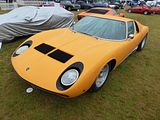
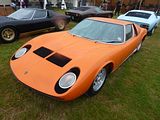
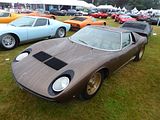
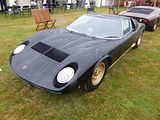
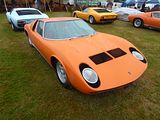
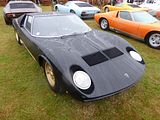
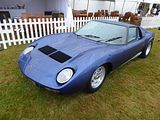
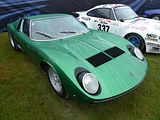
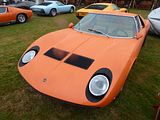
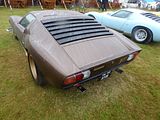
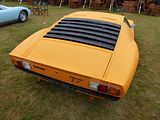


Once owned by Tony Iommi of the rock group Black Sabbath, this late model split sump Miura SV chassis 4814 is the only right hand drive example of only two finished in Azzuro Cielo. After the event Io read a report where the author declared that during the 1980s the car was owned by his boss at the dealer he worked for at the time. It took them a year to sell the car and whilst driving it to its new owner the car caught fire. It was whilst passing the Little Chef roadside restaurant on the old A23 just north of Brighton that his boss noticed the flames in the engine bay. You can just imagine the diners in the restaurant that day, enjoying their full English breakfasts knives and forks in mid-air, when into the car park roars a blue Lamborghini Miura with flames licking out of the engine bay. Suddenly a 6ft 4in somewhat rotund and sweaty motor trader comes crashing through the front door of the restaurant to grab the conveniently located fire extinguisher behind the till before rushing back outside to put the flames out. The car was delivered to its new owner a week later, by trailer.
The Miura was succeeded by the Countach, and there were a couple of these even more dramatic looking cars on display, Mike Reeves’s 1973 Lamborghini Countach LP400 Periscopio which was supplied new to Belgium with many special features such as lightweight gearbox housing. LP4000 “Periscopo” and a later 1987 Countach 5000 QV which was entered by Harry Metcalf. This was the London Motor Show car of that year.
MASERATI
This 1954 Maserati A6 GCS Berlinetta is the third of just four cars built and the only one remaining in authentic, original condition. This very car was exhibited at the 1954 Paris Motor Show and competed in the Mille Miglia in 1955. To add to its provenance, it was awarded Best of Show at the 2016 Concorso d’Eleganza, Villa D’Este. Here it came second in the “Racing Improves the Breed” class, and was selected as the People’s Choice car of the day.
MERCEDES
There was a very nice and recently restored 1957 300SL GullWing entered in the Concourse, and a number more were to be found on dealer stands.
PORSCHE
Entered in the Porsche category were three examples of the 911, as well as a 1963 356C (no photos, sadly) and a very special front-engined 924 Carrera GTP from 1980. Kevin Morfett’s 1969 Porsche 911 is the lightest factory built 911 and was the factory prototype entry for the 1970 Tour Auto which, driven by Gerard Larrousse, finished third overall. Class victory went to a 1973 genuine 2.7 RS Touring car.
One of three Porsche 924 GTPs built by the factory to compete in the 1980 Le Mans 24 hour race chassis 002 has recently undergone a thorough restoration. This car would bring back memories for lead judge Derek Bell MBE as he drove the sister car, chassis 003, during the 1980 race.
ROLLS ROYCE
This 1934 Phantom II Continental short-chassis was delivered to the coach-builder Hopper & Co Ltd, where its close-coupled All-Weather Tourer coachwork was fashioned. It was awarded 1st in its class and most elegant Phantom II at the Rolls-Royce Enthusiasts’ Club earlier this year. Here is.was declared the winner of the “Pre-War Coachwork” class.
VOISIN
This is one of two Voisin models present, both of them shipped over from California, from the world-famous collection of renowned collector, Peter Mullin. Sadly, it was the only one that was exposed to view when my camera was around, a 1925 C6 Laboratoire and is the only example in existence. Its monocoque structure was created using thin gauge aluminium sheets around a wooded frame that was reinforced with lateral steel tubes. It was nicknamed Laboratoire due to her experimental character and many technical innovations.
MANUFACTURER and DEALER DISPLAYS
Also in here were a number of trade stands for high end products as well as manufacturer and dealer displays. As well as those offering brand new cars, a number of well-known high end dealers were here as well, with several rare and exclusive models, which although not brand new are still very special and well worth seeing.
ABARTH
This is one of the events which Abarth UK still support, reflecting the fact that many owners buy an Abarth as second or additional car, to join something more exclusive. And this year they had the new models that they launched at the Geneva Show available for a UK audience to inspect. The 595 Series 4 has been available in dealerships for a few weeks now, and they are starting to appear at gatherings of Abarths as eager owners take delivery of them. Both the fixed roof and the C model were here.
Also present was the eagerly awaited 124 Spider, which is not yet available. First cars are expected within weeks. The Abarth 124 Spider has been developed in parallel with the Fiat model. It does cost a lot more, and there are those who think you don’t get enough extra for your money, but those who have driven it will tell you otherwise. You certainly get more power. The 1.4 MultiAir turbo unit jumps up from 138bhp to 168bhp, while torque also increases by a modest 10Nm to 250Nm, which gives it a 0-62mph time of 6.8 seconds, which is half a second quicker than the 2.0-litre Mazda MX-5. The top speed is 143mph. It weighs just 1060kg meaning a power-to-weight ratio of 158bhp-per-tonne, and with the new Record Monza exhaust system it sounds great even at idle, as the Abarth UK staff demonstrated many times during the evening. The Abarth version gets a stiffer suspension setup than the regular Fiat 124 Spider, with Bilstein dampers and beefed-up anti-roll bars. Bigger Brembo brakes also feature, with aluminium calipers. It can be had with a six-speed manual or six-speed automatic transmission with paddles, and the latter gets a Sport mode for quicker shifts. The car seen here was sporting the ‘Heritage Look’ pack, which is a no-cost option. It brings a matt black bonnet and bootlid, plus red exterior trim detailing and is likely to be popular. The £29,565 starting price gets you standard equipment such as cruise control, climate control, Bluetooth, a DAB radio and satnav, plus Alcantara black and red (or pure black) seat trim. The automatic gearbox is a £2,035 extra, while an optional visibility pack brings LED DRLs, auto lights and wipers and rear parking sensors. There will be more powerful versions to come, including a monstrous 300bhp Abarth 124 Rally.
ALFA ROMEO
Dating from 1964 is this rather fabulous Giulia Spider, one of a handful of original right hand drive cars, has recently emerged from a comprehensive restoration.
ASTON MARTIN
The DB11 is an important car as it is the first of a new generation of Aston models, which will see a complete refresh of the range in the next couple of years. We are promised greater visual differentiation between them, which will help the spotters. Certainly this one is easy to tell apart from the rest of the current line-up, though the new look has not received universal approbation. Those who have been lucky enough to drive the car say that it is very good, though.
BENTLEY
This was the chance to have a detailed inspection of the rather controversial new Bentayga SUV, as well as the established Continental GTC.
BMW
Representing BMW was their most futuristic product, and current top of the range, the striking looking i8 electric-hybrid sports car. I had already seen several elsewhere in the event, but this was one I could actually look at more closely.
BUGATTI
Veyron
There were also a couple of examples of the Veyron’s predecessor, the EB110, seen in SS and GT guises. Believe it or not, this car owes its origins, at least in part, to Ferruccio Lamborghini. By the mid 1980s, he was no longer involved with the marque which bears his name, but he remained interest in the world of cars, even though he was now making his money as a vintner. He still harboured a dream of once again making cars, and he managed to get introduced to Romano Artiolo, who a the time was one of Ferrari’s most successful European distributors across Germany and Italy, and who owned a number of classic Bugattis. A discussion between the two men at the 1986 about trying to revive the marque led to a scheme with the EB110 at its heart, though Lamborghini soon lost interest in the venture and his part in the Bugatti revival are largely forgotten these days. As plans were made, an array of other stars from the industry came and went. Paolo Stanzani, former Technical Director at Lamborghini did not last long as he did not get on with Artioli and his place was taken by Nicola Materazzi, who had been the project leader on the Lancia Stratos and was heavily involved with the Ferrari Testarossa, 288 GTO and F40. Marcello Gandini, by then a freelancer, was engaged to style the car. No expense was spared, with a purpose-designed state of the art factory being constructed in Campogalliano on the outskirts of Modena. The specification was equally ambitious, with early prototypes with aluminium monocoques being deemed not sufficiently rigid, so aeronautics company Aerospatiale was engaged to develop and produce the carbon fibre tub. The engine was a 3.5 litre all-alloy 60 valve V12, with four small superchargers, which meant that in the SuperSport version, there was 603bhp available. A six speed manual gearbox transmitted all those horses to all four wheels. There was a fairly conventional double wishbone suspension with twin spring/damper units, Brembo brakes and tyres specially developed by Michelin, which all helped the car to establish a production car top speed record of 212.5 mph. Artioli wanted to make ownership painless (relatively) with a three year warranty and service deal. The car was unveiled at the Place de la Defence in Paris in September 1991, on the occasion of Ettore Bugatti’s 110th birthday. Everything looked rosy. but then the world’s economies then stagnated. Artioli’s Suzuki franchise collapsed, though somehow he still had the money to buy up Lotus, but money became tight. The proposed EB112 saloon was quietly shelved, and the EB110 struggled to find buyers. It never got close to the projected 300 units per year. First deliveries were made in December 1992 and when the last car was made in September 1995, just 102 cars had been made. 102 of them were GTs and 38 Supersports. The EB110 was not a bad car, but what really sealed its fate was the McLaren F1, which is just about every respect was simply a better one. That was true back in 1994 and if you look at values of the two cars now, it is clear that the market sees it that way now. On the rare occasions that F1s come up for sale, you are going to have to pay sums in excess of £5 million, which would buy you 10 of the EB110s.
FERRARI
Current models on display included the recently released California T and 488 GTB, as well as a F12 TdF, belonging to John Collins of Talacrest fame, in a very distinctive colour scheme and a 458 MM Speciale.
There were plenty of “pre-owned” Ferrari models, with a particularly mouth-watering array of them offered by Tom Hartley, a well-known dealer in the very highest end of models. On offer were examples of cars already described elsewhere in this report: F40 and F50, and classics such as a 275 GTB and a 246 GT Dino.
Dick Lovett, based in Swindon, were also here, and a couple of the cars that they presented caught my eye. First of these was a 575M Superamerica, a convertible version of the 575M Maranello. It featured an electrochromic glass panel roof which rotated 180° (both are production car firsts) at the rear to lie flat over the boot. Patented Revocromico roof incorporates carbon fibre structure that is hinged on the single axis with a luggage compartment lid, allowing the access to the latter even with an open roof. With the roof open the rear window, apart for holding the third stop light, also acts as a wind deflector. This roof design was previously used on the 2001-designed Vola by Leonardo Fioravanti. The Superamerica used the higher-output tune of the V-12 engine, F133 G, rated at 533 hp and Ferrari marketed it as the world’s fastest convertible, with a top speed of 199 mph. The GTC handling package was optional. A total of 559 Superamericas were built; this number followed Enzo Ferrari’s philosophy that there should always be one fewer car available than what the market demanded.
Also on offer was a 360 Challenge Stradale. This was a low production track day focused car based on the 360 Modena. From a handling and braking performance perspective was the equivalent of adding a FHP (Fiorano Handling Pack) to the 360, which was available for V12 models such as the 550, 575 or F599 but never separately for the V8’s. It was inspired by the 360 Modena Challenge racing car series so the focus was primarily on improving its track lapping performance credentials by concentrating on handling, braking and weight reduction characteristics, which are essential in pure racing cars. Ferrari engineers designed the car from the outset with a goal of 20% track day use in mind and 80% road use. With only a small 20 bhp improvement in engine power from the Modena (and boasting an improved power-to-weight ratio) the Challenge Stradale accelerates from 0 to 100 km/h (62 mph) in 4.1 seconds according to Ferrari, four tenths faster than a Modena, but bald figures do not paint the full picture. For the enthusiastic driver the differences are truly staggering; genuine systematic improvements were achieved to the setup and feel of the whole car. Throttle response from the digital throttle was ratcheted up and feedback through the steering wheel was enhanced. The responsiveness of the controls, the balance of the chassis, the braking performance and the driver feedback all contribute greatly to the overall driving experience. Thanks to CCM brakes borrowed from the Enzo, some lower weight parts and a FHP handling pack, the Challenge Stradale was able to claim an impressive 3.5 seconds improvement per lap of its Fiorano circuit compared to the Modena (the target was 2.5 seconds). In total, the Challenge Stradale is up to 110 kg (243 lb) lighter than the standard Modena if all the lightweight options are specified such as deleted radio, lexan (plexiglass) door window and Alcantara fabric (instead of the leather option). As much as 74 kilograms (207 lb) was taken off on the car by lightening the bumpers, stripping the interior of its sound deadening and carbon mirrors and making the optional Modena carbon seats standard. Resin Transfer Moulding was utilised for the bumpers and skirts, a carry over from the Challenge cars which resulted in lighter bumpers than on the Modena. The engine and transmission weight was slimmed down 11 kg (24 lb) through the use of a smaller, lighter weight sports (yet still stainless steel) exhaust back box and valved exit pipes. The Challenge Stradale also got Brembo carbon ceramic brakes as standard (which later became standard fitment on the F430) which shaved 16 kg off the curb weight and improved handling by reducing unsprung weight and completely eliminating brake fade. Cars fitted with the centre console stereo option, sub speaker box behind the seats and glass side windows re-gained approximately 30 kg over the best selected options (from a weight perspective). Challenge Stradale models are much sought after these days, and when they do come up for sale, they command a huge premium over the regular 360 Modena cars.
Elsewhere. there was a further example of the F12 TdF.
GINETTA
G40
JAGUAR
Jaguar recently added an even more potent SVR model to top out their F Type range, and there was one here available for a closer look.
KOENIGSEGG
Making its European debut here was a very special Agera RS. It has been dubbed “Naraya”, a name closely associated to the owner’s family. The Naraya is essentially the same vehicle as the Agera XS, but is customised to meet the owner’s request. The body is finished in a blue-tinted carbon fibre, which has been carried over to the supercar’s carbon fibre tub – a first for Koenigsegg. As if the gorgeous shade of blue wasn’t enough, the Naraya also features an extensive amount of gold leaf on the inside and outside. The gold leaf, which was applied by hand at the automaker’s factory in Sweden by Ettore ‘Blaster’ Callegaro, a distinguished craftsman from Italy, took two weeks to apply. Callegaro worked 12-hour days, six days a week to apply the gold leaf to the glued surface and then turned it by hand using a small tool. The gold leaf was then finished in multiple clear coats to protect it from scratching. With gold leaf and blue-tinted carbon fibre on the outside, one would assume that’s enough bling for one vehicle, but it doesn’t stop there. The interior, which features blue Alcantara with gold piping and stitching, is topped off by the Naraya nameplate that’s finished in 18-carat yellow gold, along with 155 cultured diamonds. Power still comes from a 5.0-litre twin-turbo V8 that generates 1,160 bhp and 944 lb/ft of torque. The supercar also features all of Koenigsegg’s creature comforts including a front and rear hydraulic lifting system, USB port, climate control, and more. The blue and gold supercar will line up next to two other special Koenigseggs including a One:1 that recently set a VMax200 speed record at Bruntingthorpe for travelling 240 mph and the very last Agera R ever made.
LAMBORGHINI
Making its UK public debut here was the Lamborghini Centenario Coupe. Created to mark what would have been Ferruccio Lamborghini’s 100th birthday, only 20 examples will be built, along with 20 roadster versions. The Centenario features the most powerful V12 engine in the firm’s history and can sprint to 62mph in just 2.8 seconds.
Also on show were examples of Lamborghini models you could actually buy, the current Aventador and Huracan.
LEXUS
Due to go on sale sometime in the middle of next year, is the new LC500, a grant tourer than Lexus premiered at the Geneva Show earlier in the year. Sitting above the RC Coupe models in the range, this one takes aim at the BMW 6 Series. Visually, you will either love it, or hate it, but the real test will be what it is like to drive, as if Lexus can crack that, then the other attributes of an impeccably quality interior and an ownership experience second to none should stand it in very good stead. We shall see.
McLAREN
Looking almost lonely at times, was the event’s second example of the P1. Proof that the market for these cars has a finite duration before people’s interest moves elsewhere. The one in the Supercar display had been attracting far more interest, of course, but that can largely be explained by the different demographic of attendee here compared to the other part of the event – a lot of youngsters and car fans for the Supercars, as opposed to more likely purchasers in this part of the event.
MORGAN
The Morgan 1909 Edition EV3, produced in association with Selfridges, was making its global debut here. Just 19 of these bespoke electric three-wheelers will be available, each one fitted with a bespoke driving kit from Alexander McQueen, Dents and Belstaff. Launched in conjunction with Selfridges, the name signifies the birth years of both brands.
Also on display were the cars in the current range.
NOBLE
Noble first showed the M600 model in 2010. Intended to be a true rival to the likes of Ferrari, the M600 was a big jump up in terms of price from previous Nobles. It has a Volvo twin-turbocharged V8 engine producing 650 bhp, a carbon fibre body shell, and a 6-speed gear box, made by Yamaha, pitting itself directly against the V8 engined Ferrari models. This 2,800-pound (1,300 kg) M600 can accelerate from 0–100 km/h in 3.5 seconds and requires only another 4 seconds to achieve 100 mph (160 km/h). It has over 1G of grip on the skid pad. The brake discs in the Noble M600 are steel. The Noble comes with no ABS or ASM and TC all these features being optional. The car was received to some very positive reviews, impressing all who drove it. As you so rarely see one, there was much intrigue as to how many were actually being built. Noble had said that there would be no more than 50 a year, but it was strongly suspected that only a handful had ever been made. There was something of a surprise when an open-topped version appeared at the Geneva Show earlier this year, with no warning, and very little was said about it, even though it starred on the stand there. And there was one here, in a different colour to that show car.
OVERFINCH
OverFinch is one of a number of after-market specialists who modify the products of Land Rover, and there were a couple of examples of their art here, based on the current Range Rover and Range Rover Sport. The latter was making it debut at the event. Called the Range Rover Supersport, just 25 examples of the reworked Range Rover will be created, each aimed at reducing the weight and increasing the performance of the standard car. Based on the Range Rover Sport SVR, the Supersport cuts weight through new wheels, a carbonfibre bonnet, and titanium exhaust. Despite being 22 inches in diameter, the ‘Leggero’ forged monoblock alloy wheels save 5.5kg apiece compared with the standard rims. At half an inch wider, they also offer the option of upgrading to wider tyres, to the benefit of grip. A carbonfibre bonnet saves an additional 5kg – a 33 per cent saving – and the new Overfinch titanium exhaust system, at 14.81kg, is 11kg lighter than the standard system, or 43 per cent less. It should also contribute small performance gains on the existing 5-litre supercharged V8, with 60 per cent lower back pressure. There’s a new air filter housing and secondary intake, for further airflow gains. No figures are claimed, but in an SUV that already thunders to 60mph in 4.5sec courtesy of a 542bhp output, tangible differences might be difficult to identify. The rest of Overfinch’s upgrades are cosmetic. Inside there are redesigned seats trimmed in Bridge of Weir leather and featuring a carbonfibre-style finish, and a power bulge on the new carbonfibre bonnet is left exposed to better appreciate the material’s use. The familiar weave can also be found surrounding the new enlarged air intakes, low on the front splitter, across the wheel arch spats, and along the rear valance. All of the above were developed in conjunction with Prodrive, so should be more than mere tinsel. Pricing, as you might expect, is significant. Regular SVRs start at £95,150, but the Overfinich version lifts that to £179,990. The special launch edition version, with ‘Ariana grey’ paintwork and satin-finish carbonfibre accents, clocks in at £198,990.
POLARIS
Having seen a Slingshot in the reserved parking area, here was the chance to see another one.
PORSCHE
There were examples of three of Porsche’s most extreme hypercars, showing the evolution of the genre. Oldest of these was a 911 GT1. With the revival of international sportscar racing in the mid-1990s, though the BPR Global GT Series (which then morphed into the FIA GT Championship) Porsche expressed interest in returning to top level sportscar racing and went about developing its competitor for the GT1 category. Cars in this category were previously heavily modified versions of road cars, usually supercars such as the McLaren F1 and Ferrari F40, but when the 911 GT1 was unveiled in 1996 Porsche had exploited the rule book to the full and stunned the sportscar fraternity. Rather than develop a race version of one of their road going models, what they created was effectively a purpose built sports-prototype, but in order to comply with regulations a street legal version was created, 911 GT1 Straßenversion – literally a road-going racing car. In spite of its 911 moniker the car actually had very little in common with the 911 of the time, however its frontal chassis was shared with the then 911, the 993, while the rear of the car was derived from the Porsche 962, including its water-cooled, twin-turbocharged and intercooled, four valve per cylinder flat-six engine which was arranged in a mid-mounted position, compared to the rear-engined layout of a conventional 911. The engine was making about 600 PS. In comparison, the 993 generation 911 GT2, which was otherwise the company’s highest-performance vehicle, used an air-cooled engine with only two valves per cylinder. The new vehicle was an outright success at Le Mans, winning the GT1 class at its debut race, although it lost the overall victory to Joest Racing’s Porsche WSC-95 prototype, still a success in that this vehicle used a Porsche powerplant. The 911 GT1 made its debut in the BPR Global GT Series (the FIA championship’s predecessor) at the Brands Hatch 4 hours, where Hans-Joachim Stuck and Thierry Boutsen won comfortably, although they were racing as an invited entry and were thus ineligible for points. They followed up by winning at Spa and Ralf Kelleners and Emmanuel Collard triumphed for the factory team at Zhuhai. The ’96 GT1 had around 600 PS and was clocked at a top speed of exactly 330 km/h (205 mph) on the legendary Mulsanne Straight in the practice sessions of the 1996 Le Mans 24 Hours Race (presumably on a low downforce setup). In 1997, the new Mercedes-Benz CLK-GTR was successful in the new FIA GT Championship that replaced the BPR, as it was developed for racing. Mercedes did not enter Le Mans yet with their new car, though. The Porsche did not prove to be as fast in the FIA series, and failed to win a single race, first against the McLaren F1 GTR, and then against the new CLK-GTR. Towards the end of the 1996 season Porsche made revisions to the 911 GT1 in preparation for the 1997 season. The front end of the car was revised including new bodywork which featured headlamps that previewed the all-new 2nd generation (996) Porsche 911 which would appear in 1997. The revised car was known as the 911 GT1 Evo (or Evolution). The car had the same 600 PS turbo-charged engine, but new aerodynamics on the car allowed the ’97 car to be considerably faster than the 1996 model – acceleration was better, although the top speed was still around 330 km/h on the La Sarthe Circuit (in the race, the GT1-Evo reached 326 km/h). However, the works cars suffered from reliability problems and did not last the full race distance; a privately entered 1996 specification GT1 managed 5th overall and third in its class, but was beaten by the BMW-backed and powered McLaren F1 GTRs.
Successor to this car, conceptually, was the Carrera GT, and there was another one here, to complement the one seen in the Great Court.
And more recently, of course, these has been the 918 Spider.
There was also a 911R here. Unveiled at the 2016 Geneva Motor Show on March 1, the 911 R shares most of its underpinnings with the GT3 RS, but does not include the roll cage, rear wing, and associated bodywork for a weight saving of 50 kg (110 lb). The 911 R comes only with a 6-speed manual transmission, and has a top speed of 323 km/h (201 mph) due to a lower drag coefficient as compared to the GT3 RS. It also offers additional options including a lighter flywheel and removal of the air conditioning and audio systems. Production was limited to 991 examples, and it was sold out even before the public launch.
SPYKER
This is a Spyker C8, the sort of car that you see, or rather used to see, at major international motor shows, and always wondered if they ever actually sold cars to real end customers, and then just occasionally you see one “in the wild”. persuading you to believe that indeed a handful were made and sold. Certainly, I’ve only ever seen a couple “in the wild”. Spyker Cars is a Dutch sports car marque. The company’s motto is “Nulla tenaci invia est via”, which is Latin for “For the tenacious, no road is impassable”. The marque’s logo displays the rotary engine of an airplane, a reference to the historic Spyker company which manufactured aircraft. The reborn company, Spyker Cars, which owns the brand name, was founded by Victor Muller and Maarten de Bruijn in 1999, and since 2000, Spyker has been building exclusive sports cars like the C8 Spyder and the C8 Laviolette (with its elegant glass roof). Spyker’s history of producing aero engines is reflected in details in these new cars as well as in the logo. Before building the C8, de Bruijn had been building small numbers of the Spyker Silvestris, which in many ways foreshadows Spyker’s later cars. The C8 Laviolette and C8 Spyder have a 4172 cc Audi V8 engine delivering 400 bhp, giving acceleration 0–60 mph in 4.5 seconds and a top speed of 300 km/h (190 mph). On July 14, 2005, it was announced that the C8 was approved for sale on the United States market. Between 2002 and 2006, Spyker built the C8 Double 12 S, which was available from the factory with 5 different levels of performance called Stage I (400 h.p.) through Stage V (620 h.p.), depending on the customer’s need for performance. Between 2003 and 2007, Spyker built the C8 Spyder T, with the Twin turbo being developed in conjunction with Cosworth. These engines were capable of 525 h.p. and acceleration times of 4.0 seconds. In 2005, the head designer and founder, Maarten de Bruijn, left the company, and founded Silvestris Aquamotive which builds aluminium space frame speed boats. On May 27, 2004, Spyker Cars listed on the Euronext Amsterdam Stock Exchange at €15.50, falling to a low of €8.28 in April 2005. The stock rebounded sharply in early 2006 to over €22 per share. Early in 2007 the stock showed a sharp decline to levels beneath €13 because of financing issues. As a result, several stock issues were announced to big investors. Notably, all shares have been sold at higher prices than the market price at the moment of announcement On November 13, 2005, Spyker Cars and Mubadala Development Company, a principal investment company wholly owned by the government of the United Arab Emirates, announced their strategic alliance, with Mubadala acquiring 17% of Spyker. Mubadala has a strong relationship with sports cars, also controlling 5% of Ferrari. In 2006, Spyker built the C12 La Turbie with an V12 engine capable of 500 horsepower and acceleration from 0–60 mph in less than 4 seconds. In September 2006, Spyker bought out the Midland F1 team. The team competed in the final 3 races of the 2006 season as Spyker MF1. In the 2007, the team competed as Spyker F1 using engines supplied by Ferrari. Driver Adrian Sutil was paired with Christijan Albers until the European Grand Prix where the latter was replaced by reserve driver Markus Winkelhock; the team then signed Sakon Yamamoto to fill in the slot for the rest of the year. The team itself had minimal success, suffering from multiple retirements (including double retirements in Malaysia, Canada and Brazil) before Sutil scored the team’s first and only point in Japan. At the end of the season, the team was sold to a consortium named “Orange India” led by Vijay Mallya and was subsequently renamed as Force India. In 2007, Spyker, in collaboration with the Italian car-design firm Zagato, produced the C12 Zagato, based on the C12 La Turbie, but with more appealing body work, faster speeds, and the Zagato trademark roof bubbles. This is perhaps the more exclusive Spyker car to date. In November 2009, Spyker announced that it would be moving production from Zeewolde to Whitley, Coventry, where assembly would be done in partnership with CPP Manufacturing UK production began in February 2010. On 26 January 2010, General Motors confirmed that Spyker and GM had come to an agreement allowing Spyker to purchase Saab Automobile, subject to regulatory and government approval; the sale was completed on February 23, 2010. General Motors would continue to supply Saab with engines, transmissions and also completed vehicles in the shape of the new Saab 9-4x from GM’s Mexican factory. The deal included a loan from the European Investment Bank, guaranteed by the Swedish government. It comprised US$74m in cash up front, payable to GM by July 2010, and shares in Spyker to the tune of US$320m. On February 23, 2010, Spyker Cars closed the deal to buy Saab Automobile from General Motors. Spyker and Saab would operate under the parent company Swedish Automobile, named Spyker Cars N.V. Saab Automobile quickly ran out of money and Spyker was unable to fund the losses. The companies stopped paying their bills early 2011. On March 30, 2011, production was halted at Saab Automobile, because suppliers refused to deliver without payment. Spyker CEO Victor Muller made several attempts at acquiring funding. A joint venture with Chinese company Hawtai was announced on May 3, 2011, only to fall apart a week later. Shortly afterwards joint ventures with Chinese car maker Youngman, and Chinese car-dealership chain Pang Da were announced. Negotiations ended with Spyker attempting to sell all of the shares in Saab Automobile to the Chinese companies on October 28, 2011, for 100 million euros. This transaction did not have the approval of former Saab-owner General Motors, who refused to supply technological licenses to Youngman and Pang Da. The proposed deal fell apart. Spyker CEO Victor Muller applied for the bankruptcy of Saab Automobile on December 19, 2011. In February 2011, it was announced that Swedish Automobile agreed to sell its sports-car unit to Vladimir Antonov. Antonov, a former Spyker chairman and shareholder, and was expected to pay 15 million euros for the company. However, in March 2011, the deal fell through, with Spyker’s manufacturing partner CPP Manufacturing placing a bid, but this deal fell through later that month. In September 2011, it was announced that Swedish Automobile would sell Spyker Cars, in an all-cash offer to an American private equity and hedge fund North Street Capital, for €32 million. In January 2012, Swedish Automobile again offered Spyker cars up for sale, but this sale did not actually occur. In August 2012, Spyker announced that Youngman Ltd. had acquired a 29.9% stake in its parent company Spyker N.V. for €10 million. In March 2013, the B6 Venator was unveiled at the Geneva Motor Show, the B6 Venator was noted as Spyker’s first concept car in nearly four years. On September 16, 2013, Spyker Cars’ parent Spyker N.V. lost its listing on Euronext Amsterdam after failing to undergo a restructuring agreement. On November 5, 2014, the Dutch Court “Midden Nederland” ordered Spyker to leave, within seven days, the factory they rented and to pay 152.000 euro in overdue rent. The claim was made by Jacques Walch, the owner of the factory rented by Spyker. Despite this, CEO Victor Muller insisted the company would be able to pay its bills “in a matter of days.”On 2 December 2014 Spyker NV was granted a moratorium of payment (financial restructuring) by the Dutch court “Midden Nederland”. Spyker needed protection from creditors for its liquidity problems. Victor R. Muller, Spyker founder and chief executive, said “Over the past few years, Spyker has faced a number of serious difficulties and challenges resulting from, among others, the legacy of the F1 era and the acquisition of Saab Automobile AB.” On 18 December 2014 Spyker NV was declared bankrupt by the Dutch court “Midden Nederland”. Victor R. Muller, Spyker’s founder and chief executive, said “In 2000 our objective was to found a global sports car manufacturer, and we did just that. During this time we deployed several challenging activities. These have affected the company, and contributed to our decline,”. Spyker appealed the bankruptcy declaration, and on 29 January 2015, the court reversed the declaration. This meant that Spyker NV was protected from creditors, while solving its financial difficulties. This allowed Muller to pursue plans to merge Spyker with an unnamed “US based manufacturer of high performance electric aircraft.” This proposed merger partner was eventually discovered to be a company called Volta Volare. On May 13 of that year, Spyker NV closed a deal with the creditors. Spyker owed 44 million euro and agreed to pay 12.000 euro per creditor. The curator of Saab GB was the largest creditor; it claimed 24,9 million euro. Saab GB agreed to receive a payment of 61.000 euro] A following attempt by the Latvian bank Lizings to claim more money, was declined by the court.SO, a difficult time over many years. But here was evidence that a few cars were indeed produced. It is believed that about 290 were made in total, with over 90 produced in 2006 alone. The C8 Spyder, as seen here, was the original base model with an Audi 4.2 litre V8 engine. Since the start of its production in 2000, twelve different variants have been sold. A long wheelbase version was presented at the 2008 Geneva Motor Show, called the C8 Aileron. A year later, a convertible version was presented. Horsepower ranged from 400 for the original C8 Spyder to 620 for the C8 Double 12S.
TESLA
Production of the Model X is now underway, after the same sort of long wait between unveiling and first availability that seems to epitomise Tesla, and I saw several of these when on vacation in California back in March. Even there, this vehicle looks big. It is bulky in every dimension, and those gull wing doors may be interesting, but it remains to be seen just how practical they will be in Europe. We’re going to have to wait a while longer to find out, as the current estimate is that right hand drive versions will not arrive in the UK until the first quarter of 2017. The car on show here was certainly generating plenty of interest.
The established Model S was also available for a closer look.
It’s such a pity that the capricious British weather challenged this event. Priceless classics and rain just don’t mix, and it is no surprise that several of the cars which should have been the highlight of the day had to be covered up. That notwithstanding, I did enjoy this event. For sure, it was a very expensive day out, as it had been in 2015, indeed the most costly UK event of the entire year, again, but there was enough to keep me entertained for the whole day, there were plenty of cars that you would be unlikely to see elsewhere, a marvellous setting, and the afternoon tea was delicious. I will have to see how the 2017 tickets are presented and priced, but assuming there is a similar deal to this one, it will be a tempting proposition once again.


